STYLE IN TRAVEL


MAIDEN VOYAGE







 Showroom London, Che LS e a h arb our de S i gn C en tre m i L an / Pari S / r ome / Canne S / Co L og ne
Showroom London, Che LS e a h arb our de S i gn C en tre m i L an / Pari S / r ome / Canne S / Co L og ne
















 Showroom London, Che LS e a h arb our de S i gn C en tre m i L an / Pari S / r ome / Canne S / Co L og ne
Showroom London, Che LS e a h arb our de S i gn C en tre m i L an / Pari S / r ome / Canne S / Co L og ne






Choose from our 100% Cradle to Cradle Certified® range of marine carpets

At Ege Carpets, circularity is built into both our minds and our carpets. We’ve been working intensely with sustainability since 1996 and today we’re proud to have an EcoVadis platinum rating which is equal to a top 1% position among the 90,000 rated companies. Not only that, we’re the only carpet manufacturer to offer a 100% Cradle to Cradle Certified® selection of carpets.
2021

Previously known as Hammer Carpets, we’ve been working with leading cruise developers for more than three decades.
We offer:
• IMO, Cradle to Cradle® and Indoor Air Comfort Gold certified carpets
• 100% custom designed carpets in wool for greater comfort and soft luxury
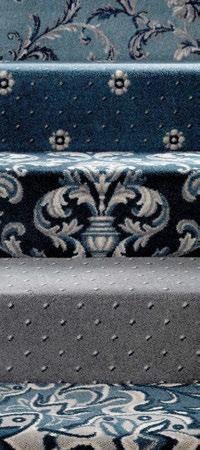
• Light weight carpets with integrated underlay in customised widths

Carpet: Colortec 80/20, pre-dyed wool, custom design


sustainable design at your feet

Travel of any kind gets a bad rap for its polluting ways, and the events of recent years in particular have caused many of us to think twice about hopping on fuelguzzling transport to get from A to B, whether it’s a short drive across the city or a long-haul flight to another continent.
Though there’s no denying the impact of 21st-century life on the planet, environmental concern often gives way to wanderlust, or simply time and convenience, so what can be done to make environmentally friendly transport options more appealing to the masses?
Some nations are introducing measures to initiate change; this summer, Germany slashed rail fares by 90% to encourage its citizens to ditch the car in favour of taking public transport, while France has gone so far as to ban domestic flights for journeys that can be made within 2.5 hours by train. But the real innovation is coming from those who are taking preventative measures rather than trying to counter the effects – the developers and designers creating solutions that not only reduce carbon footprint, but reach carbon neutrality.
Since Starboard launched in 2018, the number of concepts we see that speak of greener practices has rocketed, from the first LNG-powered cruise ship to a fleet of all-electric cars plus net zero pledges from the aviation sector. This issue features car interiors padded with bamboo viscose and a mobile hotel clad in photovoltaic solar panels; there’s even an off-grid cabin in which every element – from the lights to the kettle – is powered by car.

But it’s not just manufacturers and mechanical engineers who are at the forefront; the makers of materials, surfaces,
fixtures and fittings are coming up with products that are sustainable or made from recycled content, and interior designers are actively specifying them owing to increased demand from consumers.
The F&B sector is doing its bit too. Onboard chefs are committing to sourcing locally in port, menus champion authenticity and sustainability, and airlines are introducing pre-orders to eliminate food waste. Emirates Flight Catering in particular is leading the charge, having partnered with Crop One Holdings to open Bustanica, the world’s largest hydroponic farm, which will grow organic greens and supply to over 100 airlines.
There are innovations across all transport sectors – on water, on land and in the air – but what’s needed is a joinedup approach to enable environmentally conscious travellers to measure the impact of their entire journey. Such an approach begins with the design community. As this issue of Starboard launches, the inaugural Sustainable Design Summit – a new event that brings together the cruise, hotel and aircraft sectors to find sustainable solutions for interiors – is taking place in London. It marks the first step to cross-sector learning and will hopefully pave the way for a greener path. Welcome to the new issue of Starboard. I hope you enjoy the journey.
Catherine Martin • Managing EditorEDITORIAL
DESIGN
FINANCE
Editor-in-Chief
Matt Turner m.turner@mondiale.co.uk
Managing Editor
Catherine Martin c.martin@mondiale.co.uk
Assistant Editor
Ben Thomas b.thomas@mondiale.co.uk
Editorial Assistant Eleanor Howard e.howard@mondiale.co.uk
F&B Contributor
Shanna McGoldrick s.mcgoldrick@mondiale.co.uk
ADVERTISING
Business Development (FF&E)
Rob Hart r.hart@mondiale.co.uk
Business Development (FF&E)
Charlotte Gowing c.gowing@mondiale.co.uk
Business Development (OS&E)
Rachel Chadwick r.chadwick@mondiale.co.uk
Design Manager
David Bell d.bell@mondiale.co.uk
EVENTS & MARKETING
Commercial Lead
Kirsty Studholme k.studholme@mondiale.co.uk
Event Manager
Vicky Cruse v.cruse@mondiale.co.uk
Content & Research
Olivia Mavers o.mavers@mondiale.co.uk
Data & Marketing Lauren Blain l.blain@mondiale.co.uk
Subscriptions enquiry@sleeper.media
Finance Director
Amanda Giles a.giles@mondiale.co.uk
Group Financial Controller
Sarah Healey s.healey@mondiale.co.uk
Group Credit Controller
Lynette Levi l.levi@mondiale.co.uk
Accounts Assistant Kerry Mountney k.mountney@mondiale.co.uk
CORPORATE
Chairman
Damian Walsh
To subscribe to Starboard or other magazines in the portfolio, visit: www.sleeper.media
Starboard Issue 8 • Published November 2022
Annual subscription (2 issues): £36.00
Subscription records maintained at Sleeper Media
Mailed by Spatial Global • Printed by Buxton Press
Strawberry Studios Stockport, SK1 3AZ, UK Tel: +44 (0)161 476 8390 www.sleepermagazine.com


Global hospitality group Four Seasons has announced its entry into the cruise sector, partnering with Nadim Ashi and Philip Levine of Marc-Henry Cruise Holdings to launch Four Seasons Yachts.
The first of the fleet is currently under construction at Fincantieri, and is expected to set sail in late 2025. Taking the role of lead architect, Tillberg Design of Sweden (TDoS) is responsible for the exterior and guest suites, while Martin Brudnizki is envisioning the public areas, and Prosper Assouline will provide creative direction.
The inaugural vessel will comprise 95 villalike accommodations, each featuring floor-toceiling windows and access to terrace decks. Its most expansive residence, the Funnel Suite, will be spread across four levels and include a private wading pool and dedicated spa area.
Restaurants, lounges and bars on board will celebrate the hallmarks of the Four Seasons brand, while the wellness offer includes a full-service spa and salon. Furthermore, the canoe-shaped aft will be home to an expansive pool deck, which can be transformed into an outdoor cinema.
“Four Seasons Yachts represents the next chapter of our long history of industry-leading innovation, and a milestone moment for our company as we continue to capitalise on new opportunities to extend the world of Four Seasons,” says Christian Clerc, President, Four Seasons Hotels & Resorts. “True vision rests in the ability to imagine the possibilities while always remaining loyal to one’s values. Our vision for this new venture does exactly that. We are creating something extraordinary that combines their expertise with what Four Seasons does best – delivering unmatched quality and excellence, surrounded by beautiful acts of service and love for our guests.”
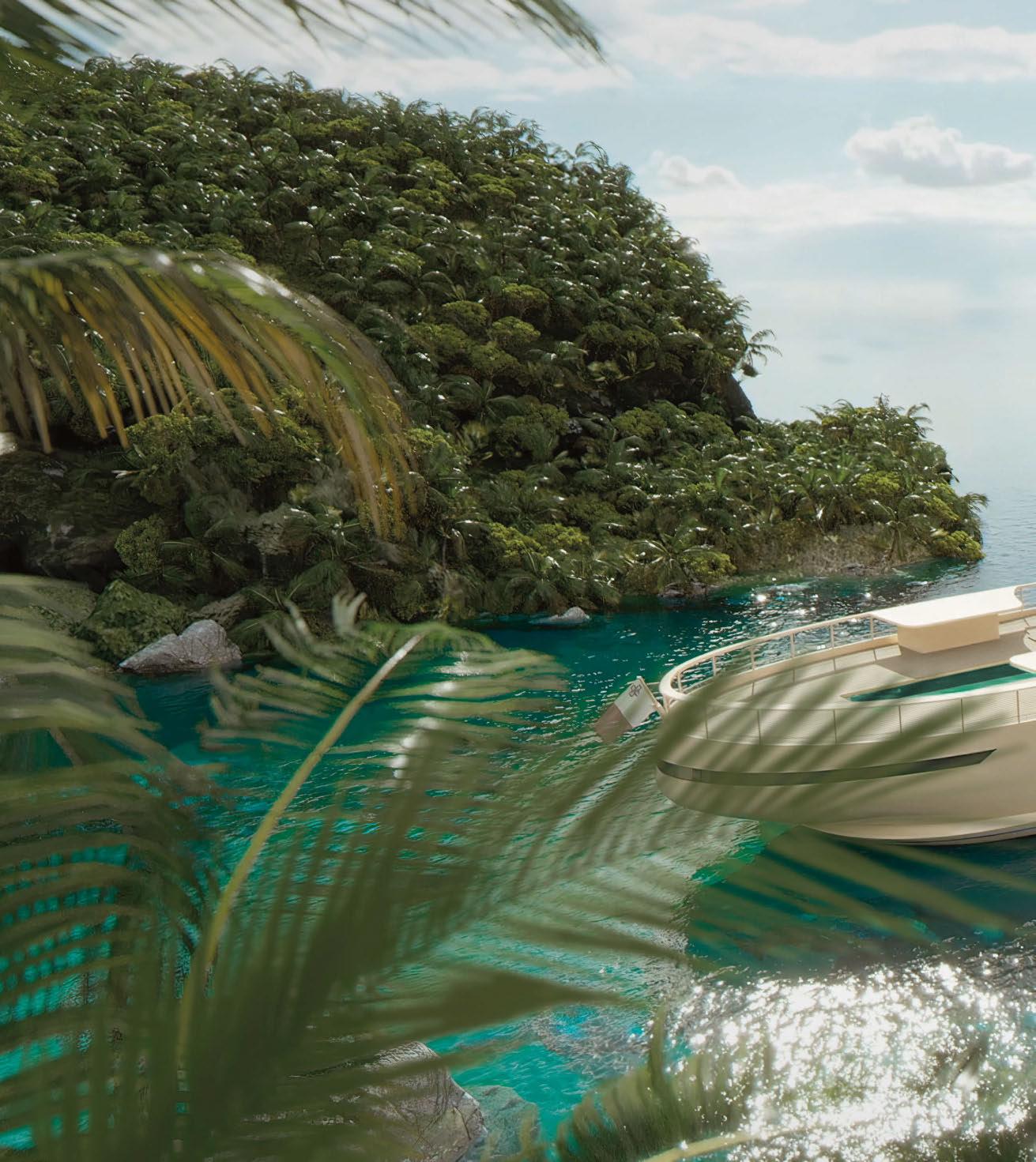 Four Seasons Yachts FOUR
Four Seasons Yachts FOUR
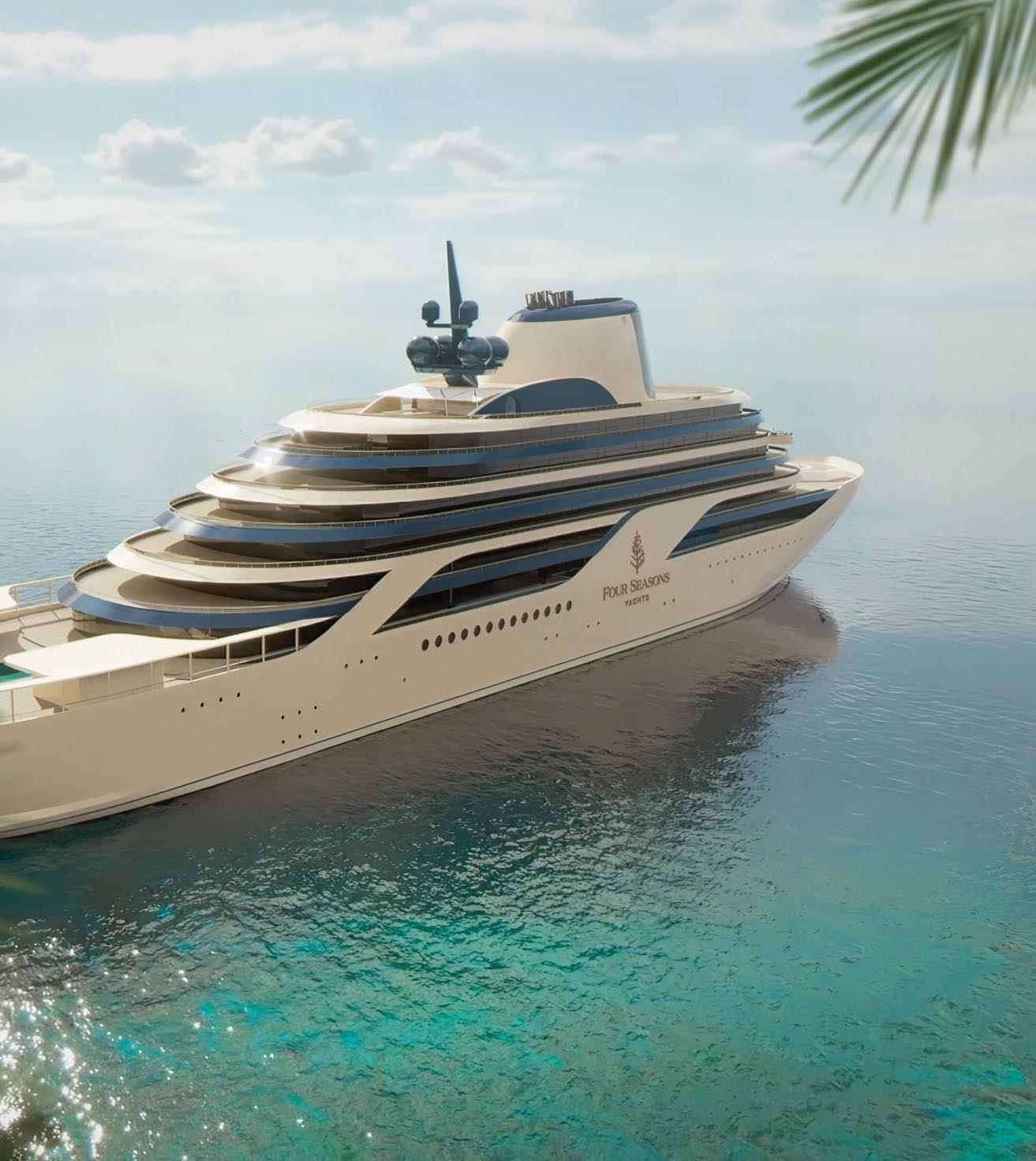
Route: Europe
Maiden Voyage: May 2023
Owner: MSC Group
Operator: Explora Journeys
Architecture: Martin Francis
Interior Design: SMC Design, AD Associates, De Jorio Luxury, Yacht Projects
Shipyard: Fincantieri www.explorajourneys.com
In the latest of a series of reveals, Explora Journeys has unveiled the F&B offering aboard its debut vessel, which will set sail in May 2023. Comprising a total of 18 venues, the culinary experience will be made up of six restaurants along with 12 bars and lounges – eight indoor and four outdoor – and a chef’s kitchen.
“Explora Journeys isn’t just an opportunity to travel the world, we also see it as a way for our guests to taste it, actively discovering new cuisines,” says Head of Culinary Franck Garanger. “Our team bring enthusiasm for provenance along with stories about the rare ingredients, which are hand-selected for our brand. By delivering refined dining experiences that embrace authenticity and sustainability, we will ensure that each guest leaves with memories of their culinary journey onboard.”
Restaurants include Sakura, an immersive dining experience serving the finest Pan-Asian cuisine; Marble & Co Grill, a redefined European
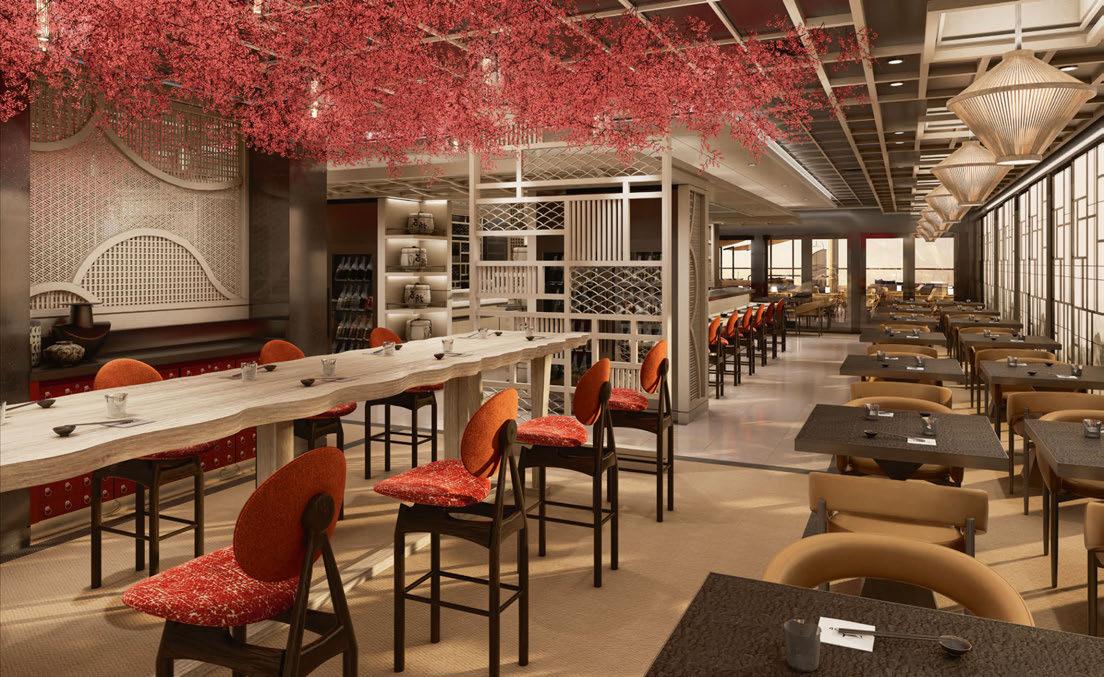
steakhouse; and Emporium Marketplace, an allday dining venue with a focus on quality produce inspired by local destinations. There’s also the Malt Whiskey Bar and the Astern Lounge - the social hub of the journey. As with the cuisine, the drinks programme takes cues from the locations to which the ship sails. Sommeliers will source boutique wine labels to build an inspiring menu, while signature cocktails include Ocean State of Mind, which reflects the brand’s philosophy. To add to the experience, guests can participate in spirit tastings, cocktail-making masterclasses and wine-themed events.
Thibaut Briançon, Senior Lead for Food & Beverage Services, comments: “A key element of differentiation is our passion for handselecting and sourcing an eclectic beverage mix, including rare fine wines direct from vineyards and premium brands. This will ensure that our mixologists and sommeliers can provide unique experiences for our discerning travellers.”


Royal Caribbean has revealed the first look at its highly anticipated Icon of the Seas, which will make its maiden voyage in early 2024.
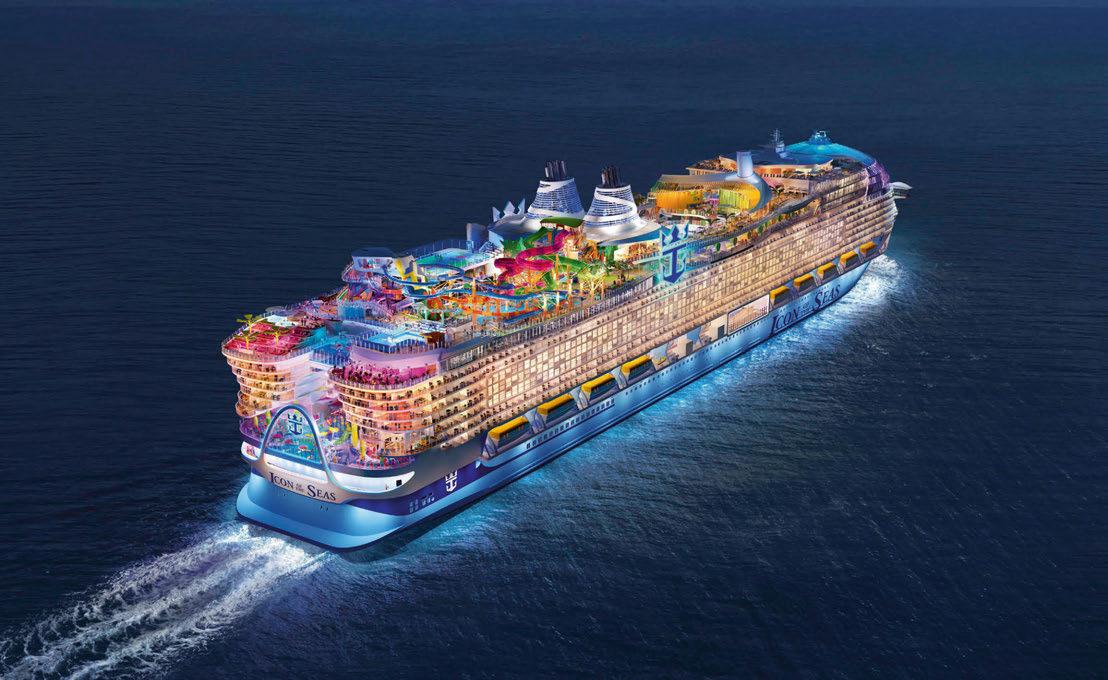
Across its 20 decks, the family-focused vessel will accommodate 5,610 guests in 2,805 staterooms, while public areas – split into eight neighbourhoods – will include more than 40 F&B options, seven swimming pools and nine whirlpools, and the largest waterpark at sea.
Amongst the 28 room types will be new layouts for families of three, four, five and more, such as the three-storey Ultimate Family Townhouse with its own white picket fence and mailbox, and the brand’s new Sunset Corner Suites with their panoramic ocean views.
know and love,” says Jason Liberty, President and CEO at Royal Caribbean Group. “From the moment they step on board, every experience is specifically designed to give them the best vacation anywhere on land and at sea. With Icon of the Seas, we’ve taken this to a new level and made the ultimate family vacation.”
Maiden Voyage: January 2024
Owner: Royal Caribbean Group
Operator: Royal Caribbean International Shipyard: Meyer Werft www.royalcaribbean.com
Icon will also be home to a series of cruising firsts, from the first suspended infinity pool at sea to the first swim-up bar, free-fall slide, family raft slides and mat-racing duo.
“With each new ship, we raise the bar in the travel industry while enhancing what our guests
Michael Bayley, President and CEO at Royal Caribbean International, adds: “Icon of the Seas is the culmination of more than 50 years of delivering memorable experiences and our next bold commitment to those who love to vacation. Now more than ever, families and friends are prioritising experiences where they can bond and enjoy their own adventures. We set out to create a vacation that makes all that possible in one place for the thrill-seekers, the chill enthusiasts and everyone in between, without compromise. It’s this first-of-itskind combination that makes Icon the future of family vacations, and that future is here.”
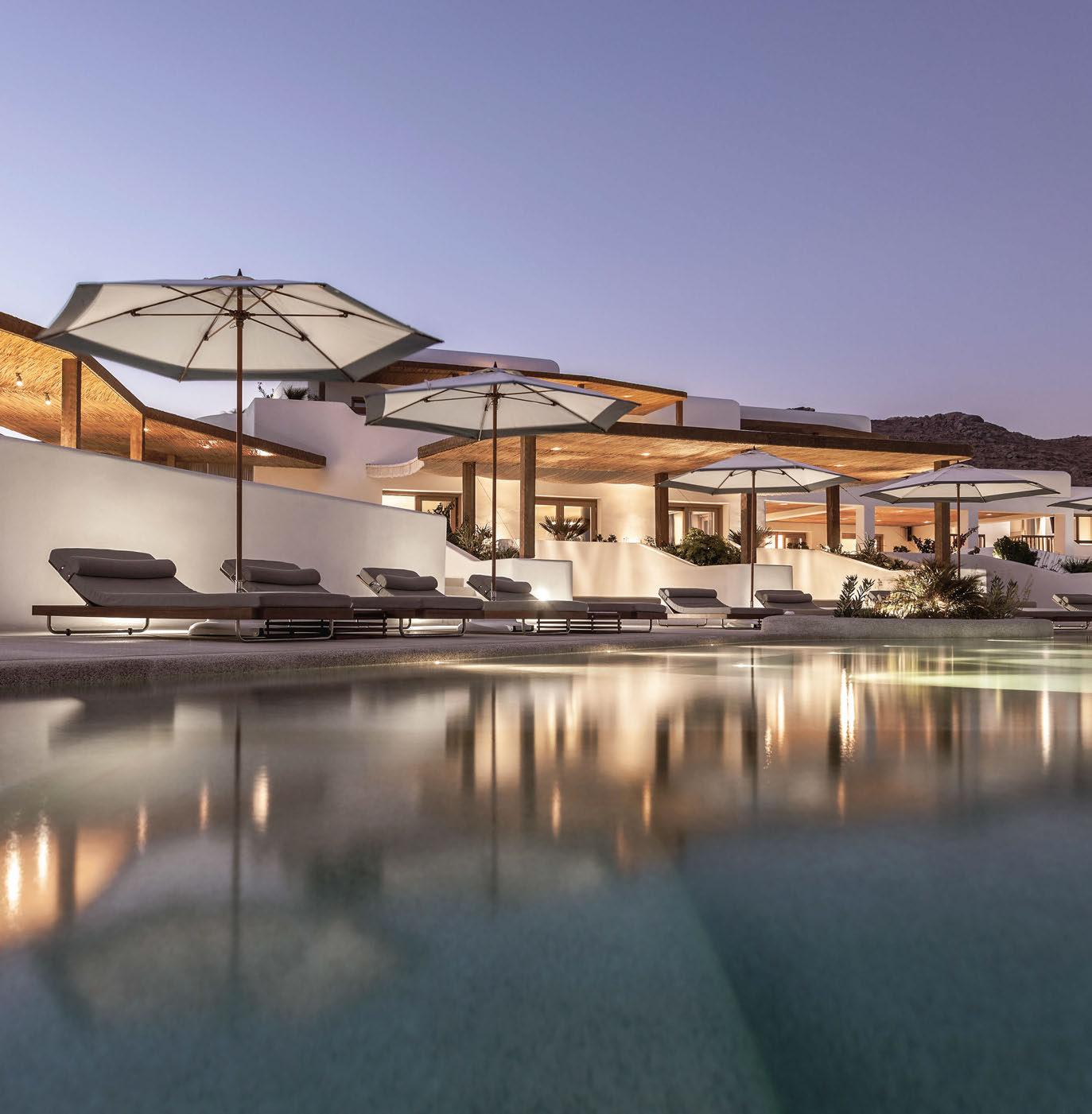
ON DECK
Route: Mediterranean
Maiden Voyage: 2024
Owner: Carnival Corporation
Operator: Princess Cruise Lines
Architecture: Tillberg Design of Sweden (TDoS)
Shipyard: Fincantieri www.princess.com
Princess Cruises has appointed Tillberg Design of Sweden (TDoS) as the coordinating architects for a new generation of Sphere-class ships, starting with Sun Princess due to debut in 2024.
Accommodating more than 4,000 guests, the 175,500-tonne vessel is the cruise line’s largest to-date and marks the third ship to carry the Sun Princess name. Whilst remaining true to the smooth clean lines and design aesthetics of its predecessor, designed by the late Robert Tillberg, the new 21-deck vessel features a lighter and brighter décor that maximises outdoor living.
Sun Princess embraces Italian heritage with the brand’s signature Piazza, which spans three floors and is equipped with a large LED screen that can be configured to deliver live entertainment programming.
The Dome meanwhile is a glass-enclosed venue with a multi-level deck inspired by the terraces of Santorini. By day, it features

an indoor/outdoor swimming pool and water feature; by night it transforms into an entertainment space with state-of-the-art lighting and aerial performances.
With the launch of Sun Princess comes newly appointed suites and staterooms too, each featuring more outdoor balcony space. There is also a new category of suite, known as the Signature Collection, which offers access to a private restaurant, lounge and sundeck.
“Sun Princess is a new and bespoke ship platform, designed to simultaneously embrace Princess heritage while boldly pressing into the future with iconic, elegant and pure lines unique to our brand,” comments John Padgett, President of Princess Cruises. “A show-stopping, first-ofits-kind Dome on the top deck and suspended glass Piazza in the center of Sun Princess offer innovative designs showcasing expansive ocean views for incredible opportunities to connect with the sea.”
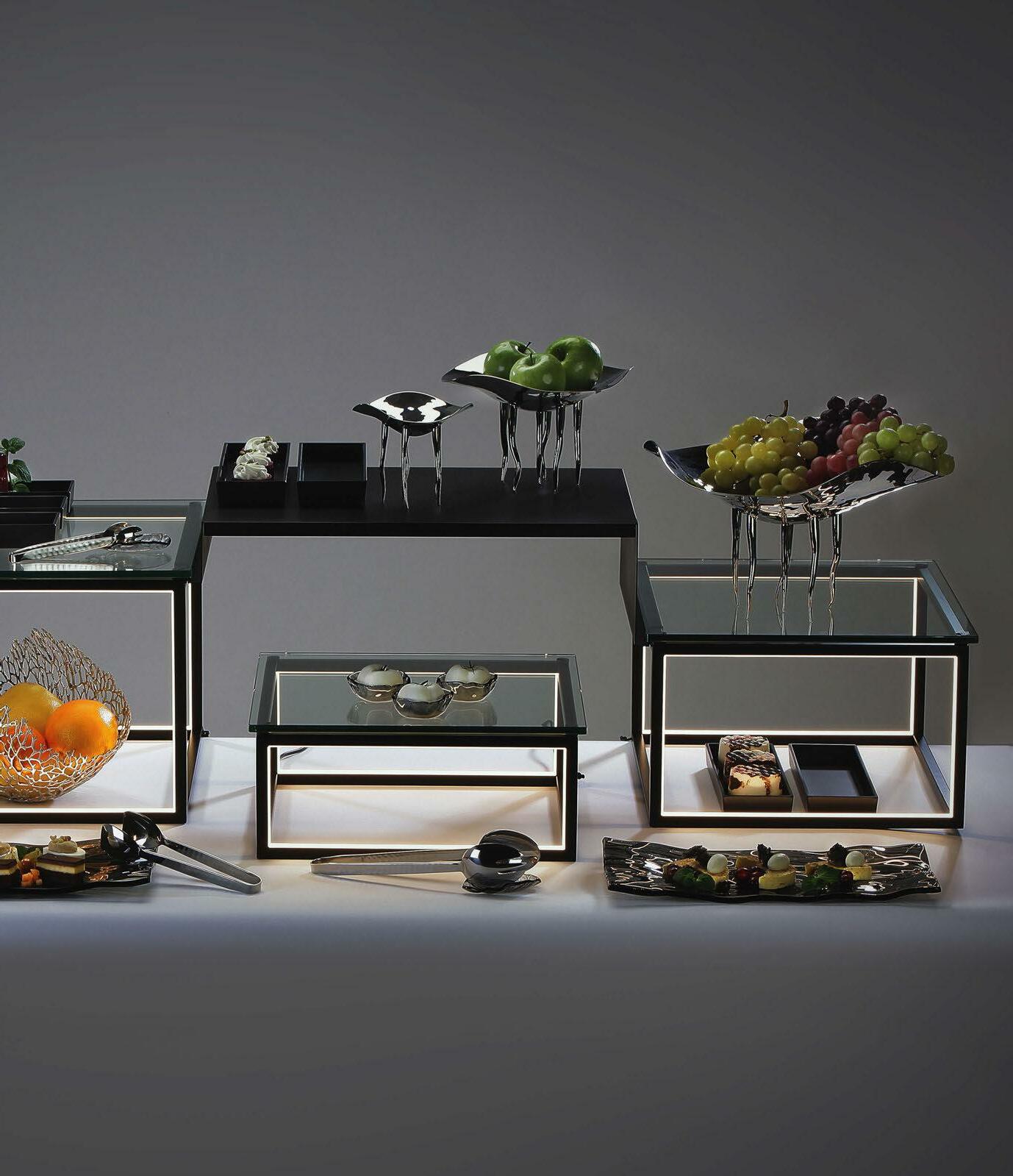
ON DECK
Maiden Voyage: 2023
Owner: Royal Caribbean Group
Operator: Silversea Cruises
Interior Design: GEM Design
Shipyard: Meyer Werft www.silversea.com
Silversea Cruises has unveiled eight signature restaurants for its new ship Silver Nova, scheduled to set sail in 2023.
From spacious, open-seated venues to more intimate dining options, the vessel’s diverse F&B offering will incorporate all-new design features facilitated by Silva Nova’s innovative asymmetrical design – a first for the ultraluxury cruise line.

Marking its debut Silver Nova is al fresco venue The Marquee on Deck 10, which incorporates Spaccanapoli and The Grill, while S.A.L.T. Kitchen will return with a new twist on its culinary-oriented décor. Other venues on board include the 1920s-style supper club and jazz venue Silver Note; French restaurant La Dame; Japanese-inspired Kaiseki serving cuisine from across Asia; and popular Silversea spot Atlantide. The largest of Silver Nova’s restaurants with a capacity for 340 diners is La Terrazza, comprising both indoor and outdoor
spaces. Reimagined with a new aesthetic it features floor-to-ceiling windows providing views to the horizon. In addition, Arts Café –relocated to the centre of the ship – will benefit from ample natural light thanks to a doubleheight, glazed atrium.
“Characteristic of Silver Nova, which will push boundaries in cruising, the dining experience aboard our newest ship will represent the latest iteration of Silversea’s unique take on luxury,” says Barbara Muckermann, Chief Commercial Officer at Silversea Cruises. “From S.A.L.T. Kitchen – the first large-scale, regional restaurant at sea – to The Marquee, each of Silver Nova’s restaurants will benefit from innovative design solutions that will bring the destination into view like never before. Food and drink has long been core to the cruise experience for our guests; with Silver Nova, we are enriching Silversea’s trademark dining experiences, which are among the finest at sea.”
Follow us @dernier_hamlyn info@dernier-hamlyn.com www.dernier-hamlyn.com


Ahead of its debut in 2024, Queen Anne’s design team describe their process of looking to the past to build the future as they reinvent the spirit of Cunard.
Words: Catherine MartinEver since Cunard announced that it would be adding a new ship to its fleet, the cruising community has eagerly awaited further news of the landmark unveiling. The appointment of Adam D. Tihany as Creative Director came in 2018, soon followed by the unveiling of the full line-up of design talent tasked with chanelling the heritage of the brand through a contemporary lens.
Then all went quiet – publicly, at least – but behind the scenes, a team of naval architects, shipbuilders and technical specialists have been working tirelessly, culminating in what has been a milestone year for Cunard. In February it was announced that the ship would be named Queen Anne; April marked the transfer from land to water; and in September, the traditional keel laying ceremony took place. Anticipation has been so great, that the first day of bookings was the busiest on record for the cruise line, with the maiden voyage sold-out well ahead of its 2024 sailing, even though little is known of the programming on board. The design details have also been a
closely guarded secret, up until recent months when a series of reveals have given a taste of what to expect. Here, all four design studios speak to Starboard to tell of the heritage, craftsmanship and storytelling involved in the creation of Queen Anne, and how every element contributes to the overall guest experience.
Describing his role as the conductor of an orchestra, Adam D. Tihany was tasked with bringing together the three design firms that would each play a part in the symphony of Queen Anne. Seeking to bring a fresh perspective, he enlisted Sybille de Margerie and David Collins Studio, both newcomers to cruise ship interiors, combining their hospitality expertise with that of Richmond, a London-based studio that counts hotels and cruise lines amongst its clients.
Over the past two years, Tihany has been the guiding hand of this orchestra, overseeing the development of the creative vision and its translation into an interior design scheme. “Each firm was assigned a portion of the ship, while I am


responsible for ensuring total cohesion between their areas, that the flow from one space to the next is seamless,” he explains. “I worked closely with the designers on every idea and aspect of planning, interior architecture, mood and aesthetic. It’s an ongoing process of review, during which I give feedback and direction, encouraging the design teams to consider every element, from materials and lighting to texture and colour.”
Together with Cunard’s creative team, Tihany began by setting the overarching vision for the ship, devising a concept that would honour the history of the brand while looking to the future.
“Just the way a world-renowned orchestra delivers a feeling, or takes you to a moment or an era, our project’s aesthetic will do the same in harkening Cunard’s gilded age, but through the bold, onward lens of modernity,” he explains. With that in mind, Tihany established brand pillars that would go on to inform every design decision made: “The Cunard narrative is an impeccable interplay of five core ingredients: heritage, craftsmanship, storytelling, style and innovation. This ultimately became the design DNA and the engine of inspiration for the team.” Indeed, the team were immediately captivated by the concept, particularly after a trip to the University of Liverpool, where over 400 linear meters of archives serve as an insightful voyage through history. “It was essential that we immerse ourselves in the history of Cunard
to understand the brand DNA,” explains Fiona Thompson, Principal at Richmond. “As there are multiple design consultants involved, it was also imperative that, under Adam’s stewardship, we were aligned with a common vision.”
For Lewis Taylor, Design Director at David Collins Studio, the wealth of materials kickstarted the thought process: “There were menu cards with graphics and fonts, and photographs of the interiors showing colour combinations, furniture forms and patterns from the upholstery – it was very inspiring.”
A meet-up at Cunard’s headquarters in Southampton ensued, where brainstorming sessions encouraged further exploration of the brand DNA. “The transatlantic crossing is what Cunard is known for, it’s ships define the Golden Age of cruise travel, so we talked about what makes Cunard unique,” Taylor continues.
“We also talked about British eccentricity and humour; it was important to incorporate this into our designs through artwork and accessories. Primarily, we wanted to take the heritage DNA and propel it into the future.”
Thompson agrees, describing the concept as a “reimagined Art Deco aesthetic” that is “contemporary, luxury and timeless, inspired by the early days of transatlantic travel”.
With the designers aligned to the same vision, they each sought to bring their own aesthetic to the scheme, which will in turn ensure a diverse mix of experiences for passengers. “From the very beginning, we knew we wanted each area to have its own identity,” notes Taylor, adding
that David Collins Studio’s approach is about colour and texture – a teaser of what’s to come.
The team could quite simply have replicated the designs they were so inspired by, but that wouldn’t have been in keeping with the brief. “In many of our projects, we look back to take the design forward,” explains Taylor. “But rather than copy like-for-like, we look at details from the past and create contemporary interpretations – it feels more authentic.”
Revealing more about such design details on Queen Anne, he continues: “In the archives, we found an old photograph of a timber wall panel with a deco motif in the corner; we sketched it and made some tweaks, and that small detail has gone on to inform the patterned carpet in the suites as well as the custom wallpapers.”
The same approach has been taken by Richmond. “We uncovered so many gems in our research that can be experienced within the new interiors of Queen Anne,” says Thompson. “There was a black-and-white photograph of a distinctive chair on board Queen Mary that caught our eye so we reinvented it for the Britannia Club restaurant, adding a contemporary pattern; the rich mahogany timber frame together with the tailored stitching has resulted in an updated version of an Art Deco antique.”
The brand pillars of heritage and craftsmanship have inspired other details too. “Luxury finishes like bespoke verre églomisé panels, handcrafted by artisans, will add a refined, authentic layer
“The Cunard narrative is an impeccable interplay of five core ingredients: heritage, craftsmanship, storytelling, style and innovation. This ultimately became the design DNA and the engine of inspiration for the team.”
D. TIHANY
to the design,” Thompson continues. “This will result in a unique, personal experience.”
With Richmond taking responsibility for entertainment spaces including the 825-seat Royal Court Theatre, David Collins Studio is charged with the Grand Lobby, the Queens Grill Suites and the main dining room. For Sybille de Margerie, the focus is on the Princess Grill, Britannia staterooms and atrium retail as well as the comprehensive Mareel Wellness & Beauty facilities. The designer also took inspiration from the past, subtly integrating elements into bespoke wallpapers, fabrics and carpets. “Cunard has a strong DNA so our design respects the heritage dimension of the brand, but being an ambassador of French elegance, I wanted to bring a touch of art de vivre to the project too,” she explains, adding that “poetic details, unexpected materials and refined finishes will bring drama to the scheme”.
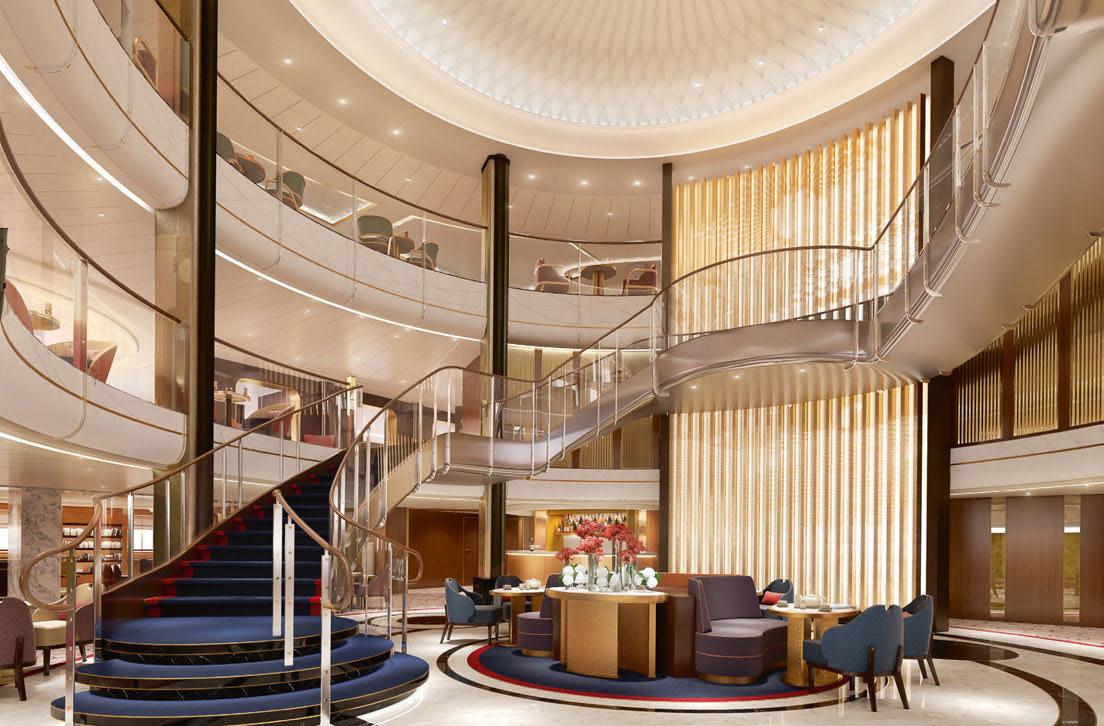
The Britannia Club staterooms for example
pair bold geometric patterns with an intense shade of navy, while the Princess Grill rooms are decorated in sumptuous red accompanied by gold tonal highlights.
Storytelling is also central to the design, with de Margerie opting for materials, finishes and furnishings that tell the tale of those who might have sailed with Cunard in years gone by. For instance, in the Queens Room – a grand bar and ballroom that plays host to the signature afternoon tea – elegant golden tones form the backdrop to a trip back in time. “The décor features souvenirs brought back from distant journeys, while the chandelier with its planetary spheres recalls a time when sailors were guided by the stars, just as the traveller is guided to the heart of the ship,” the designer explains. And the stories continue throughout.
“The embossed leather and brass detail of the headboard references a vintage suitcase; glass wall lamps appear like a lighthouse lens to cast a soft glow and guide the guest to bed; and a touch of rope recalls nautical materials in their
“We wanted to make sure there are common elements; every space has its own identity yet there’s a common thread throughout.”
LEWIS TAYLOR

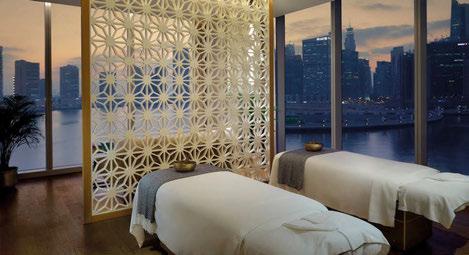

purest form,” de Margerie reveals, also pointing out the ever-present timber that illustrates the craftsmanship of luxury vessels. “My main objective is to balance tradition and modernity,” she confirms. “I’m adding craft and style to the historical elements for authentic interiors that enhance the cruise experience.”
THE SPACES IN-BETWEEN
Enhancing the cruise experience through the design of the restaurants, bars, lounges and entertainment venues is a given, but what of the spaces in-between? Under Tihany’s directive, each firm has considered the guest’s journey through the ship to ensure cohesion. “Across the ship our designs feature vibrant colours and materials, but for the public circulation spaces we opted for a warm, neutral colour palette,” explains Thompson, confirming the importance of seamless transitions.
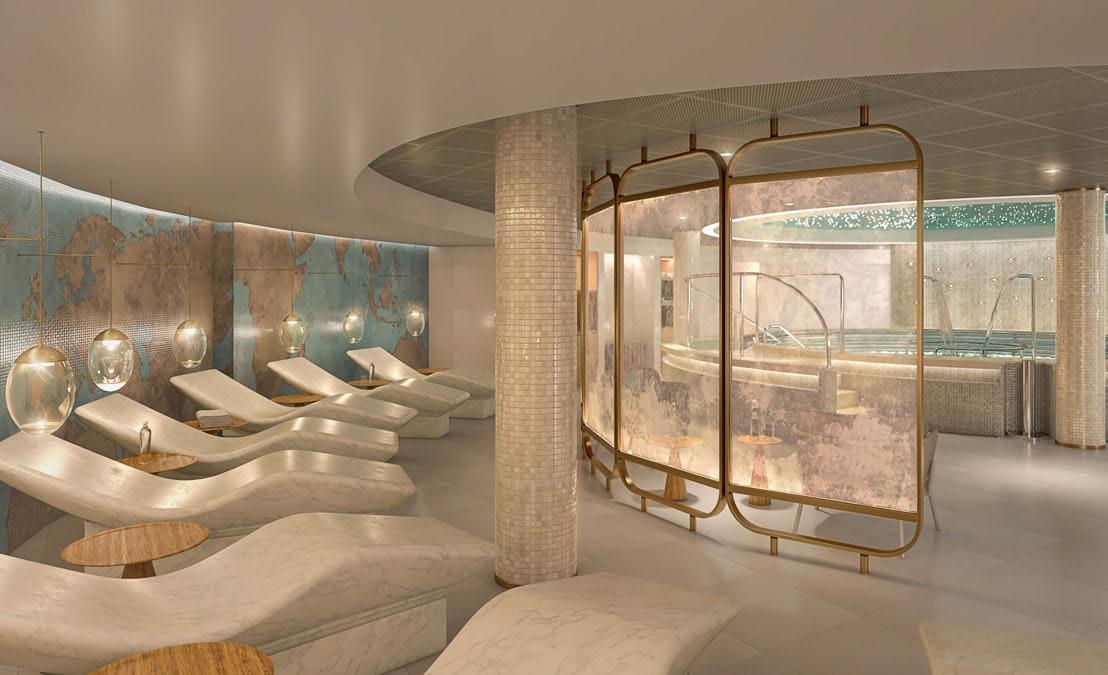
Arguably the most important of the transitionary spaces is the atrium; sitting at the heart of the ship, it links all the amenities
yet is also a destination in itself. “This was our greatest challenge as no matter what level of stateroom, all guests will come to the atrium,” says Taylor. “It’s a meeting place, it’s where concierge is and there’s a mix of retail and F&B on each deck; it has to be functional, serving different functions at different times of day, all while showcasing the Cunard DNA and a touch of timeless glamour. Crucially, it’s where people embark and disembark, and first and last impressions are important.”
A sense of cohesion between the spaces has been achieved through collaboration, with the team getting together for concept presentations and workshops to look at samples. “We wanted to make sure that there are common elements, such as finishes or colourways, that complement or carry from one space to another,” Taylor confirms. “Every space has its own identity yet there’s a common thread throughout.”
The sense of teamwork is evident from all involved and comes as a new approach for some. “We are used to collaborating with architects
“I’m adding craft and style to the historical elements for authentic interiors that enhance the cruise experience.”
SYBILLE DE MARGERIE
Secto Design is known for its wooden lamps that create a cosy atmosphere and elevate their surroundings. Kuulto ceiling fixtures look stunning both on their own and in modular groups or rows. Both sizes can be used on either ceilings or walls. Design by architect Seppo Koho.

and specialist consultants on hotel projects, but this is our first experience of being in a team with competitors,” says de Margerie. “The collaboration has been so respectful of each other’s ideas that we have become partners.”
The sentiment is shared by Taylor, who adds: “It was a unique situation to go from being competitors to collaborators, but it was imperative that we work closely as our areas sit side by side.”
Naturally there were differences of opinion throughout the process, but each designer was able to draw from their own experiences to reach the shared goal, as Thompson confirms: “Adam acting as conductor ensured coherence between the three design firms; it was an engaging design environment where different perspectives for design solutions were actively encouraged to succeed in creating a next-generation luxury standard for global travellers.”
And that, of course, is the ultimate aim – creating
an onboard destination for travellers. As such, every element of the scheme, from the towering atrium to the detail of the door handles, will contribute to the overall guest experience. Final judgement will of course come when Queen Anne makes its maiden voyage, a seven-night sailing departing from Southampton in 2024. But what do the design team hope to achieve for this landmark project? “The Cunard spirit is unique so the vessel must touch the heart of passengers,” says de Margerie, adding that her vision is to “create memories through sophisticated, intimate spaces”.

Thompson meanwhile describes the design as a journey, stating: “For us, it will be extremely satisfying for guests to feel and experience an essence of the past while looking to the future.”
And final word goes to the conductor. “The ultimate achievement of great design is to delight and surprise,” concludes Tihany. “I am confident the ship will deliver that sense of wonder, like a matchmaker at sea that introduces the past to its most alluring future.”
“It will be extremely satisfying for guests to feel and experience an essence of the past while looking to the future.”
FIONA THOMPSON
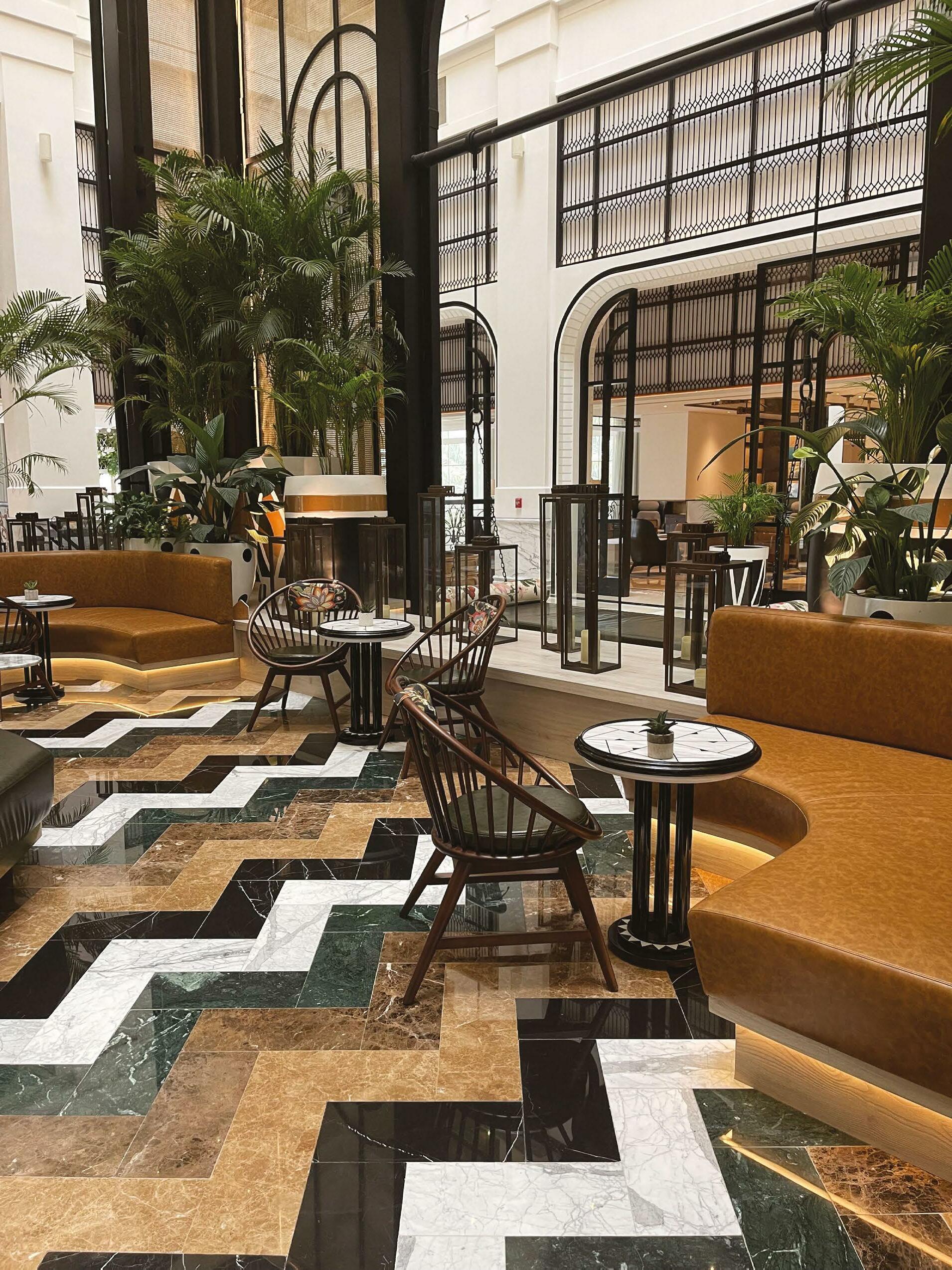
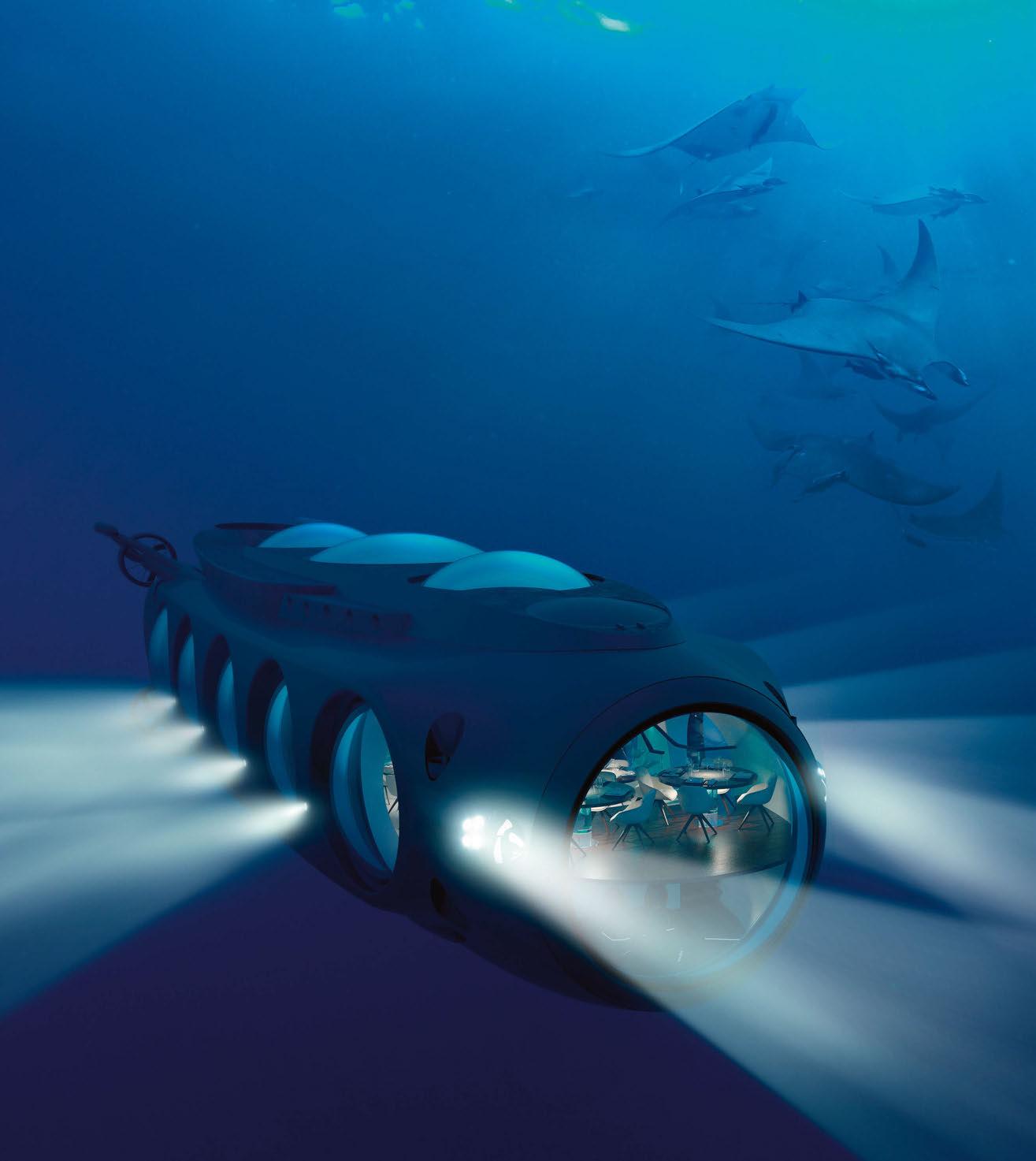
U-Boat Worx presents an underwater entertainment platform for hosting memorable get-togethers.
Imagine dining side by side with a stingray, or partying the night away with a porpoise? That’s exactly what U-Boat Worx is proposing with its Under Water Entertainment Platform – or UWEP for short – an autonomous submersible kitted out with a bar, galley and 150m2 of flexible event space.
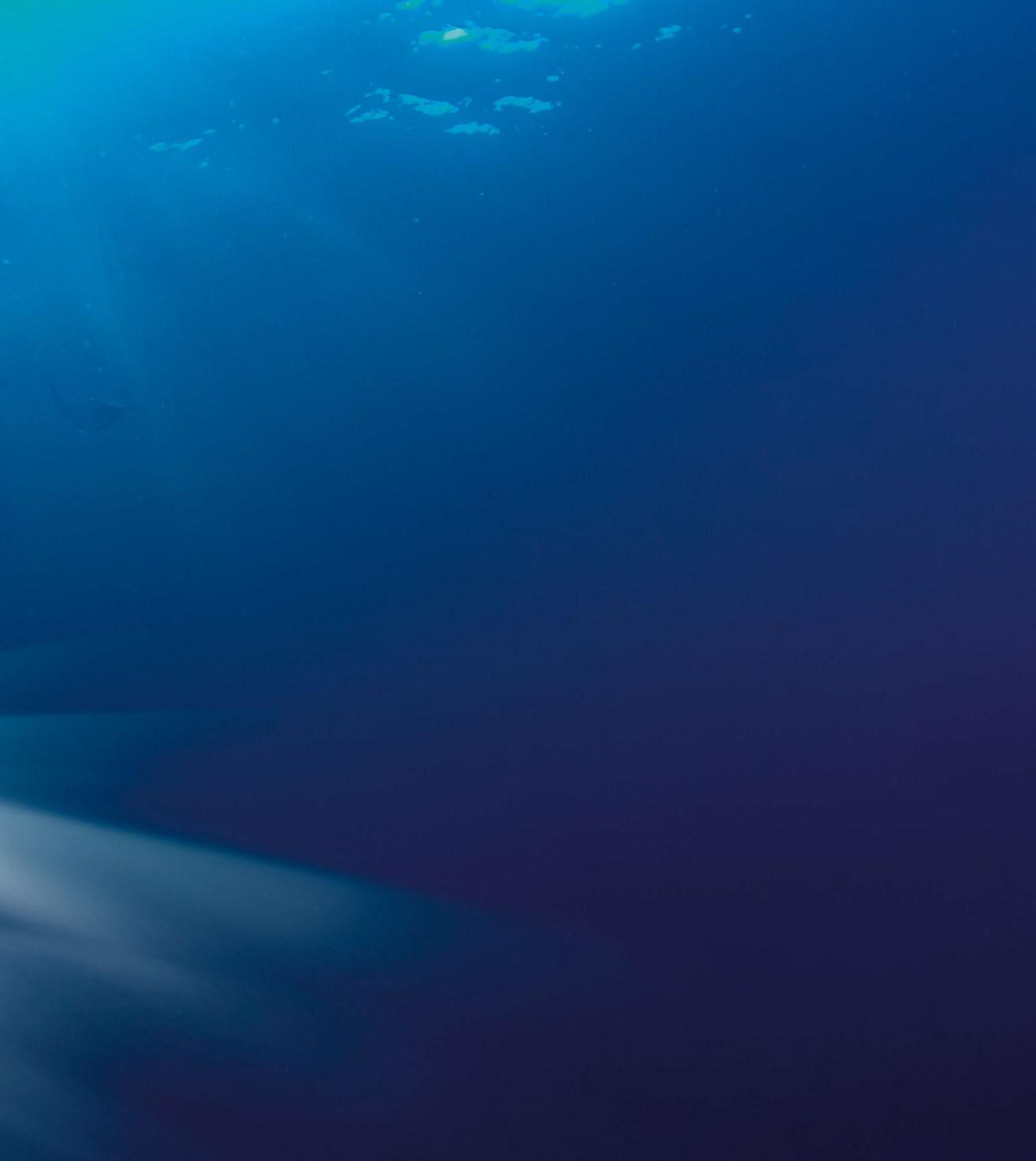
Billed as a new class of submarine, the 35m vessel can host up to 120 guests in a fully pressurised environment, cruising 200m below the surface at a rate of three knots. It features 14 circular windows that connect guests directly to the underwater world around them, and exterior lighting to subtly illuminate passing sealife. The interiors are intentionally flexible with a number of configurations available, ranging from a restaurant offering deep-sea dining to a subaquatic casino. And, given that the submarine runs solely on battery power and can operate non-stop for 24 hours, it could even host an all-night rave.
“The UWEP will shake up both the submarine and hospitality industry and lead the way in bespoke underwater events,” says Bert Houtman, founder and CEO of U-Boat Worx. “We will not only present a stellar experience for the most discerning clientele, but also a business opportunity that will benefit entrepreneurs and contribute to our understanding of the oceans.”
Belmond reimagines slow travel with the latest addition to its Les Bateaux Belmond collection.
With weary city dwellers eager to escape the breakneckspeed of modern life, slow travel is gathering pace. As such, Belmond is strengthening its portfolio with a new barge that will gently amble along the waterways of France’s Champagne region from May 2023.
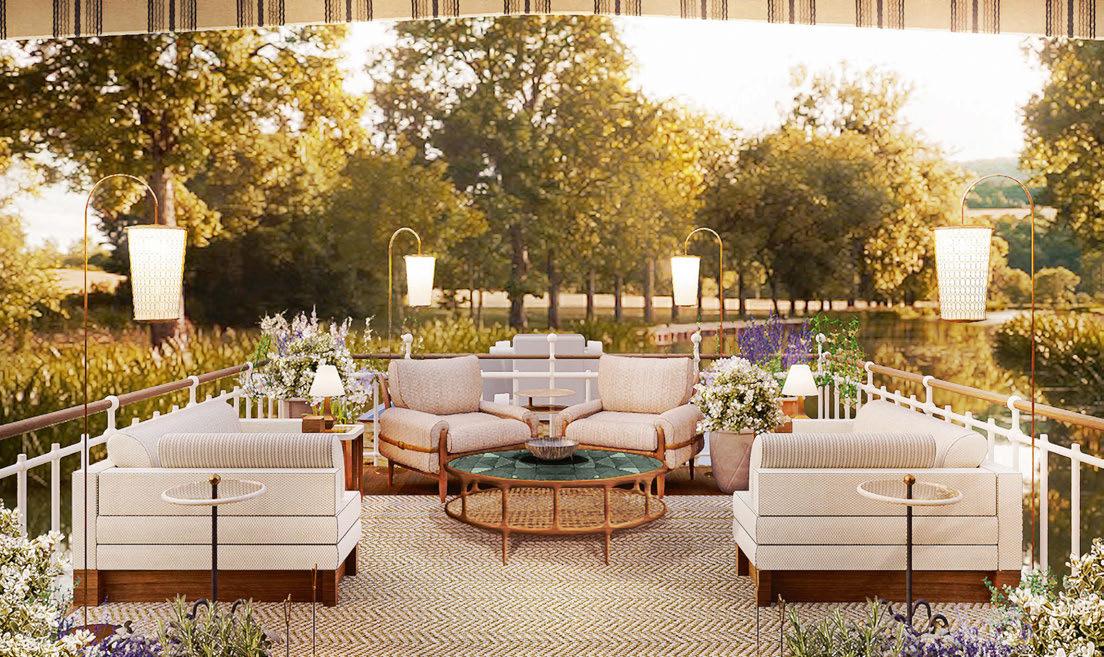
The luxury vessel – christened Coquelicot – will set a new standard for slow sailing in the region, thanks to the interiors of Humbert & Poyet, who have been tasked with creating an intimate sanctuary on the water.
On board are three double cabins, each with marble en suite bathrooms, and an indoor lounge featuring a champagne bar. The star of the show however is the top deck with two al fresco lounges, an open kitchen and a shaded dining area – ideal for taking in the views.
In crafting the interiors, Humbert & Poyet sought to capture the essence of Champagne, looking to the region’s character to inform the colour and material palette. Local fabrics in earthy tones will honour the province’s agricultural heritage, while fluted walls and a selection of artwork pay homage to the land’s glorious present. Coquelicot’s namesake, the red poppy, can be found in subtle references throughout, from the hand-cut red marble side tables to the tone-on-tone
handpainted petals that line the hallway, while the lounge’s skylight is a celebration of Champagne’s water mapping legacy.
The guest experience is further elevated by a partnership with Maison Ruinart, offering an immersion into the world’s oldest champagne house, founded in Reims in 1729. Coquelicot passengers will be treated to a five-course private tasting lunch by Maison Ruinart’s Chef-in-Residence Valérie Radou, who will work alongside a Head Chef for a four-hands cooking experience. A true lesson in French art de vivre, the menu will include five seasonal dishes inspired by regional cuisine, paired with prestigious cuvées such as Dom Ruinart Blanc de Blancs and Dom Ruinart Rosé.
As part of the collaboration, guests will also enjoy unrivalled access to Taissy vineyard, where they will learn about Maison Ruinart’s pioneering viti-forestry project and partake in a technical tasting led by a Maison Ambassador. To ensure each passenger has a truly personalised voyage, a Guest Experience Executive will curate a bespoke itinerary, selecting activities from the likes of an art-focused tour of Champagne to epicurean visits to Europe’s secret wine producers.

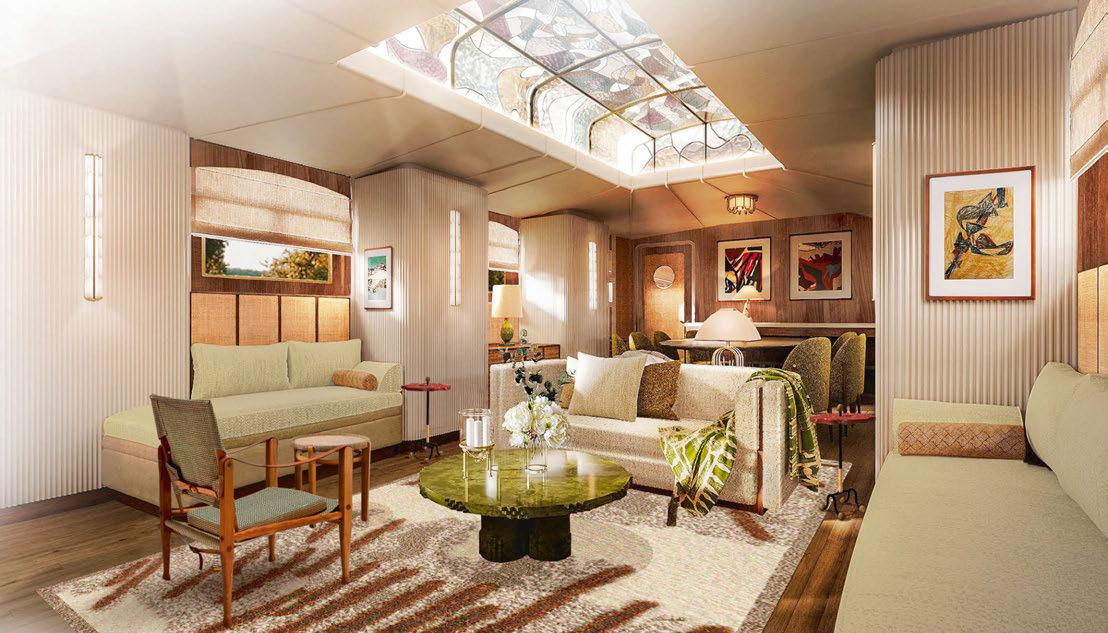
Privacy and flexibility are key to the nextgeneration cruise experience, as Partner Ship Design explain.

In April this year Aida Cruises christened the latest addition to its fleet, equipped with new features designed to elevate the cruise experience. Like every new venture from the operator, Aida Cosma is not just another ship, it represents new thinking, a new approach and the way in which the brand intends to develop into the future. It’s the latest milestone of journey that never stops. For Aida Cruises, the journey began with Aida Cara and since those early days, Partner Ship Design has worked closely with the group to develop its vision for the look and feel of the brand.
multifunctional space. The concept was first presented in 2007, and has since been developed and enhanced for every new ship.
The successful elements from previous vessels have also been enhanced across the interiors, with the scheme showcasing contemporary modern design and emotional atmospheres, combining the privacy of a living room with exciting and high-energy experiences. Partner Ship Design also sought to be daring and try something new. The innovative food and beverage concepts for example reach new heights thanks to the addition of the Beach House Restaurant, which is inspired
Based on the Helios-Class platform, Aida Cosma ranks among the largest ships of the world cruise fleet; it was therefore vital to devise a floorplan that was flexible, offering spaces for both privacy and socialising. The general arrangement layout of the Helios Class, or XL-Class as Carnival Corporation call it, was developed by Partner Ship Design in collaboration with Carnival, and served as a platform for other ships within the group portfolio, including Mardi Gras and Celebration, Costa Smeralda and Costa Toscana, and P&O´s Iona and Arvia.
Aida however wanted to distinguish its product, and so implemented the general arrangement layout before differentiating through design and amenities. Standing in the tradition of the Aida philosophy, Cosma features the Theatrium, a multi-functional space at the heart of the ship, marrying the theatre and the atrium and connecting day and evening activities both horizontally and vertically. It’s a marketplace of possibilities and the epitome of a timeless and
by the heritage of Baltic seaside diners and serves breakfast, lunch and dinner in a bright yet cosy atmosphere. Another new eatery, Ristorante Mamma Mia Restaurant, offers Italian-style joie de vivre hospitality, while Fuego – the signature buffet restaurant – has been expanded for a more spacious and relaxed dining experience.
For relaxation and entertainment, more open deck space is provided by the ocean pool deck located at the stern of the ship. It features an infinity pool and an entertainment stage with large LED screen and tiered spectator seating. In addition to the wide range of activities on existing ships, Aida Cosma caters to families and children through a ninja experience and a threedeck indoor climbing net with dry-slide. The new boulder wall and hanging bridge round out the comprehensive offerings.
In all, Partner Ship Design has contributed to the continuation of the Aida Cruises journey, creating harmonious and exciting interiors for all passenger and crew areas.

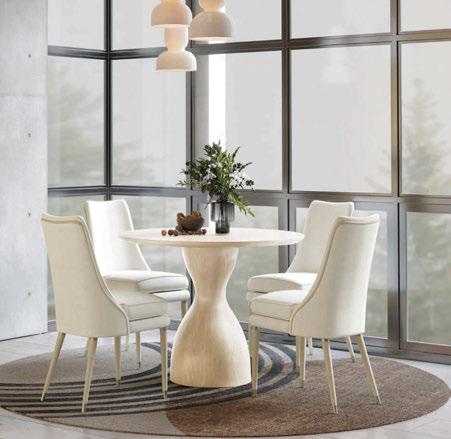
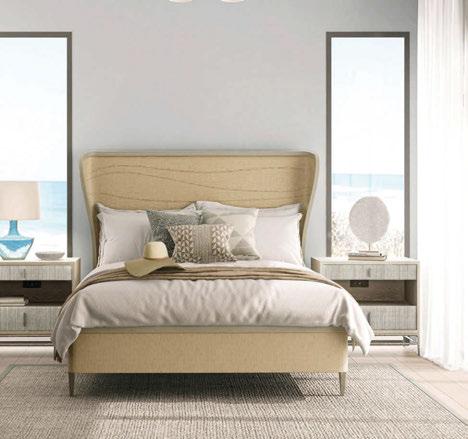
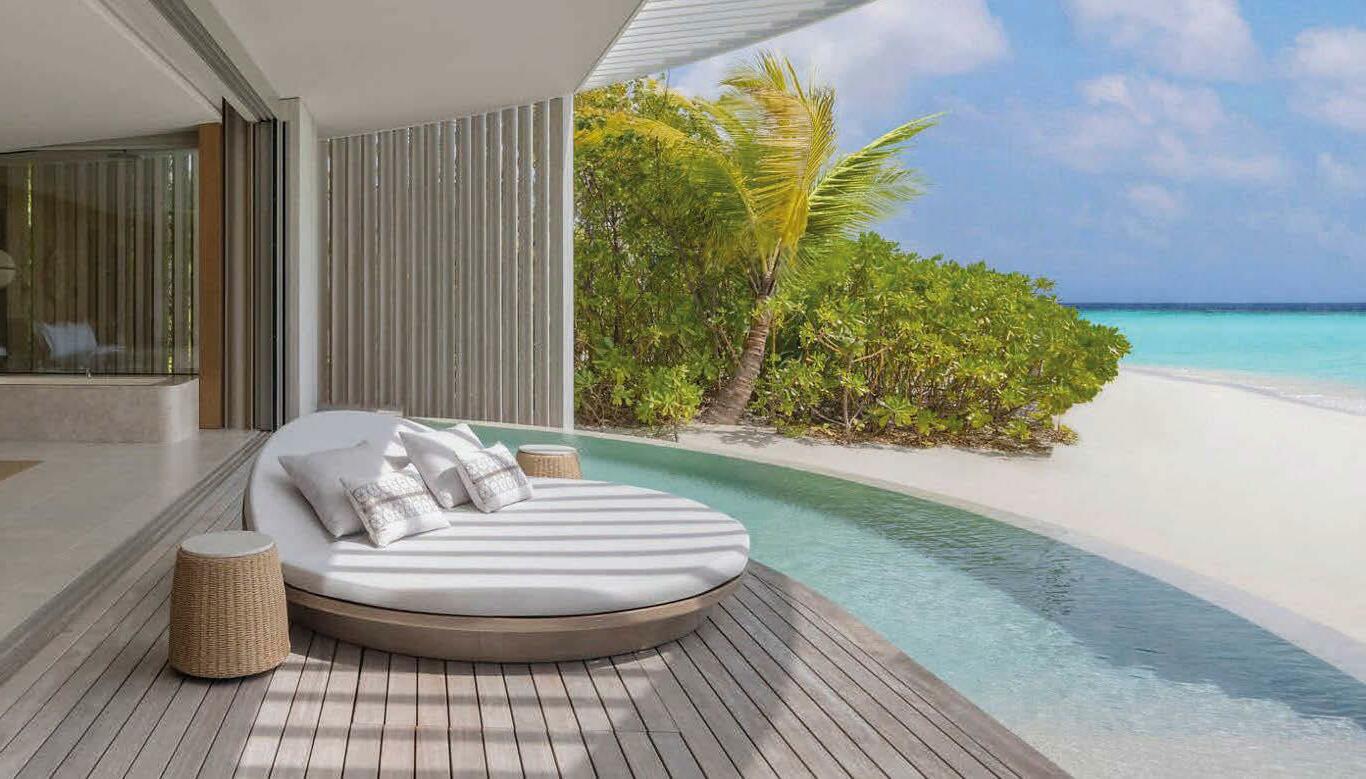 Ritz Carlton - Maldives, Fari Islands
Ritz Carlton - Maldives, Fari Islands
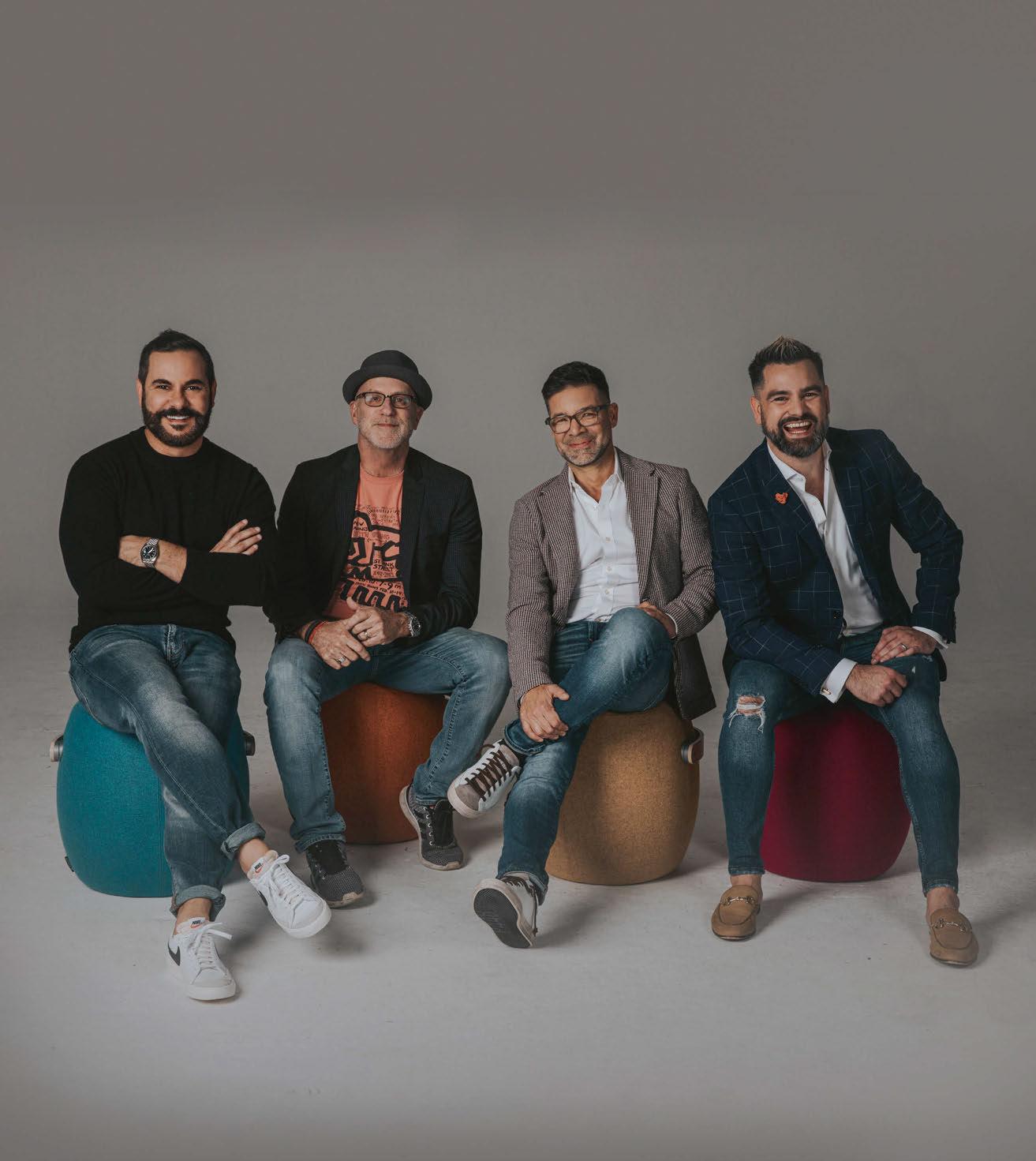
Envisioning a first-in-class ship is a major responsibility for any design practice. It requires expertise, ambition and foresight, and comes with the added pressure that every detail will serve as a blueprint for subsequent vessels. For Studio Dado – the Miami-based practice entrusted with designing a significant proportion of Norwegian Cruise Line’s first Prima Class ship – the assignment has been both a challenge and an opportunity.
A vessel of firsts, it was to be the brand’s first new class of ship in almost a decade, with the aim being to elevate the guest experience; it was the first large-scale development helmed by Frank Del Rio following his appointment as President and CEO of Norwegian Cruise Line Holdings in 2015; and for Studio Dado, it marks their first newbuild project of this scale, having only been established in 2016.
“A very wise man once told me that the first-in-class is basically like building a full-scale prototype,” explains Greg Walton, speaking to Starboard via video call from his office in Coral Gables. “This project really encouraged us to rethink the paradigm of what NCL ships are.”
A well-known character in the field of cruise ship design – always with trusty canine companion Enzo by his side –Walton founded Studio Dado together with Yohandel Ruiz, Javier Calle and Jorge Mesa, all seasoned designers with a wealth of experience between them. Having delivered staterooms, spas, restaurants and retail for all Norwegian Cruise Line Holdings brands over the years, the team have worked to expand their role. “With every new project we’ve
been able to amass more spaces and bring more worth,” says Ruiz, as he joins the conversation. “Our remit has grown to the point where we’re the lead architect for many of the group’s projects; it has been a very successful relationship.”
So successful has it been, that of the design firms appointed to work on the vessel, Studio Dado was responsible for the highest percentage of total public areas – a major achievement for the firm. “To be invited to participate in the conceptual design phase is quite an accolade,” Ruiz continues. “There’s always pressure, but there was even more pressure with Prima because it’s the first newbuild project that we have had such a large scope of work on; not only did we have to prove ourselves as Studio Dado, we really had to bring our A-game and show what Studio Dado is about from a design perspective.”
Plans for the new class were first announced by Norwegian Cruise Line in 2017, a time of growth for the wider sector in which different demographics were beginning to see the appeal of sailing holidays. The expectations of travellers were evolving too – they demanded higher quality, more choice and ultimately, a memorable experience. NCL knew they had to make a mark, and so embarked on a gamechanging mission to elevate their offer. Norwegian Prima is the first of six Prima-Class vessels set to be delivered between 2022 and 2027, each accommodating 3,100 guests at double occupancy and boasting a whole host of dining and entertainment options.
“The brief was to develop a new class of ship that is different from anything that has been seen previously. NCL
 As Norwegian Prima takes its maiden voyage, Studio Dado delves into the design and development of a ship of firsts.
Words: Catherine Martin • Portrait Photography: © Lopez Productions • Interiors Photography: © Ann Remotigue
As Norwegian Prima takes its maiden voyage, Studio Dado delves into the design and development of a ship of firsts.
Words: Catherine Martin • Portrait Photography: © Lopez Productions • Interiors Photography: © Ann Remotigue

wanted to tap into a younger demographic, so we spent a lot of time exploring what they look for in a travel experience,” explains Ruiz. “What do they like in a dining venue? What kind of entertainment appeals? How do they navigate through the ship? We live in a world where everything is about sharing, so we wanted to create a ship that reflects this social mentality of always being connected and sharing our experiences with the world.”
Ultimately, it was about experience, in every sense of the word. “It goes beyond just creating beautiful spaces,” Ruiz continues. “It has to be engaging too, encouraging travellers to interact with the spaces in a new way.”
In their research, Studio Dado looked to popular land-based experiences – ranging from the nightlife of Las Vegas to the opulence of Dubai’s Burj Al Arab – deconstructing the sought-after elements and seeking to recreate them at sea. “We wanted to challenge convention as to what’s possible at sea and change what had been typically thought of in the past as a Norwegian vessel,” confirms Walton, adding that design was the tool with which they could achieve this. The team commends the leadership of Frank Del Rio in driving innovation and encouraging them to rethink what a cruise ship looks like. “We were given carte blanche to dream, to think outside the box and bring forth ideas that may have been a little challenging, even for construction,” Ruiz adds. “To give you an example, the atrium was one of those spaces where we felt we could really push the envelope, and both NCL and the shipyard rose to the challenge of developing something that hasn’t been done before. We’re so thankful that we had their backing because clients often shy away from innovation, it can be risky, but Frank is truly a visionary and said ‘let’s go for it’ – that’s the best thing you can hear from a client.”
The boundary-pushing atrium that Ruiz refers to is indeed a marvel. Spanning three levels at the heart of the ship, the space is unapologetically contemporary, blending geometric lines with high-gloss finishes to
GREG WALTONevoke a sense of wonder. The grand staircase takes a distinctive linear form, while a custom lighting installation by Lasvit draws the eye upwards, its design inspired by the stars. What’s most interesting however is the architecture.
“If you look at existing ships, the atrium is the same shape on every deck and symmetrical on both sides of the centerline,” explains Walton.
“Our design throws out both of these contexts immediately; we envisaged an atrium that is different on each deck and also asymmetric about the centerline.”
The approach involved close collaboration with Fincantieri to figure out the exact shape of the openings, with calculations made to ensure the vessel remains structurally sound. “It was challenging, but Fincantieri pulled out all the stops to make it possible,” Walton continues.
“The guest might not even notice, however those of us working in the sector realise it’s a major innovation in cruise ship design.”
What guests will notice is the impact this design has on their onboard experience. Rather than a transitional space to pass through,
the atrium is conceived as a place to linger. In developing the idea, Zack Niphatkosalsilp, Senior Associate at Studio Dado, tapped into his experience as an urban planner and looked to gathering places around the globe to determine what makes them successful. One of the elements he found to be important was the envelope of the space, and how different activations encourage interaction and conversation. On Norwegian Prima, the different openings on each deck provide a variety of vantage points from which to take in the atrium; the assortment of seating caters to both social gatherings and moments of solitude; and the arrangement of restaurants, bars and retail promotes a journey of discovery.
Proof of the atrium’s success came on the inaugural voyage, when Ruiz observed the space in use. “People actually came to the atrium and stayed, they hung-out,” he says proudly. “We really achieved the goal of creating a place where people gather as opposed to just pass through.”
According to Ruiz, feedback from guests revealed an appreciation for the way in which the space unfolds, making for a different experience every time they visit. “There’s something for everyone; you can sit in a café and people-watch or engage in the entertainment at the bar – it functions on many levels.”
The programming is wide-ranging and incorporates restaurants, bars, lounges and retail spread across the upper decks. Of the spaces designed by Studio Dado, a luxury brands store on Deck 7 is characterised by a palette of rich materials in jewel tones, while a beauty emporium on Deck 6 is clad in warm timber in a look that is inspired by European apothecaries. The studio was also responsible for the design of an immersive gaming pavilion, the VIP casino and the Observation Lounge, where the clever use of alcoves and partitions creates zones for reading, relaxing, playing games or socialising. The colour palette here is intentionally neutral, featuring oatmeal and amber tones that are elegant and homely, yet don’t detract from the panoramic views. Even the often-overlooked corridors have been given careful consideration, with elevated finishes including detailed
“We wanted to challenge convention as to what’s possible at sea and change what had been typically thought of in the past as a Norwegian vessel.”
The French captures the elegance of Paris, with gold-leaf alcoves and a series of dazzling floor-toceiling chandeliers
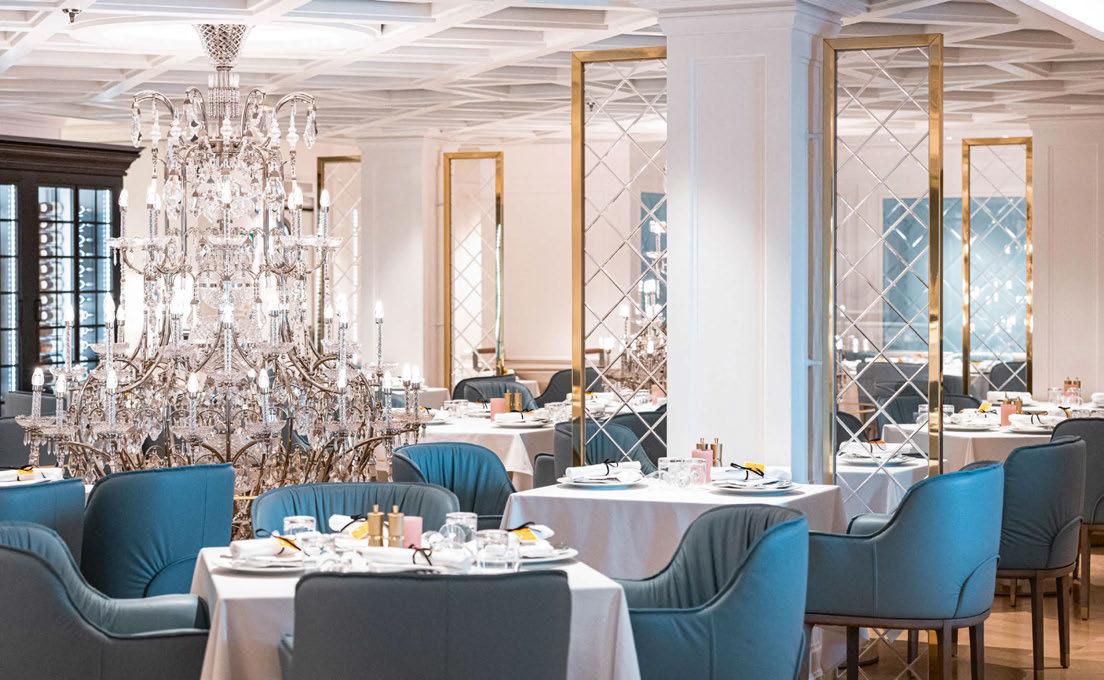
millwork and carpet-to-wood flooring transitions. The design of the staterooms has been elevated too, bringing a residential style that caters to the desire for a homely sanctuary in which to relax. Light timbers and a neutral colour palette contribute to the spacious, airy feel, as does the strategically placed lighting and intelligent storage solutions. Every detail has been considered, harking back to Del Rio’s drive to rethink what a cruise ship looks like. Studio Dado has enhanced en suite bathrooms by expanding the size of the shower cabin, and taken the decision to eliminate the bedskirt, which may seem minor, but has a positive impact on the sense of space, not to mention housekeeping.
In total, Studio Dado have designed six of the restaurants on board Norwegian Prima, each with its own distinct identity as led by the cuisine. Taking guests on a global culinary journey, there’s a teppanyaki house that pays homage to Japanese craftsmanship through the use of bamboo-patterned glass tiles, atmospheric lanterns and tatami mats repurposed as wallcoverings; a French bistro that captures the elegance of Paris, with gold-leaf alcoves
and a series of dazzling floor-to-ceiling chandeliers; and a Mexican that borrows the bold colour and pattern of the nation’s traditional dress. Perhaps the most highly-anticipated venue is Onda by Scarpetta, the fine-dining Italian that can be also found on Norwegian Encore, given an upgrade here in line with Prima’s elevated feel. Interiors draw from ancient Rome and combine the forms and finishes of MidCentury architecture, translated as rippling archways that envelop the dining room to dramatic effect.
Studio Dado’s restaurants also align with the NCL approach of putting the guest first. “Whenever we design a restaurant, the key principle we apply is that there shouldn’t be a bad seat,” explains Ruiz. “No-one wants to feel like they’re relegated to a corner, so the guest is always front and centre of the experience.”
Though each outlet has its own aesthetic, Studio Dado point out that there are commonalities across the ship, in both public spaces and staterooms. “They all feel like they belong together; there’s a common thread that runs through the design, between our space and those by other architects,” says Ruiz, referencing the work of Piero Lissoni, Rockwell





Forest Group offers different drapery hardware solutions especially made for cruise ships. Whether you choose for our motorised curtain tracks or rods, roller blinds or roman blinds your guest will experience ‘the Forest Factor’. Which stands for a unique combination of smooth hanging curtains, comfortable luxury and optimal ease of use.
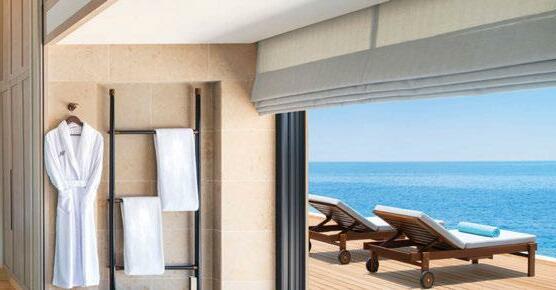



www.forestgroup.com

The design of Onda by Scarpetta draws from ancient Rome and incorporates rippling archways that envelop the dining room to dramatic effect
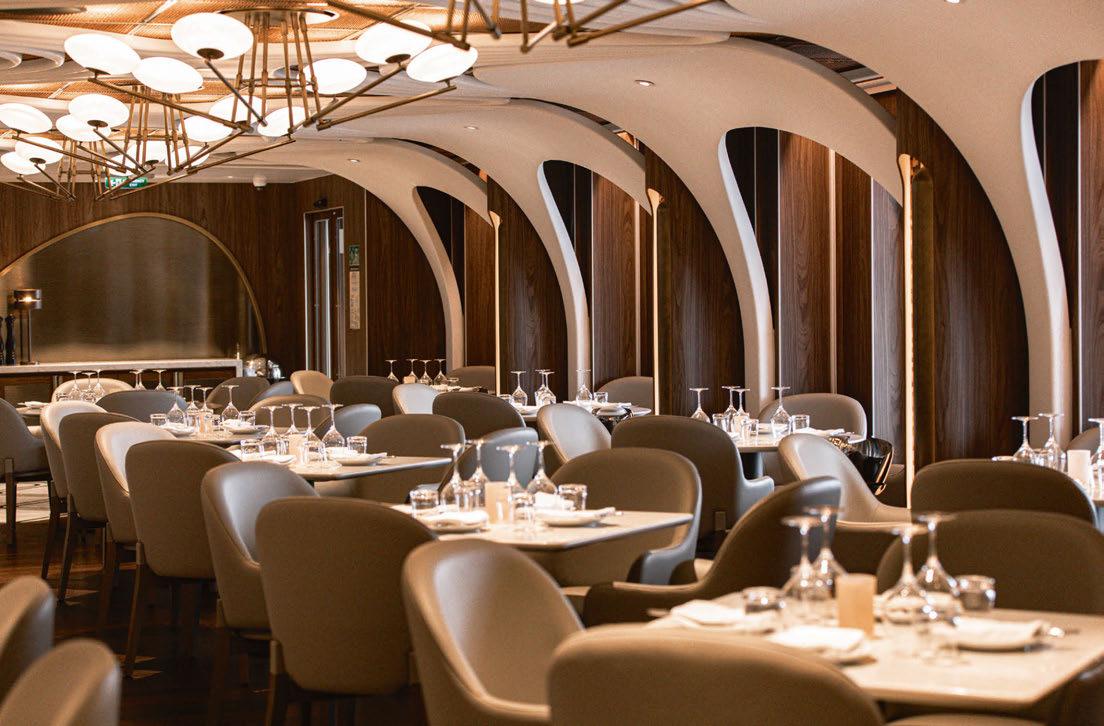
Group, SMC Design, Tillberg Design of Sweden and YSA Design. “This was achieved through collaboration and ongoing dialogue. Everyone was so invested in ensuring the success of this vessel. It’s very fluid and transitions were carefully considered, as were materials, colourways and lighting; it might be that we carried the same stone finish from one section to another, for example.” He adds: “All the spaces have their own individual language and personality, but as a whole, they feel like they’re connected; that’s a testament to the level of teamwork.”
It’s clear from speaking to Walton and Ruiz, that Norwegian Prima is a ship that they’re particularly proud of, attributing success to the teamwork and trust built along the way. “It may sound cliché, but good relationships make the process so much easier,” notes Ruiz. “This vessel was delivered to Frank’s vision and with full trust in everyone he brought to the table, he’s very much part of the conversation. Presenting ideas to him is the easiest part of our job because he knows from the minute he sees a finish or a fabric whether it’s something he wants; he’s so engaged and I think the results speak for themselves.”
NCL are delighted with the results too, by all accounts, and have since entrusted Studio Dado with the design of subsequent vessels. So what’s in store for Norwegian Viva, the second Prima-Class vessel due to set sail in 2023? “It is very much rooted in the same principles that were established on the first vessel, with a few minor tweaks,” says Ruiz, adding that the team are in fact currently working on the fifth ship in the series. “We’re hoping to make some larger changes towards the end of the class and deliver something a little different, though it will still feel like an evolution.”
The as-yet-unnamed ship is slated to complete in 2026, and so Studio Dado have been gazing into their crystal ball to forecast the future of cruise travel. It’s a daunting task, particularly given the events of the past two years, but the team are confident that they can deliver. “One thing for certain is that people see the value of cruising, they see the benefits to this type of vacation experience,” Ruiz concludes. “So long as we continue to deliver great experiences that are rooted in a brand message that’s true to NCL, we’re going to be successful.”
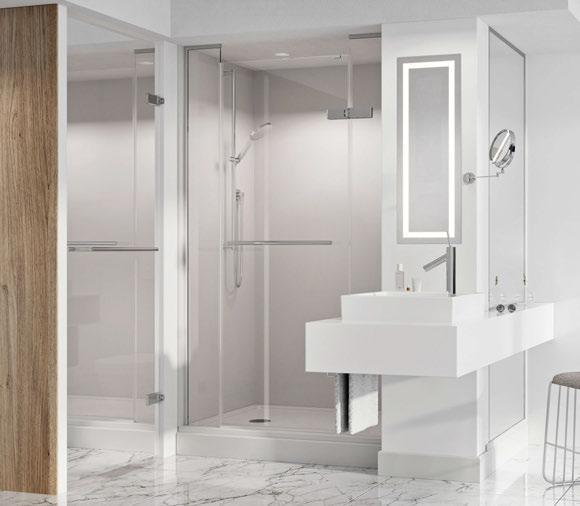

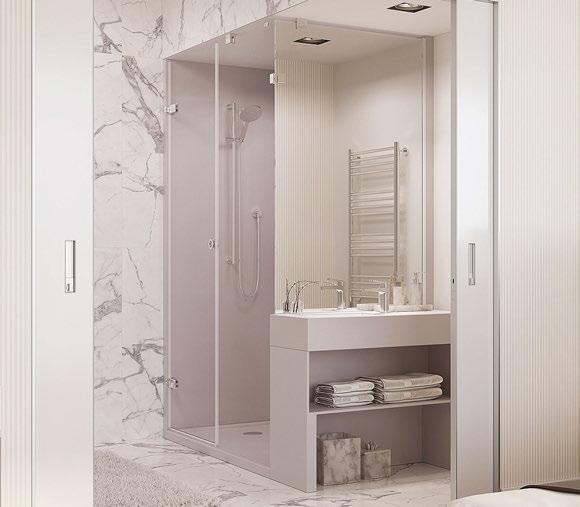


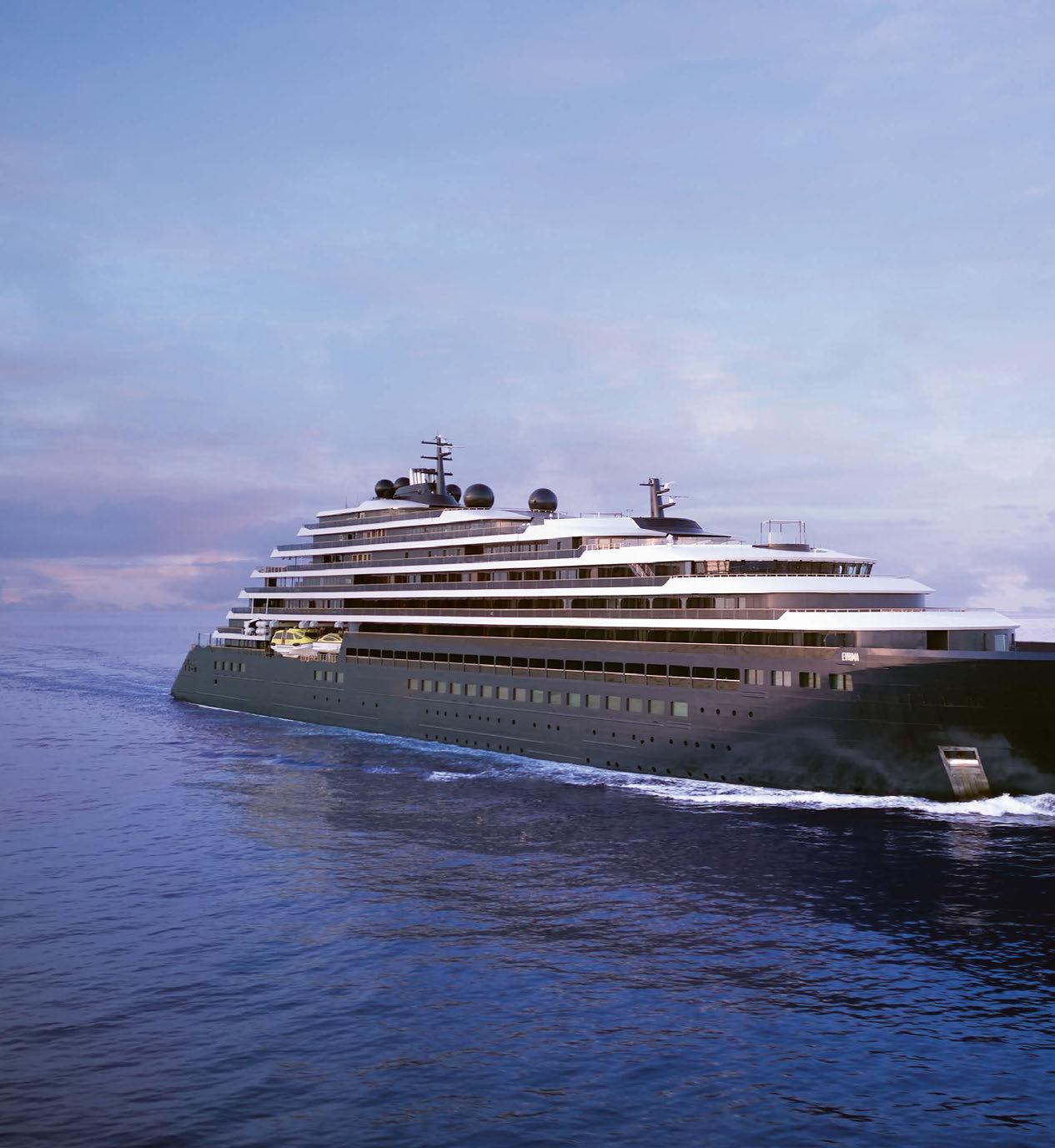
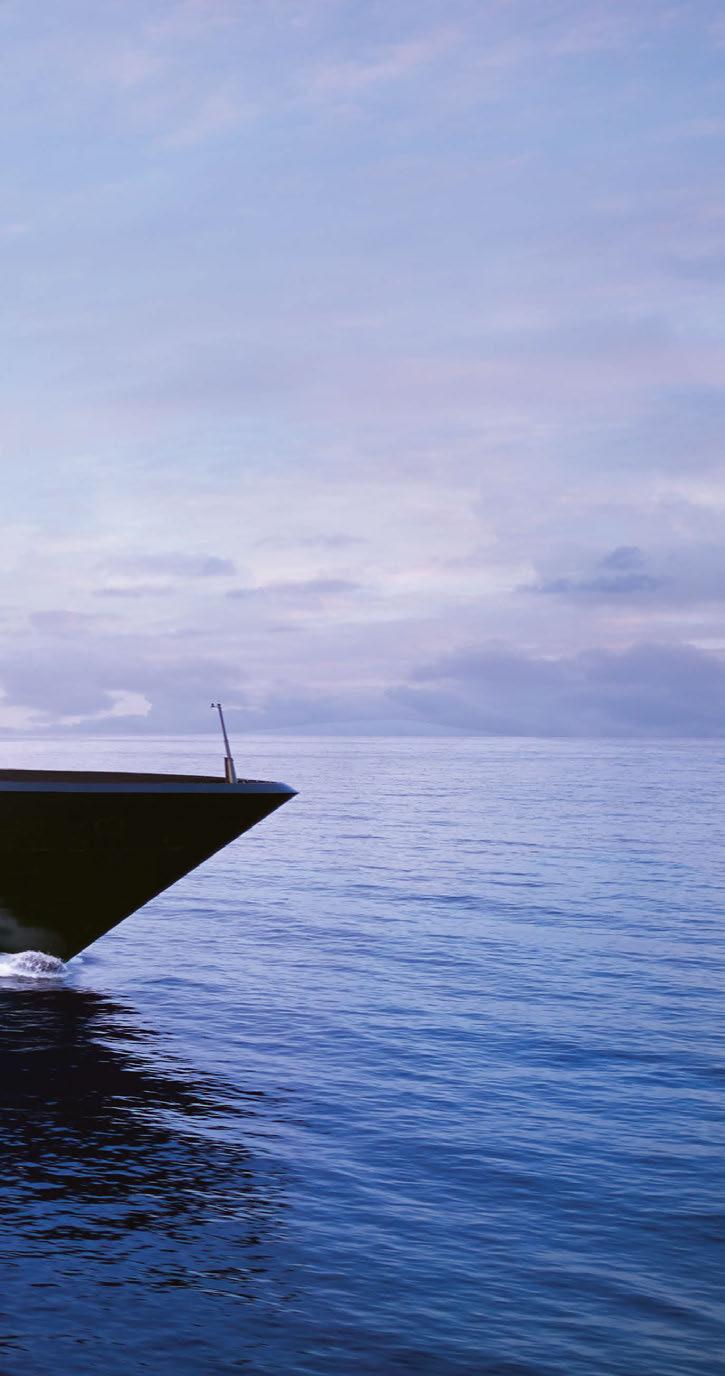
The Ritz-Carlton Yacht Collection makes its much anticipated debut, fusing the ethos of its hotels with the style of a superyacht.
At 190-metres, Evrima is pretty much the size of a small ship. But with its elegant silhouette and intimate atmosphere, it feels more like being on a private superyacht – which is exactly what Ritz-Carlton had in mind when devising the plan for its new yacht collection.
“The size and design of Evrima places us in a new space between ultra-luxury ships and superyachts,” explains Douglas Prothero, CEO of The Ritz-Carlton Yacht Collection. “Our brief was simple: to create a guest experience that was very much a yacht rather than a cruise ship experience.”
And with this being part of the much-loved Ritz Carlton brand, the company has essentially recreated its land-based ethos at sea. “Guests know what to expect even before they step on board,” continues Prothero. “The notion that we can also bring people into cruising who had never considered it before is very exciting.”
Nearly five years in the making, Evrima – the first of three yachts to join The Ritz-Carlton portfolio – has been a long time coming and she doesn’t disappoint. Designed by global engineering firm Ghenova, the yacht’s clean, sharp exteriors are a wealth of sleek lines that fluidly come together to form a graceful 10-deck arrangement that creates a sense of capability and efficiency while striking the right balance between beauty and functionality.
The Observation Lounge on Deck 10 features bi-folding windows that open the space up to panoramic views
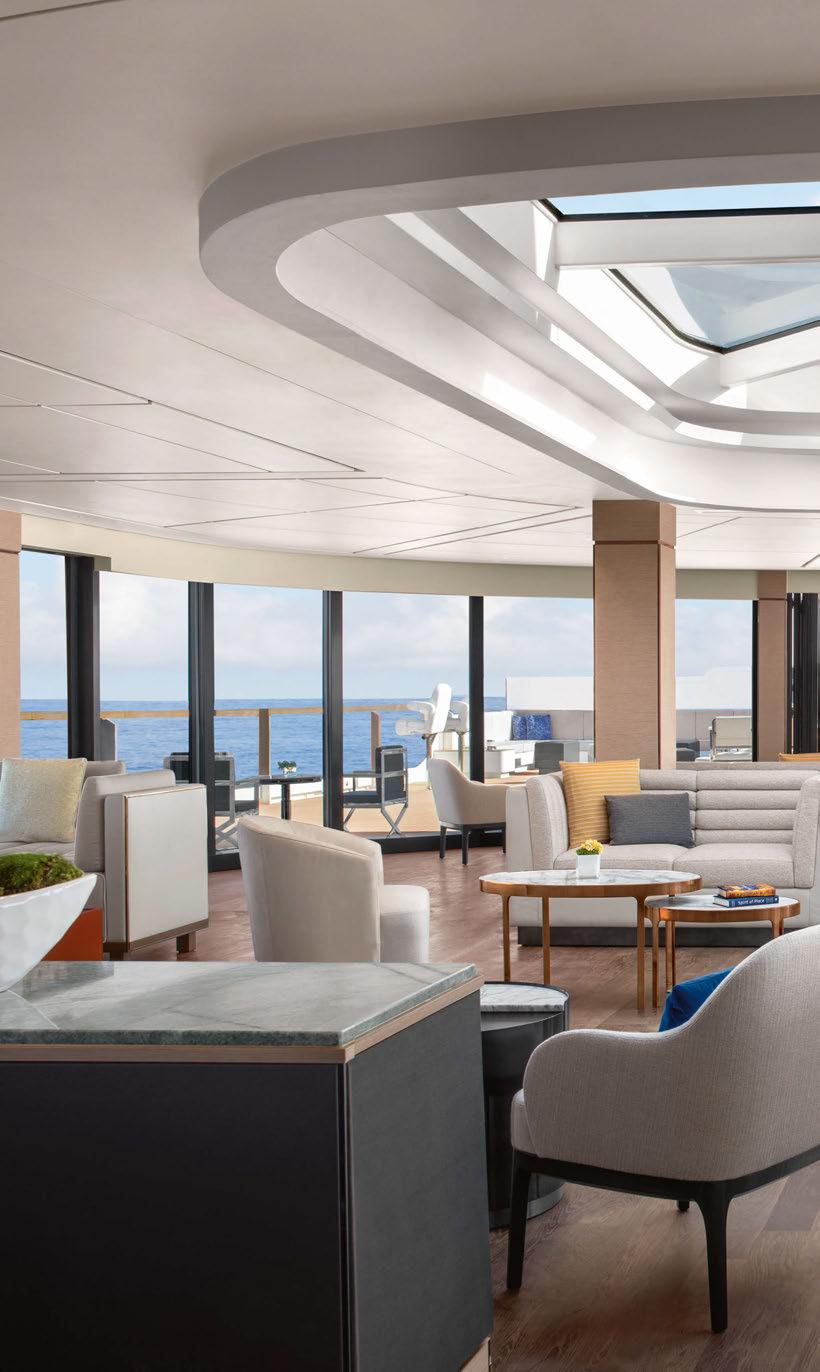
This striking aesthetic extends seamlessly to Evrima’s interiors. The work of Tillberg Design of Sweden together with Marriott International’s in-house design team, the yacht is unmistakably Ritz-Carlton and nothing has been left to chance. From the wonderfully tactile leather details to the plush furnishings in lowkey muted colours, there is a level of refined and understated luxury that takes its cues from some of the world’s most famous superyachts. “It was naturally important to create a visual link with The Ritz-Carlton land-based properties,” says Prothero. “We have fused the spacious and residential feel of these properties with the innovative marine design qualities of some of the most stylish yacht interiors.”
Taylor Cluff, Senior Interior Design Manager for Marriott International, elaborates: “The Ritz-Carlton brand is known the world over for exceptional quality. From a design

Interiors feature tactile leather details and plush furnishings in low-key muted colours, accompanied by a rotating exhibition of artworks
perspective that means we consistently provide a beautiful, refined interior with high-end finishes, thoughtful touches, and all the right details to create a sophisticated and luxurious environment.” This can be seen in the yacht’s artwork, which comprises 430 pieces made up of a mixture of permanent installations alongside a rotating exhibition – available to purchase –that changes according to the yacht’s itinerary.

Of the 121 original works, 62 pieces have been designed exclusively for Evrima, including a soaring installation by ceramicist Mo Cronenelisse that runs the height of the yacht all the way to Deck 10. There is also a stunning shell installation by artist Rob Plattel located in S.E.A. – Evrima’s fine-dining destination – which measures 3.5ft high by 20ft long and comprises individually hand-placed shells. “Rob came on board and personally placed each shell by hand – it’s that level of attention to detail that is a true design highlight for me,” notes Prothero.
Indeed, this level of detail covers everything,
from outstanding service – with around 260 employees, it has one of the highest staffto-guest ratios at sea – to a thoughtful layout. Unfolding over 10 decks, there are five restaurants, a glorious spa, a marina terrace for easy access to water sport activities, and only 149 suites accommodating up to 298 passengers. This means Evrima has some of the largest guestroom offerings in luxury cruising, which have truly been approached in an innovative way with a smart use of space and thoughtful, intuitive details. This is most evident with the Loft Suites, which are the result of the inability to create a private terrace on Deck 4, making instead for a two-storey solution with the bedroom on the lower level and a large balcony off the living area on the upper floor. “The most important element in a well-designed yacht is utilising space in a creative way to make sure you are really maximising what you have,” says Prothero. “As a part of this, it also means having design elements that are truly multifunctional.”
This is particularly true for the Observation
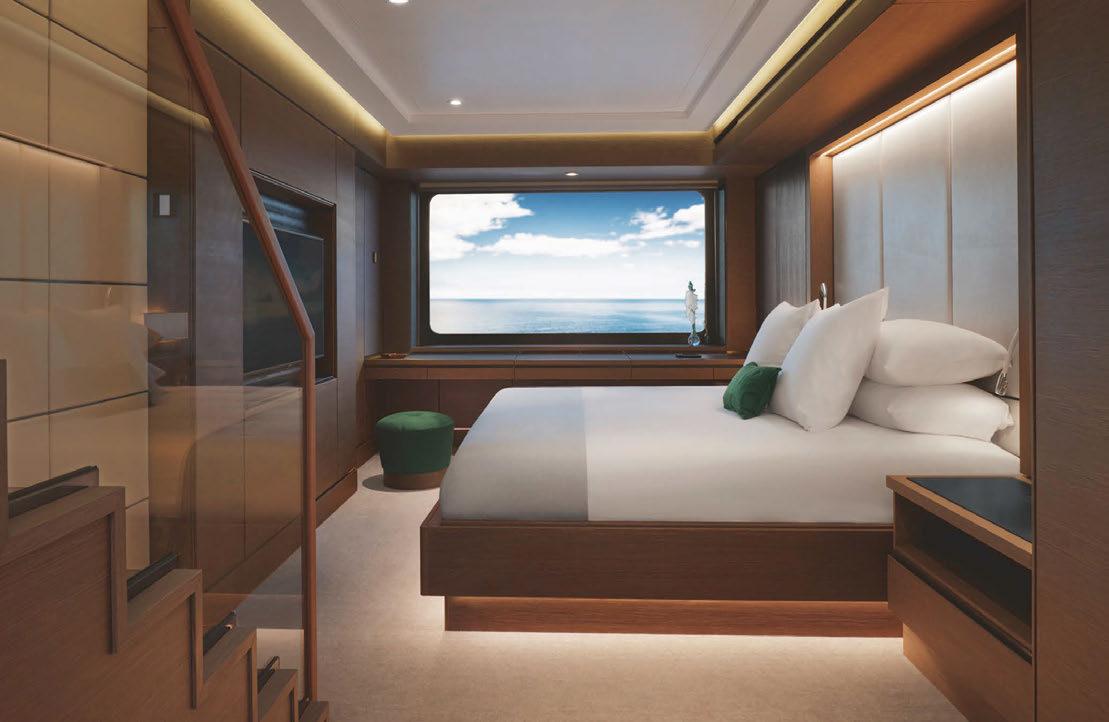
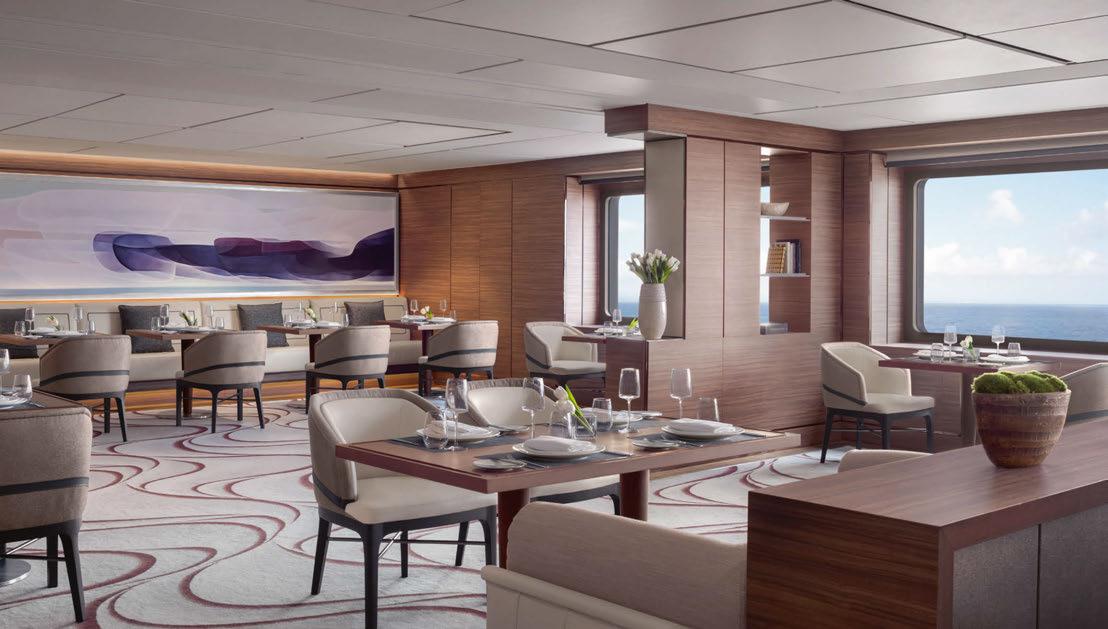
Lounge on Deck 10. With bi-folding windows that open the space up to panoramic views, by day the room is a quiet gathering place to read or watch the world go by, and by night it transforms into a late-night social hub, anchored by the bar and live music.

On Deck 9, there’s the fitness centre with a workout studio for daily classes, a barber and salon, an outdoor deck with a hot tub, and a tranquil spa with treatments such as the Natural Resilience Facial, which uses cutting edge pre and probiotic technology, as well as techniques inspired by Japanese Kobido.
Elsewhere, the five restaurants include The Evrima Room, an elegant space featuring a standout painting by artist Agneta Ekholm that stretches along its back wall; Talaat Naam, a laidback Asian dining room with a sushi bar; The Pool House, an open-air space located next to the main swimming pool, which serves an all-day menu of crowd-pleasing favourites from burgers to poke bowls; Mistral, an al fresco Mediterranean restaurant; and S.E.A., the
yacht’s fine-dining restaurant. Here, chef Sven Elverfeld of Aqua, the three Michelin-starred restaurant at The Ritz-Carlton in Wolfsburg, serves a seven-course culinary journey that features his signature caramelised kalamata olive, carabinero served with Marzano tomatoes, pine nuts and potato, and the delicious skinroasted sea bass fillet, which sits on a bed of radicchio risotto.
All this comes together to create an intimate and elevated base for leisurely Mediterranean and Caribbean cruises with immersive shore excursions, from walking through a lavender field to distil your own perfume to small group tours that take in some of the destinations’ most iconic sights in an exclusive way, like browsing through a world-class museum with its curator, or visiting a UNESCO World Heritage site before opening hours to beat the crowds.
In other words, nailing the brief to carve out an exclusive space within the industry that perfectly places Evrima between ultra-luxury cruise ships and superyachts.
Maiden Route: Sète to Barcelona
Maiden Voyage: October 2022
Operator: The Ritz-Carlton Yacht Collection Investor: Oaktree Capital Management Architecture: Ghenova
Interior Design: Tillberg Design of Sweden, Marriott International in-house design team
Shipyard: Hijos de J. Barreras www.ritzcarltonyachtcollection.com

Aqua Expeditions enhances its fleet with an intimate, seven-cabin superyacht that sails the Galápagos.
 Words: Lauren Ho • Photography: © Stevie Mann
Words: Lauren Ho • Photography: © Stevie Mann
In Academy Bay, the waterways are teeming with life. Bordering Puerto Ayora, the largest and most populated town in the Galápagos, on the southern edge of Santa Cruz Island, the radiant turquoise waters see yachts, fishing trawlers and sailboats bobbing gently up and down on the waves. Amid this jumble and a raft of frolicking sea lions, Aqua Mare stands out from the crowd.
The first true superyacht in the Galápagos, the vessel is the latest to join the Aqua Expeditions fleet, which comprises four other ships that sail the Amazon and Mekong rivers, as well as the pristine East Indonesian Archipelago. The company was founded by Francesco Galli Zugaro, who has made it his mission to connect guests to the destinations they sail, whether that be through the interior design, the dining or the off-the-beaten-track excursions that form part of the multi-day itineraries. Having launched the small-ship expeditions company with the 16-suite Aria Amazon in 2011, expansion has been moderate, with Galli Zugaro and his wife Birgit actively involved in every aspect of the design and development. Aqua Blu launched in 2019 followed by Aqua Nera in 2021, and like her sisters, Aqua Mare is a beauty to look at, her sleek exterior hinting at the understated luxury that awaits inside.
Previously privately owned, the yacht was the simple answer to the lengthy waiting times of delivering a newbuild. “Francesco and Birgit had been thinking, dreaming and working towards a yacht in the Galápagos for a long time,” explains the group’s interior design consultant, David Cole. “We did have a full set of plans and designs ready for a newbuild, however the decision was made to try and speed

Polished walnut veneer panelling contrasts with natural fabrics in a palette inspired by the colours and the textures of the Galápagos
up the process and purchase an existing ship if a suitable yacht could be found.”
Indeed, sourced by Francesco and Birgit’s son, Massimo, the 50-metre yacht perfectly fits Aqua Expeditions’ luxuriously low-key, intimate ethos, with space for just 16 guests and 16 crew, including two naturalist guides. Built by Ancona-based shipyard CRN in 1998, she has 30% more indoor space than most yachts her size and unfolds to include seven spacious cabins – one being the 80m2 Owner’s Suitea beach club, three indoor and outdoor dining areas, including a barbecue area that is used as a workout space in the early mornings, and a sundeck with a shaded six-person whirlpool.
While acquiring a ready-made ship was ideal, it still came with the challenge of transforming her from a private yacht to a passenger one, without losing the glamour and luxury that Aqua Expeditions guests have come to expect. Of course, with the yacht already in superb condition, and with naturally great bone structure, little was needed by way of
renovations, bar a few tweaks such as converting a former living space into a dining room. “The spaces on Aqua Mare work so well,” says Cole. “Even with a full complement of guests, she never feels overcrowded; the public spaces span indoors and out, while in the private quarters, bathrooms are very large for a ship and there’s plenty of storage.” Even the crew spaces get an upgrade from the norm. “I love the galley with its large windows, it keeps morale up – it’s always good to keep the chefs happy!” he quips.
The original interiors are the work of prolific superyacht designer François Zuretti and his team, whose extravagant aesthetic is revealed through rich details, from silk curtains and tie backs to an excess of heavy furniture. This, as Cole says, is a change in pace from the modern, simpler look of Aqua Expeditions’ other vessels, and so some revisions were required. “The interior vision for Aqua Mare comes very much from Birgit,” he continues. “As Director of Aqua Expeditions, and my co-designer, she has a very defined vision of what she wants for the Aqua



Expeditions persona, so together we approached the design by paring back and simplifying the existing decoration.”
The result makes use of the yacht’s original polished walnut veneer panelling, contrasting with natural fabrics in a palette inspired by the colours and textures of the Galápagos. Interiors are dressed with stone tables, luxurious Jim Thompson fabrics for the wallcoverings and soft furnishings, and artwork from the 1700s obtained from antiquarian shops in New York, which give a feel for Darwin’s era. There’s bespoke lacquer tissue boxes, a collection of books relevant to the destination, and as with other Aqua Expedition ships, tableware from Indonesian ceramic brand Gaya, designed with the destination in mind and featuring details like gold and platinum lava flows, or the number 1835 in reference to the year Darwin visited the islands.

“For me, as in all design, it must function,” says Cole. “What we do when designing, is to make a luxurious interior comfortable and
inviting, not intimidating, but intimate and cosy. We want guests to feel they are boarding a private yacht without having to pay for the entire boat. You will be hard-pressed to find any superyacht in the world that you can book by the cabin or charter.”
As for Cole’s favourite space? “My favourite cabin is number 301, which is the yacht’s smallest and located on the bridge of the deck. The window here is huge, taking up most of the wall, so you can lie in bed looking at the ocean. It’s magical.”
This, alongside two custom-made black military-grade zodiacs with low-emission engines, and a collection of toys from kayaks and stand-up paddle boards to scuba gear, makes Aqua Mare the perfect base from which to enjoy the wonders the Galápagos Islands has to offer. “I enjoy working with a small group of people with the same goal and a desire to create something wonderful,” Cole concludes. “It’s so gratifying to see everyone’s work come together into a cohesive and beautiful product.”
Route: Galapágos Islands
Owner / Operator: Aqua Expeditions
Interior Design: David Cole, Birgit Galli Zugaro www.aquaexpeditions.com
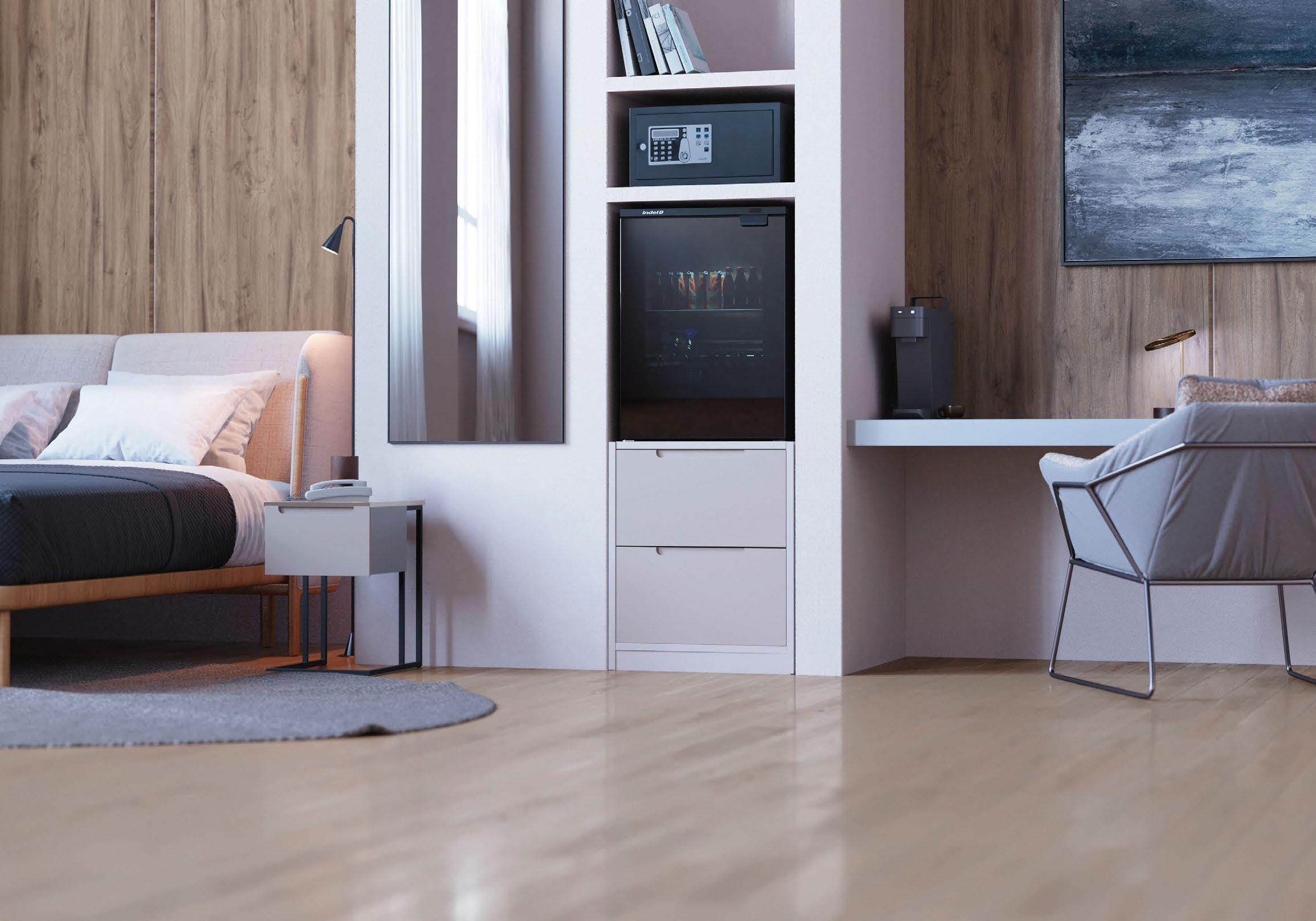
For its first new ship in a decade, Disney channels a sense of enchantment to create a fairytale castle on the seas.
Words: Ayesha Khan Photography: Courtesy of Disney Cruise LinePrior to 2022, The Walt Disney Company successfully operated four impressive cruise liners, each a magical experience based on the success of the entertainment conglomerate. While Magic (1997), Fantasy (1999), Dream (2011) and Wonder (2012) all feature generous cabins and well-designed spaces, the forward-thinking operator sought to join today’s cruise ship race with a new offer. To bring a fresh perspective, they enlisted Portfolio Creative Executive Laura Cabo, a trained architect and key voice in the company’s Imagineering arm – the creative engine that designs and builds all Disney theme parks, resorts and attractions. “I didn’t really know much about cruise ships,” Cabo admits of her appointment, but she was up for the challenge. “To create a city that is entertaining people while in motion was fascinating to me. My task was to be the lead storyteller, illustrating what makes Disney ships unique.”
For this long-awaited venture, Imagineering conducted a series of blue sky brainstorming sessions, exploring potential themes that encapsulate the magic of Disney. They eventually came up with the concept of enchantment, and chose to tell the story through a cast of female characters –all stars of Disney classics – who use a sprinkle of magic to chart their own course.
The first in this new fleet of ships represents Cinderella, a Disney icon who overcame adversity to live happily ever after. It all begins in the Grand Hall, where the rags-to-riches princess stands defiantly at the bottom of the cantilevered


Surrounded by elegant curio cabinets featuring sketches and maquettes from Disney classics, restaurant 1923 is a love letter to the studios
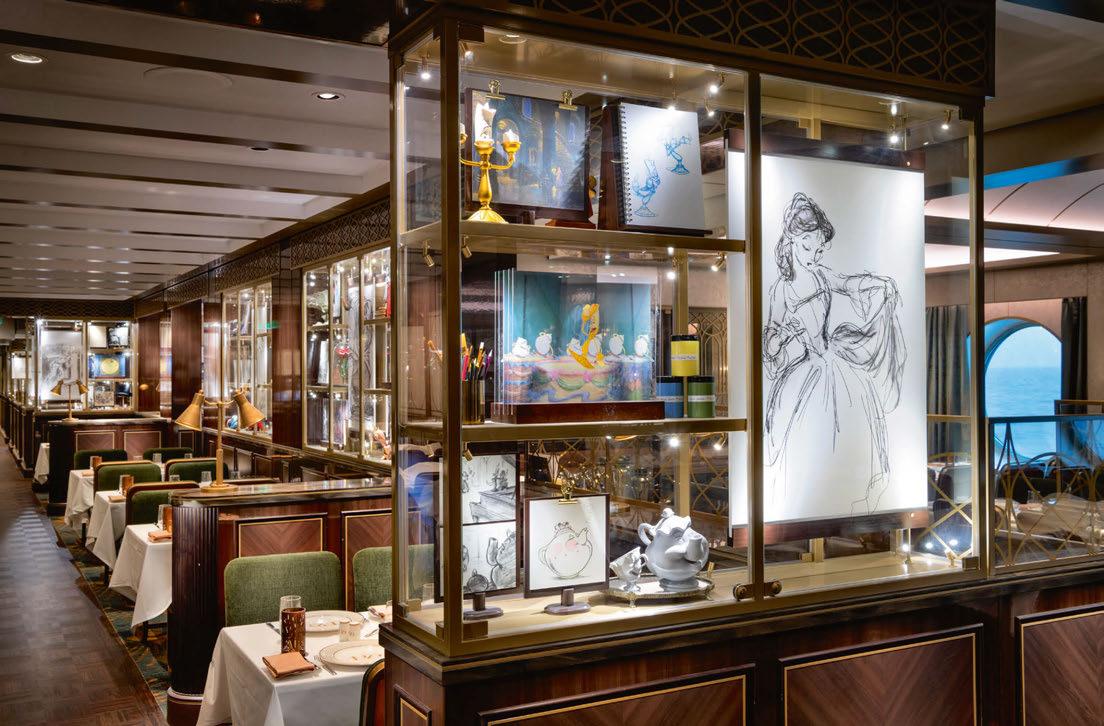
winding stair. “If you look at our theme parks, they all have an icon who resides in the castle,” explains Cabo. “We wanted to translate this idea to Wish, so the Grand Hall has become Disney Cruise Line’s castle on the seas.”
Evoking the same sense of wonder as the fairytale castle, the triple-height space features undulating balconies wrapped in swirling tendril motifs. Between them, sweeping columns branch off up the ceiling and, with the wave of a magic wand, reveal thousands of twinkling fibre-optic lights. The drama culminates in a captivating chandelier that, as Creative Director Claire Weiss reveals, has a very interesting genesis.
“It is inspired by Cinderella’s dress,” she explains. “There’s a well-known scene in which the Fairy Godmother transforms Cinderella into the belle of the ball, creating a beautiful spiral of magic – that shape is the exact structure of our chandelier.”
One of Cabo’s mandates on this project was to extend specific Disney-owned intellectual property (or IP) overlays beyond the designated childrens’ areas, ensuring that mature guests still get a feel for the sense of magic. “The adult spaces are beautiful
on existing ships but they don’t always speak to the Disney story. We want to offer everyone a portal into our world and realised that we could do it in an elegant and sophisticated way,” Cabo says. This begins at the ship’s central bar, The Bayou, which tells the story of The Princess and the Frog. “It is a grown-up take on an enchanted bayou,” Weiss explains, adding that her favourite feature is the canopy of greenery and magnolia flowers overhead. Other surprises include a band of fireflies that flashes through the course of an evening, and the back-bar artwork featuring the skyline of New Orleans as seen from Louisiana’s famed Bayou Country.
Disney’s recent purchase of the intellectual property for Star Wars meant that the Imagineering team had a whole host of more masculine-themed spaces to draw inspiration from. Hyperspace Lounge takes guests on a journey across galaxies by way of an interactive screen designed to look like the windshield of a Star Wars space vessel. “This is our first immersive lounge where guests feel like they are part of the story,” says Daniel Handke, the Senior Creative Director who led the design of IP-infused entertainment zones aboard
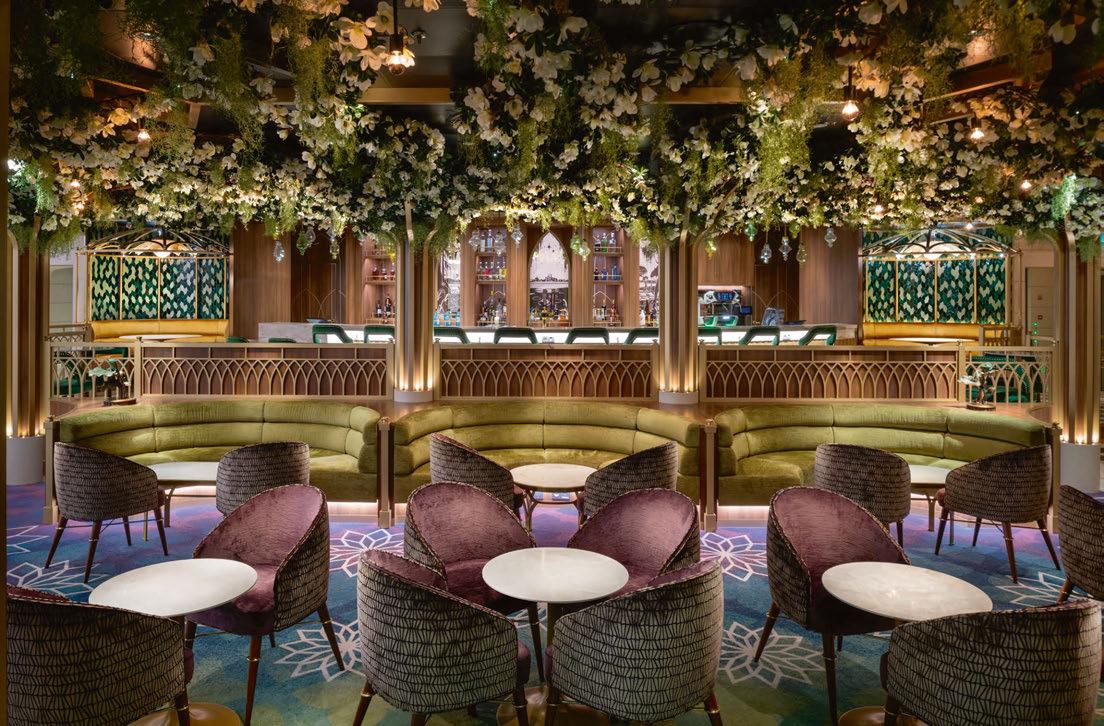
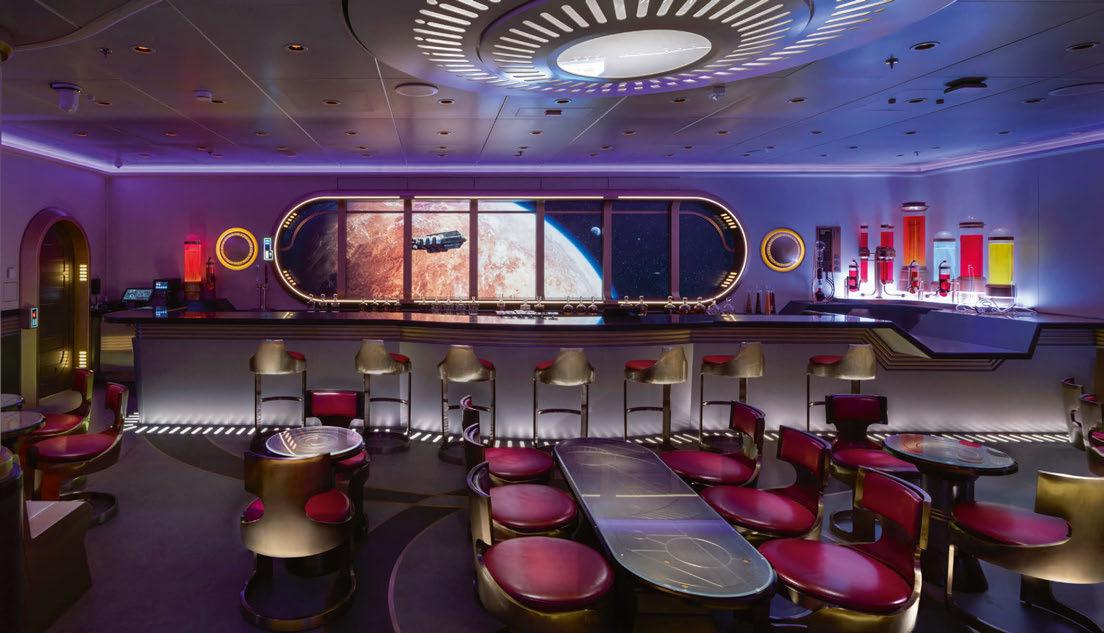
Wish. “It’s an extremely popular space featuring slick antique brass details and fun alien lounge music. Every seven minutes, the scenery through the viewport window changes and you feel like you’re rocketing through space,” he reveals with palpable excitement.
To ensure the dining experience on this ship is like no other, the creative team chose to tell three unique stories. In Arendelle, a theatrical eatery based on Frozen, the design details transport guests to the magical kingdom, where an impressive banquet hall features a live show from Elsa, Anna and Olaf. Worlds of Marvel meanwhile serves international cuisine to the backdrop of an action-packed Avengers mission. “We observed that technology is a thread that ties all the Marvel stories together, so we created a technology showcase,” says Handke. “The idea is that Tony Stark helped build the space, with his slick, upscale design aesthetic featuring metal, glass and polished stone.” With no less than 97 television screens and 150 interactive Quantum Cores, it’s
undoubtedly an immersive experience. And for the design of 1923 – named for the year that brothers Walt and Roy Disney founded their eponymous company – the Imagineering team sought to create what Cabo describes as “a love letter to Disney Animation Studios”. Diners are surrounded by elegant curio cabinets featuring sketches and maquettes from beloved Disney classics. Cabo recalls a touching moment when Pixar and Disney Animation Studios Creative Director Roger Gould visited the restaurant and was overcome with emotion – a sure sign that the narrative hits all the right notes.
“Working on a Walt Disney project is like getting a PhD in storytelling,” concludes Cabo as she credits all the departments – from Industrial Engineering to Entertainment to the German shipyard Meyer Werft – who collaborated to make this dazzling castle at sea a reality. Disney will launch two more ships in the coming years, which will continue the theme of enchantment and tell unique, immersive stories to be enjoyed by children and adults alike.
Route: Caribbean
Maiden Voyage: July 2022
Owner: The Walt Disney Company
Operator: Disney Cruise Line Flag State: Bahamas
Architecture and Interior Design: Walt Disney Imagineering Shipyard: Meyer Werft www.disneycruise.disney.go.com
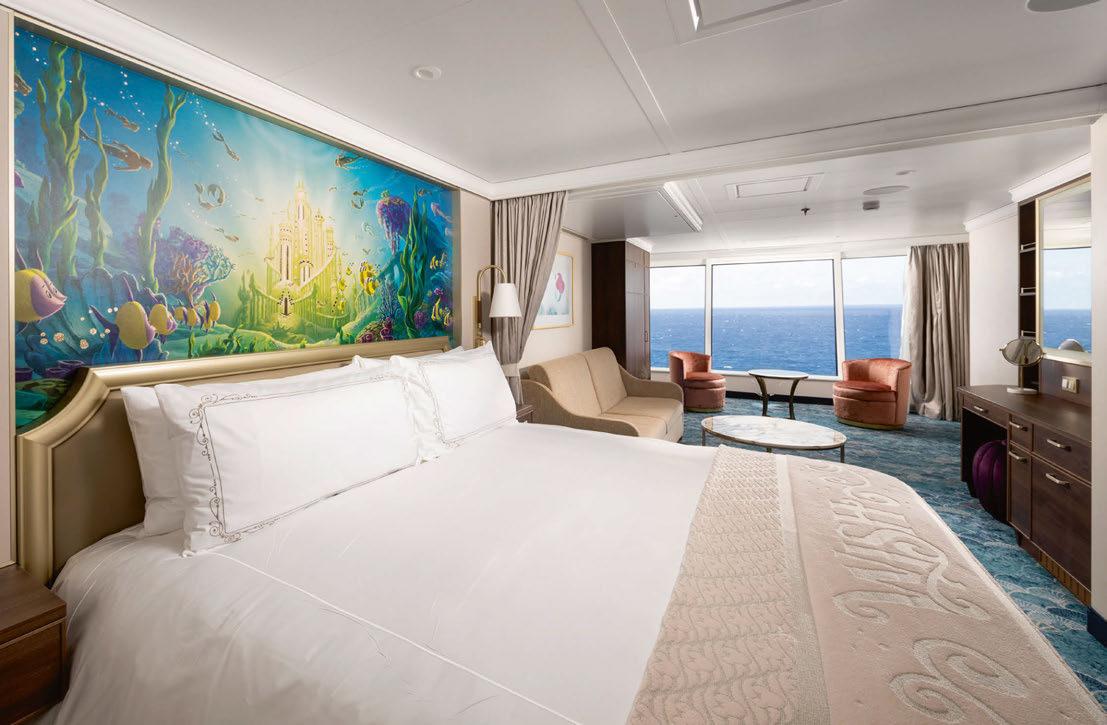
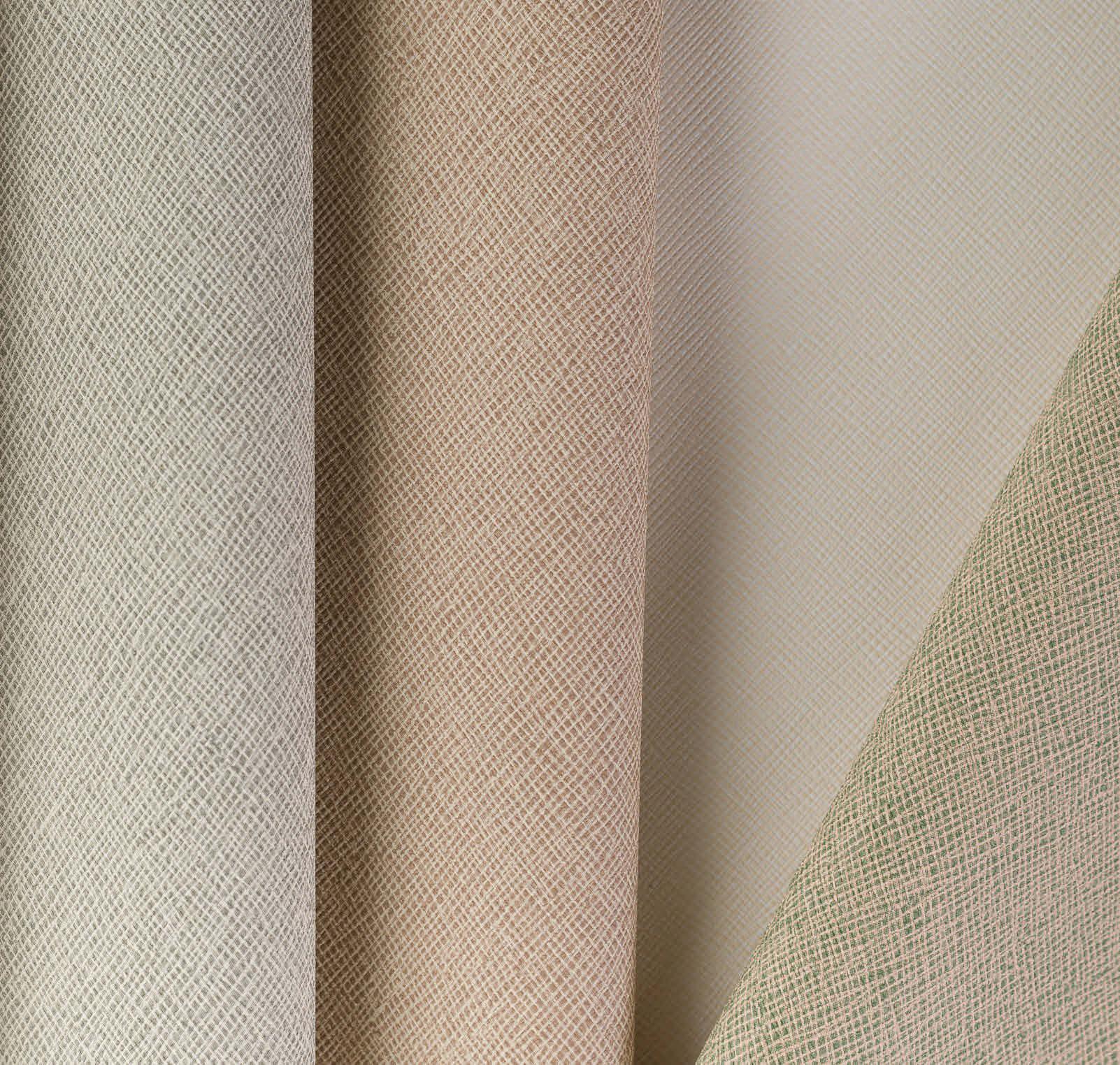

Cruise Ship Interiors Expo Europe will return to Excel London from 30 November to 1 December, with the exhibition once again joined by Cruise Conversations Live, a two-day conference programme exploring challenges and opportunities across the sector.
of Disney Cruise Line will talk through their respective approaches to storytelling in the development of design concepts.
Speakers include (clockwise from top left): My Nguyen, Holland America Group; George Scammell, Princess Cruises; Mike Lambourn, PriestmanGoode; Trevor Young, MSC Cruises; Jennifer de Vere-Hopkins, Jestico + Whiles; and Vesa Uuttu, Royal Caribbean Group
While the main stage will tackle major themes such as the future of cruising, a series of intimate workshops taking place on the show floor will delve into the finer details. Day one opens with a suppliers’ guide to breaking into the marine market, with Royal Caribbean Group’s Beatrice Siri talking through routes to market, pitching to cruise lines and IMO requirements. A later workshop led by Mike Lambourn from PriestmanGoode and Trevor Young from MSC Cruises will venture into the design of multifunctional, while the main stage will play host to keynote speaker Richard Van Hooijdonk, as he joins George Scammell of Princess Cruises explore what the cruise sector might look like in 2030. Closing out day one, Jennifer de VereHopkins of Jestico + Whiles and Laura Cabo
Day two of the programme includes an open discussion on sustainable materials and recycling initiatives, followed by an interactive session demonstrating why environmentallyfriendly choices also make good business sense.
Elsewhere, Vesa Uuttu, Head of Architectural Design & Outfitting at Royal Caribbean Group, will host a panel on innovation in the shipyard, while Designing for Gen Z will offer insight into cruising amongst the younger demographic.





Cruise Ship Interiors Expo Europe will also showcase the products and services of over 300 exhibitors, while social events – including a speed networking breakfast supported by Starboard – will provide ample opportunity for networking. The event will close with the CSI Awards, which recognise excellence across shipyards, cruise lines, design firms and suppliers. To register for tickets, visit: www.cruiseshipinteriors-europe.com


LONDON
Speakers include (clockwise from top left): Callie Tedder-Hares, Volume Creative; Petra Ryberg, Studio Berg+; Tom Hupe, Hilton Worldwide; Adrian Berry, Factorydesign; Luke Pearson, Pearson Lloyd; and Kirty Dias, PriestmanGoode
Sustainable Design Summit – a new event that brings together the cruise, hotel and aircraft sectors to find sustainable solutions for interiors – is set to make its debut in November, with a series of talks and roundtable discussions encouraging cross-sector insight and learning.

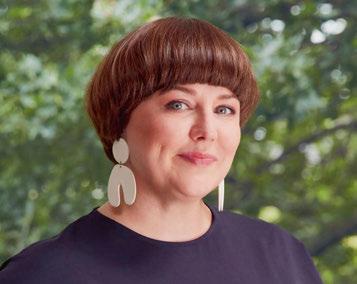
Taking place at The Brewery in London, the full-day programme features a variety of speakers – all leaders in their respective fields – who will share their own approach to making sustainable choices. Setting the scene, an opening keynote entitled One Planet One Mission will examine the common challenges across air, sea and land-based interiors, with speakers including design and sustainability experts from Accor, MSC Cruises, Seymour Powell and Tangerine.
Also on the agenda, Pitching to Stakeholders will offer practical tips on how to drive sustainable decisions at both project and board level. Speakers include Luke Pearson, co-founder of forward-thinking design studio Pearson Lloyd; Thomas Westergaard, consultant


for Hurtigruten Expeditions; and Tasha Jackson, Sustainability Lead at Boeing.


A session dedicated to net zero will cover the role of cabin interiors in reaching sustainable aviation goals, while the closing remarks aim to set out best-practice intentions for both designers and suppliers.
Throughout the day, breakout and roundtable discussions will provide an opportunity to discuss the challenges unique to each sector, with My Nguyen, Director of Interior Design for Holland America Group, taking the lead on the cruise side, and Hilton’s Tom Hupe, Senior Director of Design & Architecture EMEA, guiding on hotels.
The event will also include a product showcase featuring a gallery-style display of innovative and sustainable products, essentially bringing the ideas discussed to life and providing a platform for sustainable design in the hotel, cruise and aircraft cabin sectors. For further information and to register for tickets, visit: www.sustainabledesignsummit.com

“I find that the CSI Plus platform is innovative and is getting better and better, creating ways to engage with potential prospects in a productive atmosphere online.”
Andrie Iglesias – Co-Founder, Andriali Contract
“It’s a great place to both meet new people and companies and get introduced to new technology and products as they come to market.”
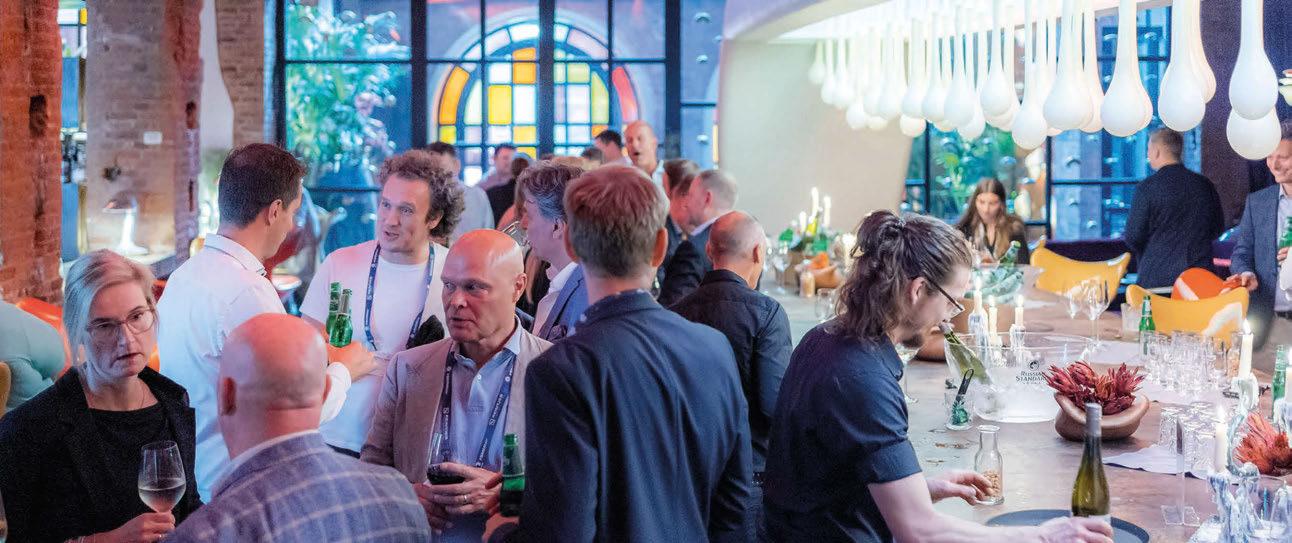
Matt Easton – Hotel Refurbishment Manager, Marella Cruises
“Fantastic events. Worth every penny of our membership.”
Robert Wilkin – Business Development Manager, Baker Bellfield

“I had a month’s worth of key account meetings in just over 1 hour at the last Community Networking Hour!”
Steven Davies – UK Sales Manager, Waterbury Bathrooms
“CSI Plus provides great opportunities to network with both clients and the wider supply chain.”
Karen Argue – Business Development Manager, The Deluxe Group
As the sector looks to build on the postpandemic recovery of recent months, Seatrade Cruise Global has announced the theme of Forward Momentum for its forthcoming edition.

Taking place from 27-30 March 2023 at the new venue of Broward County Convention Center in Fort Lauderdale, the event will focus on the future of cruising, and what the momentum means for cruise lines, passengers and destinations. Topics up for discussion include sustainability, technology and innovation across both refurbishment and newbuild projects, plus specialist sessions will delve into interior design, luxury travel and expedition cruising.
Running alongside the conference, the newly expanded show floor will host 500 exhibitors ranging from ports and destinations to products and services. The event typically attracts over 8,000 attendees from across the sector, with the likes of Carnival Corporation, Norwegian Cruise Line and Royal Caribbean Group all represented.
The 2023 edition will also mark the debut of F&B@Sea, an immersive two-day event
dedicated to the onboard food and beverage experience. Featuring a marketplace of curated vendors, live cooking demonstrations from top chefs and mixologists, and interactive content hosted by industry leaders, the new launch will offer cruise and culinary professionals the opportunity to tap into emerging trends.
The venture is the result of extensive research by Seatrade, which found that the global food and beverage market is expected to be worth US$6.4 trillion by the end of 2022 and US$8.9 trillion by 2026. Having identified increased demand for culinary-focused programming, Seatrade believes the time is right for a dedicated event, a move that has been welcomed by the cruise community. “Seatrade’s expansion represents a huge win for all F&B professionals in the cruise sector,” comments Rudi Sodamin, Master Chef, Holland America Line. “This premiere promises to serve up a generous helping of inspiration to bring our F&B outputs to the next level.” www.seatradecruiseglobal.com www.seatradecruisefnb.com



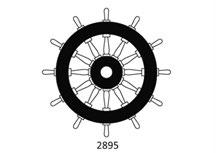



Volkswagen Group unveils a new prototype that offers the freedom to work, rest and play within the bounds of an all-electric IEV.
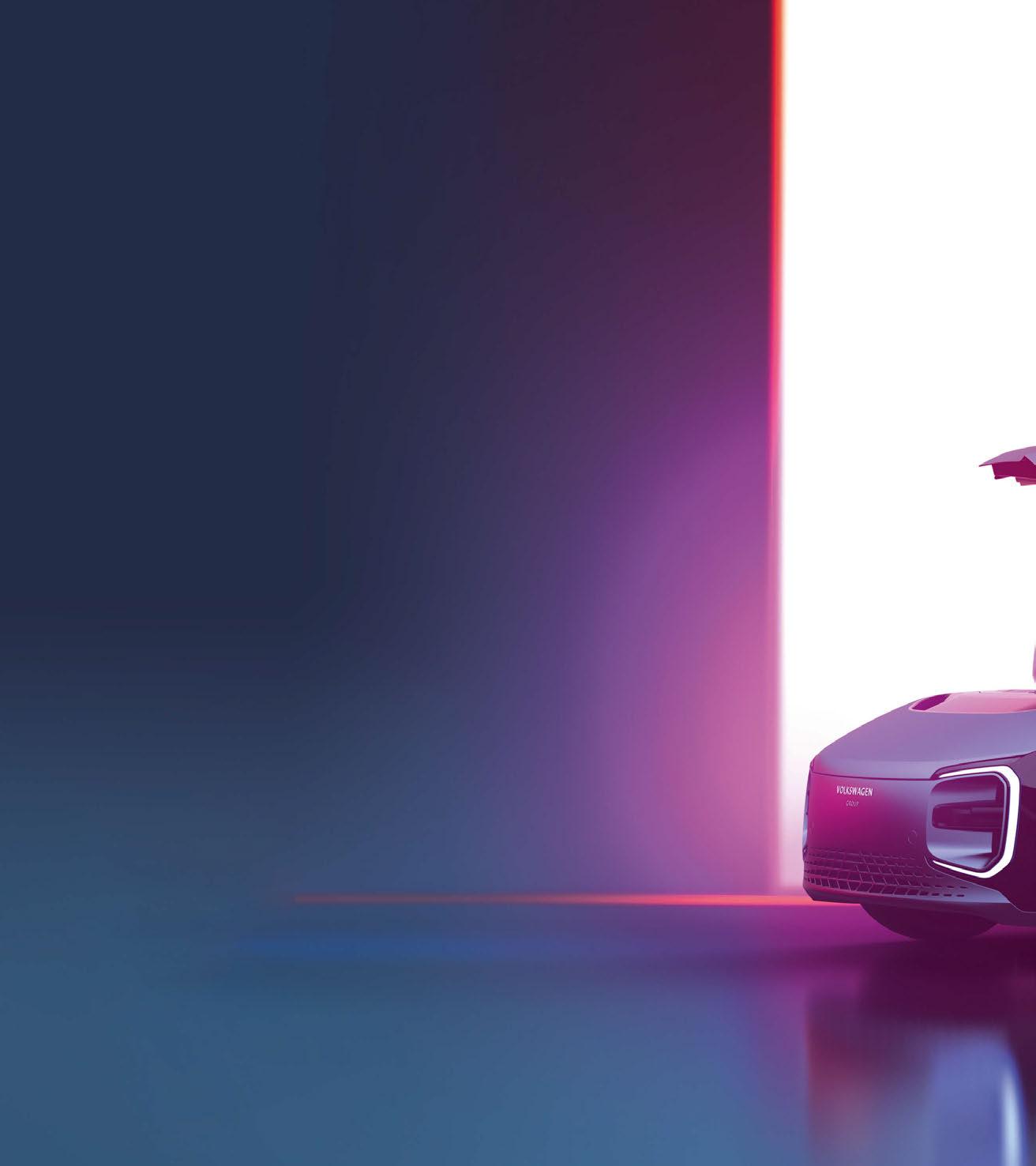
The future of mobility on land is arguably the most compelling of all transport settings, with new vehicles having the greatest potential to impact daily life. As a result, countless automobile manufacturers have been developing forwardthinking models that cater to the next generation of travellers, whether on a cross-country road trip or the daily commute.
Volkswagen Group is the latest to present a new prototype, describing it as an innovative design study that will redefine long-distance mobility. The all-electric Innovation Experience Vehicle (IEV) drives autonomously and features a modular interior that serves multiple purposes, making it a flexible Mobility-as-a-Service alternative to short-haul flights. It forms part of the Gen.Travel study, the aim of which is to test new concepts and functionalities, with the top features set to be incorporated into forthcoming models. “With its New Auto strategy, Volkswagen defines the mobility for generations to come – sustainable and digital,” says Dr Nikolai Ardey, Head of Volkswagen Group Innovation. “We are further advancing this idea, showing how our customers will be able to experience mobility in the future –for example, as a service.”
The vehicle comprises a transparent cabin atop a base that houses the technical features, with extra-large windows to maximise the views. Inside, the cabin can be customised for each journey: for business trips, the conference set-up offers four comfortable seats positioned around a
central table, while family groups can configure the layout to entertain children using augmented reality. There’s an overnight set-up too, allowing the conversion of seats into beds that can be folded out to a fully-flat position. The design team has also developed a dynamic lighting scheme with multiple settings, while all human-machine interface elements are produced using sustainable, natural or recycled materials.
“The Gen.Travel offers us a glimpse into travel of the future,” explains Klaus Zyciora, Head of Volkswagen Group Design. “Efficient shaping characterises the extremely distinctive design. Thus, in an age of technical perfection and virtually unlimited possibilities, form follows function becomes form follows freedom.”

Hyundai opens the doors to the world’s first carpowered hotel.
With carbon footprint a growing concern amongst holidaying Brits, some forwardthinking hoteliers have been coming up with one-of-a-kind staycations that don’t involve travel on fuel-guzzling transportation to get there. Cabins, campervans and luxury glamping experiences have popped-up across the country, but perhaps the most innovative approach comes from Hyundai. Having commissioned research on consumer travel habits, the motor company found that nearly half (46%) of those surveyed said sustainability is more important than ever when booking a holiday, and a further quarter (25%) are choosing staycations over flying abroad in a bid to reduce their carbon footprint.
In response, Hyundai has created an off-grid travel experience, billed as the world’s first car-powered hotel stay. Located on Colemans Farm in the Essex countryside, the three-week pop-up centres around a luxury cabin, in which every element – from the lights to the kettle – is powered by the all-electric IONIQ 5 through its Vehicle-to-Load (V2L) technology.

The experience has been curated by broadcaster and critic Grace Dent and features
all the mod-cons of a boutique hotel as well as environmentally-friendly touches such as furnishings made from recycled plastic. The camp also has its own food and beverage offering serving locally-sourced cuisine. And demonstrating the true capability of the IONIQ 5, there’s even a cinema with car-powered projector, speakers and popcorn machine.
“Our award-winning IONIQ 5 is able to power Hotel Hyundai using its V2L feature, where an adapter from the car provides a socket which domestic appliances can be plugged into,” explains Ashley Andrew, Managing Director, Hyundai Motor UK. “The whole experience demonstrates the practicality of this pioneering technology, and we hope the concept inspires more people to go off-grid.”
Dent concludes: “We’re looking for unique, memorable stays more now than ever and this is a delicious blend of innovation, luxury and comfort that gets you thinking. With power coming from the car, where could Hotel Hyundai pop-up next? I hope this is just the start for this concept of a car plugging-in and powering a luxury experience.”
Audi addresses the drawbacks of city life with a car that serves as a living space during the daily commute.
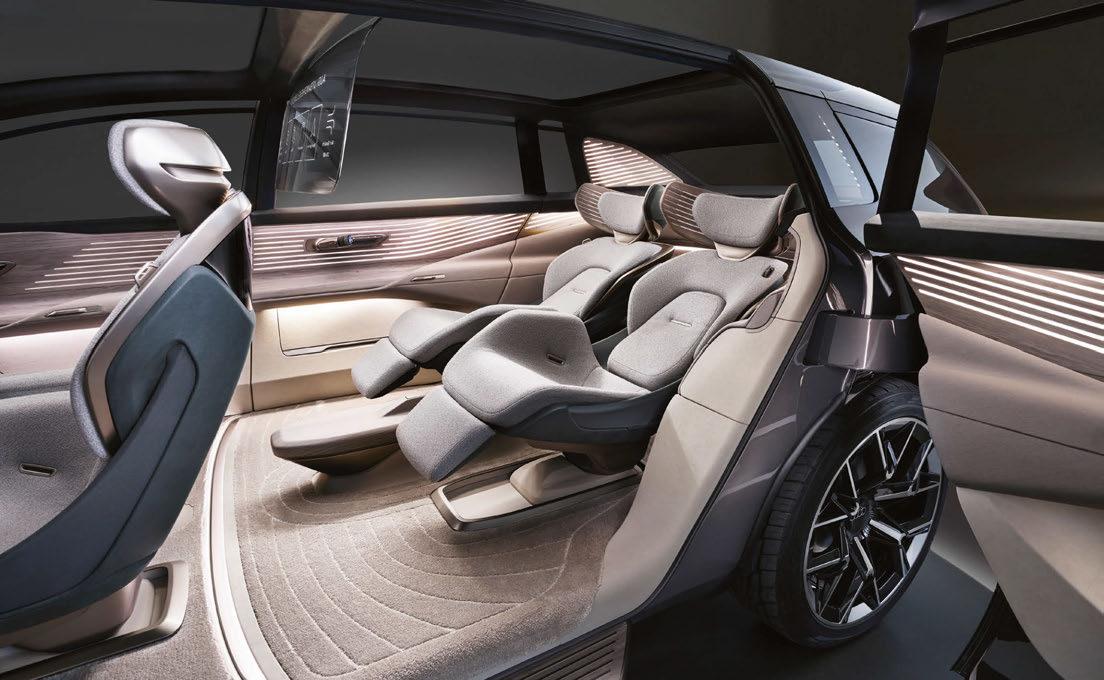
Whiling away the hours in lengthy traffic jams is never an appealing prospect, particularly when time could be better spent elsewhere, but for those living in major metropolitan centres, being bumper-to-bumper is very much a reality. In order to make the daily commute a little more enjoyable, Audi has revealed its vision for the future of urban travel.
Initially developed for the Chinese market – where congestion is amongst the worst in the world – the Urbansphere is a spacious concept car that goes beyond the purpose of getting from A to B, acting as a third living space that sets a benchmark for the passenger in-vehicle experience.
As the largest in the Sphere family – at 18ft-long and 6.6ft wide – the new model breaks with convention, prioritising space above all else to create a lounge on wheels. Automated driving technology transforms the interior in which a steering wheel, pedals and displays are notably absent, while seating is flexible dependent on needs. In relax mode they recline by 60-degrees; for social settings they swivel to face one another; and for privacy, a cocooning screen extends from the headrest.
The innovation continues with a transparent OLED screen that pivots vertically from the roof, creating a cinema set-up to stream entertainment and music. And thanks to the integration of technology, the vehicle takes care of everyday tasks such as making dinner reservations and shopping online. It also has the capability to collect passengers direct from their door, tracks down parking spaces and knows exactly when to charge its battery.
Designers have considered lighting and the use of materials too, opting for upholstery and surfaces that are natural, sustainable or recycled; the seat padding is made from Econyl for example, and bamboo viscose is used in the armrests.
The Audi Urbansphere was first on show at Milan Design Week, where a collaboration with Poliform saw the Italian furniture manufacturer present its vision for the interiors, bringing its signature style and handcrafted details to the automobile sector. So whether it’s used as an office space or a wellness hub, the Audi Urbansphere might just make the daily commute a time to cherish.
Hotelier Vasyl Grogol looks to bring the beauty of US road trips back to life.
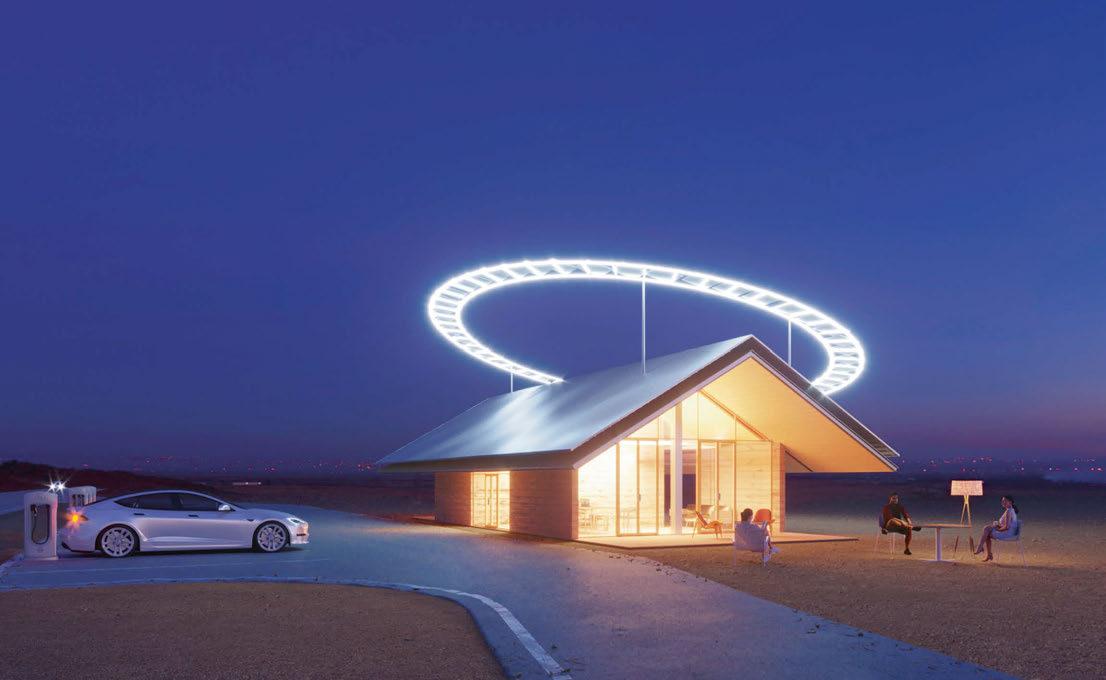
Having shaken up Kyiv’s hospitality scene with Bursa, a Design Hotels member that is both a place to sleep and a hang-out for the city’s creatives, Vasyl Grogol is now on a mission to revive roadside hospitality in the US.
The forward-thinking entrepreneur – whose project in the Ukrainian capital takes inspiration from the bohemian vibe of New York’s Hotel Chelsea – is hoping to reinvent the outdated motel with a stylish, affordable and tech-enabled chain that can be rolled out nationwide. “Our goal is to disrupt the status quo of the motel industry and bring the beauty of US road trips back to life,” he explains. “Motels today are often housed in ugly buildings that have no soul or character; they don’t offer the basic principles of hospitality such as comfort, safety and cleanliness. We will change that.”
In doing so, Grogol is developing a system that is both physical and digital. The concept is based around a kit-of-parts – prefabricated pods that serve as accommodation, retail, a day spa or a
business lounge – enabling developers to select components according to their requirements.
“The units are like Lego blocks that can be put together in different ways depending on the location and requirements of the site,” Grogol confirms. “They will be prefabricated using passive technology, so will meet the highest standards of energy efficiency.”
On the digital side, the Internet of Things will be integrated throughout, with the entire motel operated remotely at the group’s headquarters.
In practice, this will mean guests can checkin online, enter their accommodation using a mobile key and speak to an online concierge via video, while food and drink can be purchased from vending machines or sourced locally via a food delivery app. “The operating model will be digitalised to a level where travellers don’t feel the technology is dominating the experience, but rather benefitting it,” concludes Grogol.
In all, the concept looks set to make crosscountry road trips all the more enjoyable.
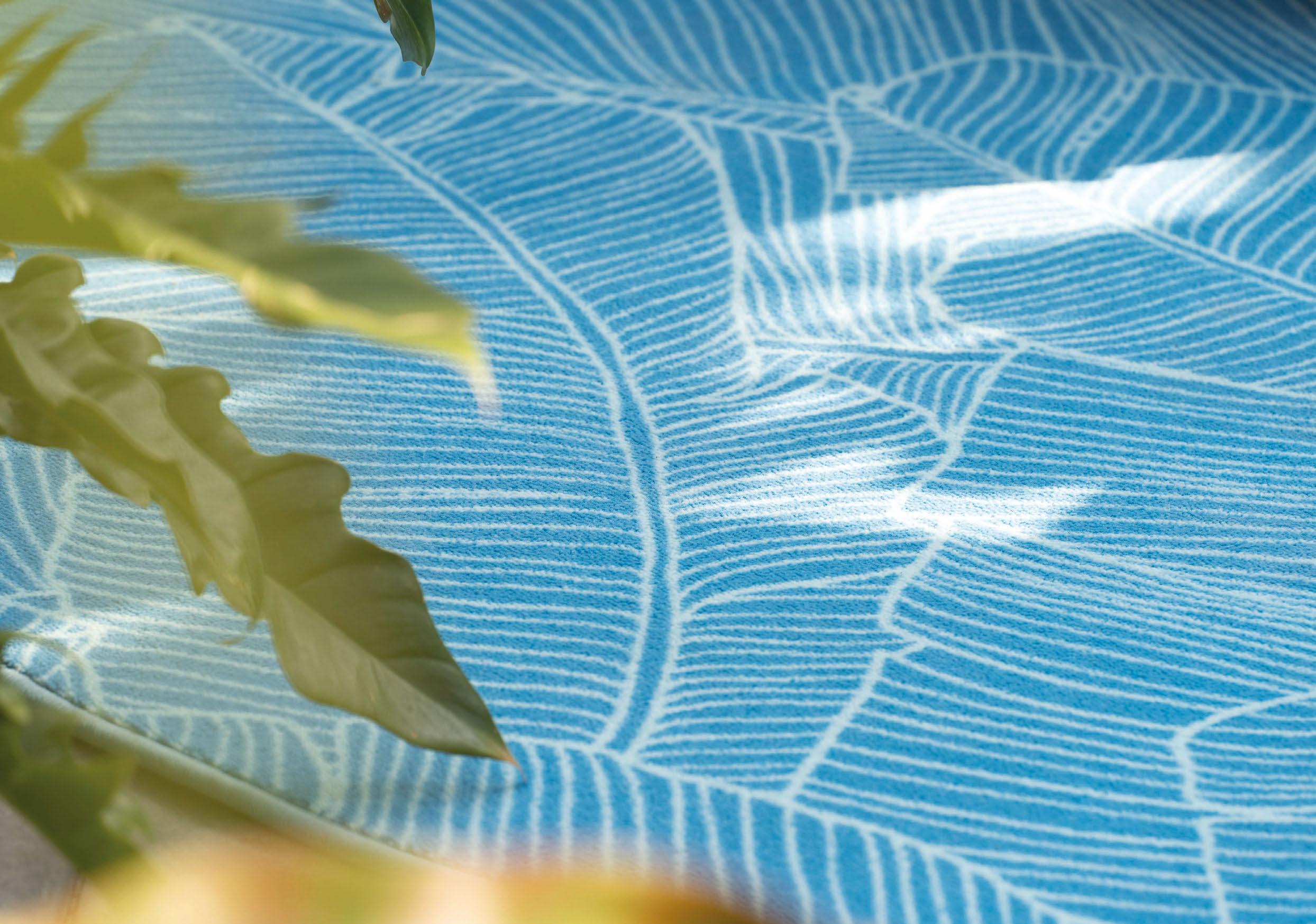
As travellers look to reduce their carbon footprint, increasing numbers are turning to the tracks, hopping from city to city by train as a climatefriendly alternative to short-haul flights.
But with increased popularity comes increased demand, not only for new routes and timetabled services, but for contemporary design, greater comfort and more privacy – something that rail firms ÖBB and Siemens Mobility have set out to achieve with their next-generation sleeping and couchette cars.
Built at the Siemens Mobility plant in Vienna, the Nightjet is made up of seven carriages –two dedicated to seating, two to sleeping, and a further three fitted with four-berth couchettes – resulting in a maximum capacity of 254 passengers. The desire for privacy has been addressed by increasing the number of suites on board – made possible by reducing occupancy –with sleeping cars designed for two passengers only and mini-cabins available for solo travellers. Each compartment is equipped with beds and a seating area for working or dining, as well as storage lockers and coat hooks. They even have their own toilet and shower. Modern technology has also been integrated, with intuitive lighting

control panels, ample charging stations and complimentary high-speed Wi-Fi.

The first Nightjet train is expected to depart next summer for travel between Austria, Germany and Italy, and by the end of 2025, a total of 33 Nightjets will be on the rails, connecting European cities overnight at speeds of up to 230kph. There are also plans to travel to mountainous regions, with an extra storage car for bikes, skis and snowboarding equipment.
“With the new Nightjet, we are making an important contribution to rail travel becoming more appealing and helping to achieve climate targets,” says Albrecht Neumann, CEO of Rolling Stock at Siemens Mobility. “The trains are highly innovative: they stand out for their comfort, sustainability and flexibility, and will be a global benchmark for years to come.”
Andreas Matthä, CEO of ÖBB, concludes: “The night train has become the epitome of sustainable travel, and our Nightjet is a synonym for night trains in Europe. For our guests, comfort, design and privacy are becoming increasingly important, which is why we are investing in a next-generation experience. With this train, we are entering a new age.”
Departing in 2023, a new fleet of Nightjets aim to bring comfort and privacy to overnight rail journeys.
Belmond’s legendary train announces a collection of new suites, each inspired by the European landscapes passed en route.
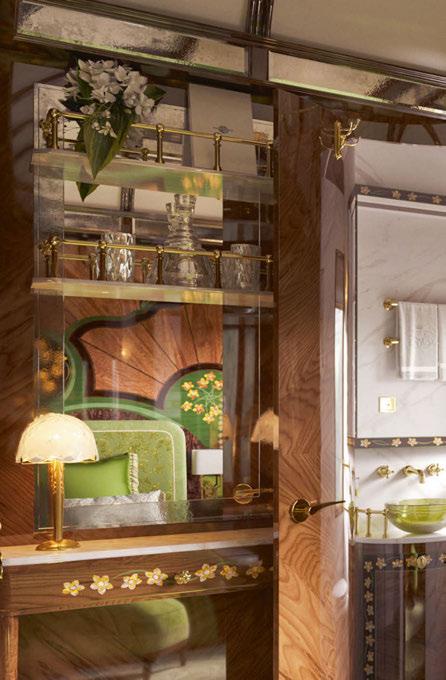
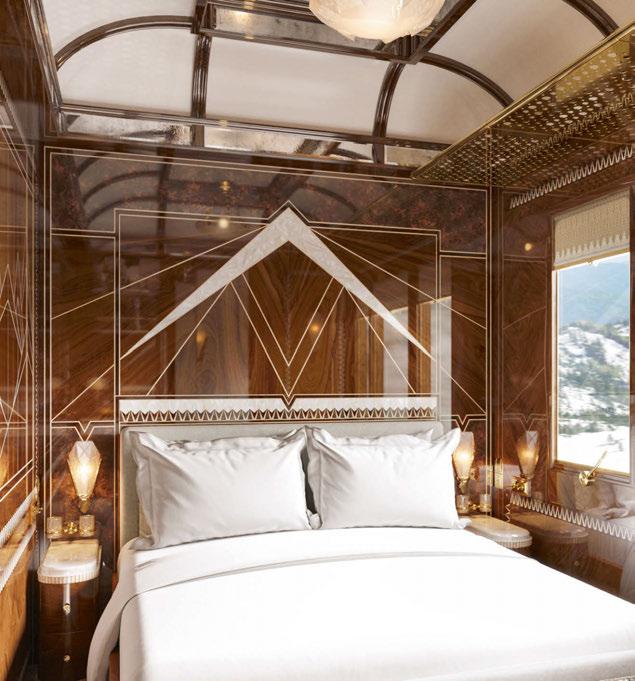
Already considered one of the most luxurious trains in the world, Venice Simplon-OrientExpress will reach new heights come 2023, thanks to the addition of a new cabin category comprising eight stately suites.
Designed by Wimberly Interiors in close collaboration with Belmond, the suites will occupy two original carriages, each steeped in history. Their reinvention will be treated with the utmost respect to retaining the craftsmanship of the 1920s and 30s, with highly-skilled French artisans enlisted to restore the specialist details.
Each suite features a private bathroom and shower as well as a living space that serves as a lounge by day, with seating that converts to a double or twin beds at night. In developing the concept, the design team has taken inspiration from European landscapes to create four different designs: La Campagne (the countryside), Les Montagnes (the mountains), Les Lacs (the lakes), and La Forêt (the forest). La Campagne Suites will be adorned with velvet greens and floral
marquetry in homage to the pastures of Northern Italy and the South of France; Les Montagnes Suites mirror the peaks of Austria’s Arlberg massif, a backdrop on the train’s classic route to Venice; Les Lacs Suites reflect the serene waters of the lakes passed through Switzerland; and La Forêt Suites emulate the dense Black Forest region in southwest Germany – a route taken when travelling from Prague to Paris.
Adding a new expression of opulence to the train by immersing guests in the European scenery through colour, pattern and texture, each suite will feature plush fabrics and furnishings that channel the work of famed Art Deco designers such as Majorelle, Dufrene, Leleu, Rousseau, Prou and Lalique.
The new accommodation offer is expected to enter service next year, joining the existing Historic Cabins and Grand Suites – also designed by Wimberly Interiors and winner of an AHEAD award in 2018 – as well as a refreshed dining experience courtesy of French chef Jean Imbert.
Following its discovery in the depths of Eastern Europe, the legendary Nostalgie-Istanbul Orient-Express will get its fairytale ending, returning to the tracks in spectacular style.
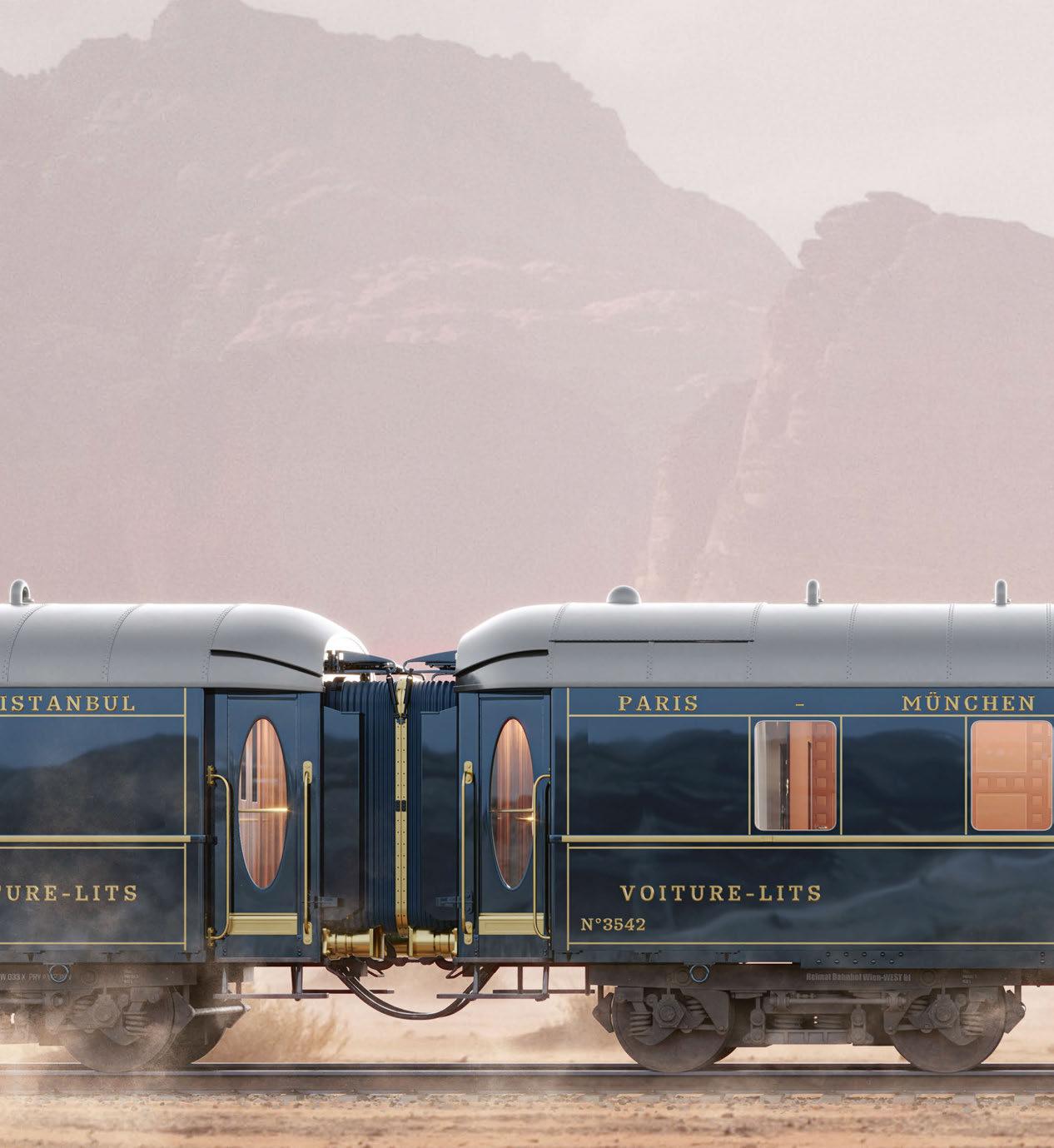
Rail enthusiasts rejoiced in late 2021 when Orient Express announced plans for a modern interpretation of its famous train, so you can imagine their delight at hearing news that lost carriages from the historic Nostalgie-Istanbul OrientExpress had been found and would re-enter service in 2025 for a truly magical ride.
The remarkable discovery came in 2015 when Arthur Mettetal – a researcher specialising in industrial history – happened upon a YouTube video showing the long-forgotten train in motion. The chancesighting led to a months-long search to track it down and, with a little help from Google Maps and Google 3D, the carriages were eventually found on the border between Belarus and Poland, some four hours
from Warsaw. Partly preserved, the interiors revealed Morrison and Nelson marquetry as well as Lalique panels emblematic of the Art Deco style, engraved with signature blackbirds and grapes motifs.
It took two years of negotiations to acquire the train and transport it to a workshop in France, but now, Accor and Orient Express have revealed their vision for its future.
The mammoth task of bringing the carriages back to life fell to architect Maxime d’Angeac, a Parisbased designer with a portfolio spanning private residences to castles. Inspired by the 1920s and a love of travel novels, d’Angeac began the design process by sketching in fine detail and making 3D models, with his concept seeking to combine
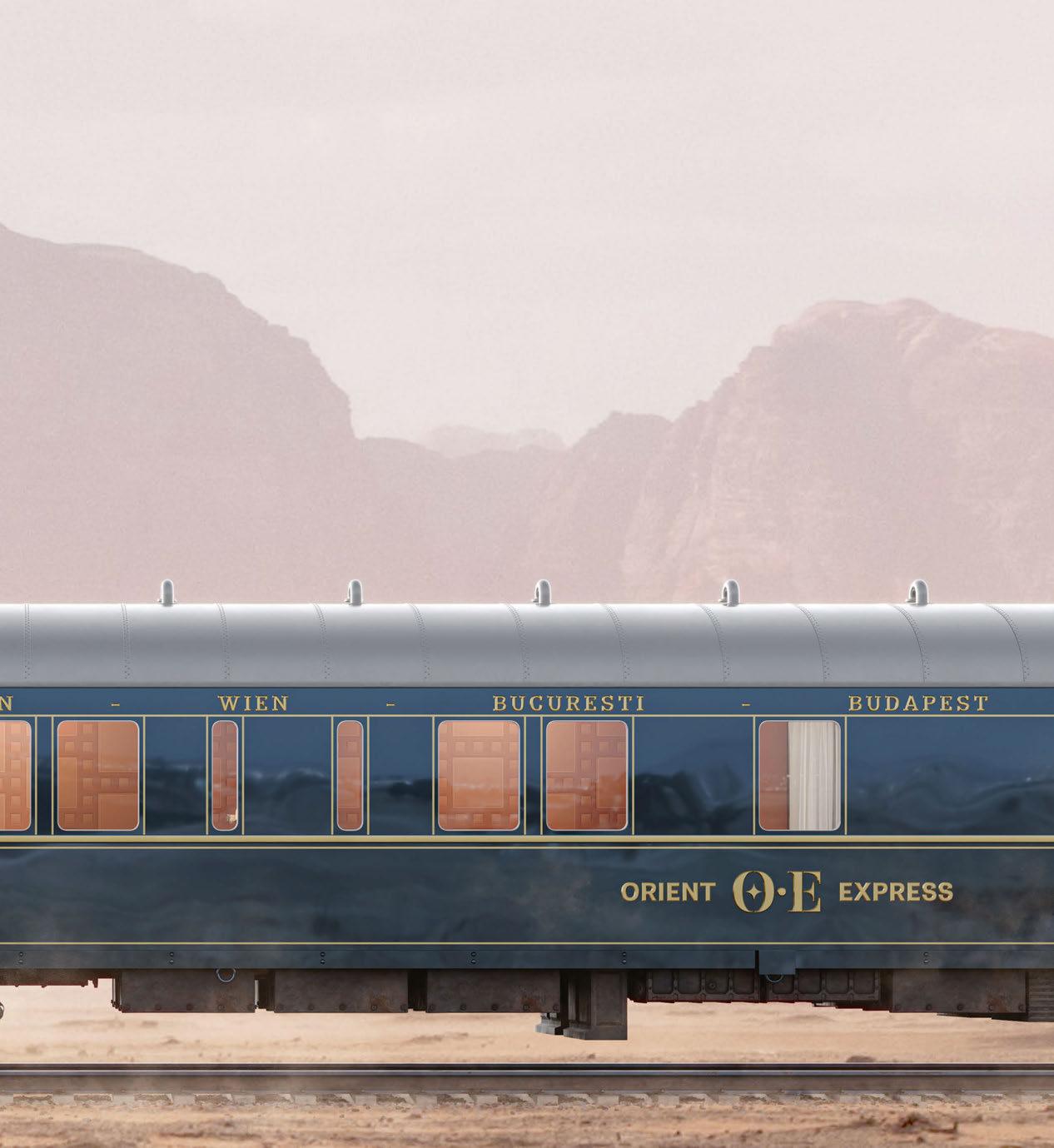
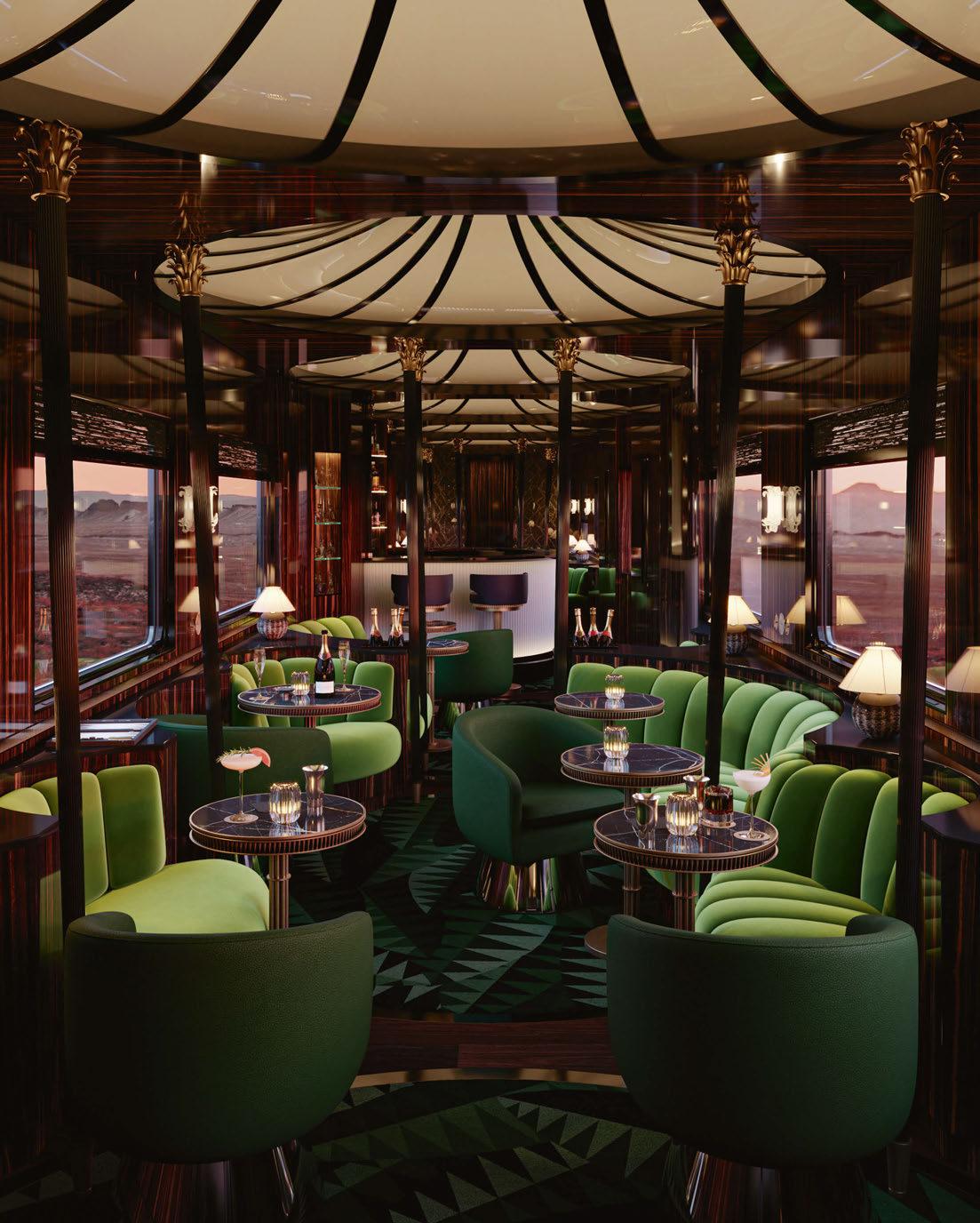
traditional craftsmanship with contemporary luxury. “The work is meticulous, just like it was in the past,” says d’Angeac. “By slipping into the shoes of its creators, from René Prou to Suzanne Lalique, I tried to reinterpret the history of this legendary train, not only with nostalgia, but with a desire to extend its history, to transport us to another place.”
New renderings of the train reveal an aesthetic that evokes the Golden Age of rail travel, with a rich palette of materials together with exquisite detail from the finest French artisans. In the bar, armchairs and banquettes in emerald hues sit beneath Second Empirestyle domes of light, and rosewood, marble and bronze accompany an all-glass bar counter that pays tribute to Lalique. The dining car revives the marquetry of the original train with panels interspersed by a series of archways, while corridors are equally theatrical, featuring vaulted ceilings punctuated by delicate flower lamps and a bold, patterned carpet.

In the suites, d’Angeac introduced circular forms to add softness and counter the horizontal lines of the train; elliptical shelves are dressed with objets d’art and a magic mirror plays with perspective. Materials
here include timber, leather and mother-of-pearl, while nooks are adorned with more of Lalique’s panels recovered from the original carriages.
“Created like a work of art, the future Orient Express train is born from a marvel, the Nostalgie-Istanbul Orient-Express, entirely reinvented and equipped with outstanding facilities,” d’Angeac explains. “The train’s history has been rewritten.”

Expected to take to the tracks in 2025, the new venture will join Orient Express La Dolce Vita, a refurbished fleet that will travel Italy from 2024. Both come courtesy of a strategic partnership between Accor and SNCF, which will also see the launch of Orient Express-branded hotels in Europe and beyond. “We are proud to reveal the first images of the future Orient Express train – a story inspired by a dream, a timeless train, the object of all fantasies and which becomes a reality,” comments Sébastien Bazin, Chairman and CEO of Accor. “Maxime d’Angeac’s design awakens the myth with the revelation of its luxury, modernity and French elegance. Tomorrow, the Orient Express will shine again, proud of its 140 years of history and looking to the future. The legend continues.”
The design scheme reveals a rich palette of materials together with exquisite detail from the finest French artisans
Perhaps the most tedious aspect of travelling a multi-stop itinerary is the unpacking and repacking of luggage at every hotel along the route. But Contesi Design Company may just have come up with a solution, having envisioned a hospitality concept that can be transported from location to location by airship.
A finalist in Radical Innovation – an annual competition that challenges visionaries to pioneer ideas to fuel the future of travel and hospitality – Merani enables guests to explore a region by air, touching down on any surface – on land and on water.

The concept comprises a series of mini hotels, each 39 metres in length and characterised by a sculpted hull that is glazed from the stern to the bow. Inside, the 800m2 living space spans three decks and can accommodate up to 20 guests as well as eight crew. Private suites feature retractable balconies for direct open-air access, while the upper deck is home to a sun terrace, swimming pool, bar and outdoor cinema. There’s also a spacious observation lounge at the bow, where floor-to-ceiling windows offer panoramic views.
Furthermore, Merani considers its environmental impact as it travels, with silent electric propulsion eliminating noise pollution and photovoltaic panels harnessing solar to fulfil energy needs. The zero-emissions vessel also combines state-of-the-art technologies borrowed from automobile, aerospace and naval architecture, ensuring the vessel can occupy unspoiled landscapes without causing ecological damage. Retractable feet stabilise the hotel on uneven terrain, their compact footprint limiting contact with the land, while a liftable sail serves multiple purposes: when elevated horizontally, it provides shade on deck and solar panels can be angled towards the sun to recharge; when vertical, the solar-sail mode takes effect, enabling the vessel to cruise on water.
The mother airship is also eco-friendly, and depending on itinerary, can serve up to six mini hotel units per day, transporting guests to remote locations waiting to be explored. Citing the Nikoloz Baratashvili poem from which the concept takes its name, Contesi Design Company explain: “Merani represents attaining ultimate freedom, with no boundaries of time or space. It thunders across the land, flies amongst the clouds and soars over the ocean, reaching lands that have yet to be discovered.”
Eliminating the stresses of multi-destination travel, Contesi Design Company envision a mini hotel that can be transported by air.

As the priorities of passengers change, airlines reveal their next-generation cabin designs, which value personal space and privacy above all else.
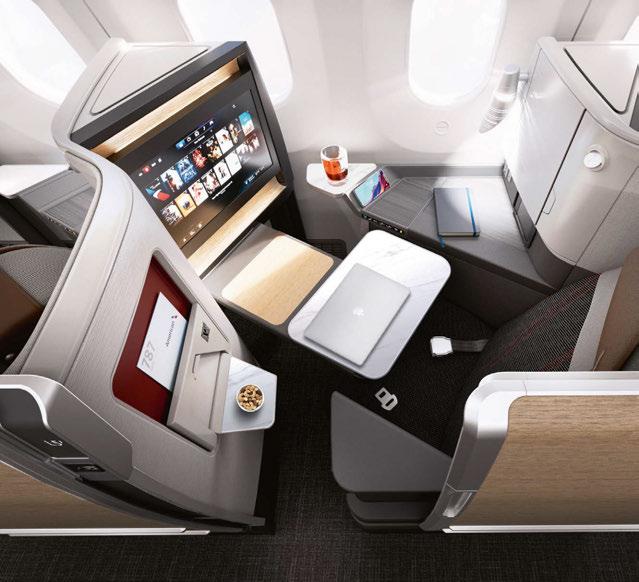
Travel has changed significantly over the past two years, with the global pandemic compelling passengers to consider whether they really want to spend hours in an enclosed cabin in such close proximity to others. With that in mind, airlines have been exploring ways in which to improve the in-flight experience, and it seems that many share a common goal. In addition to the norms of providing a comfortable stay, there’s a drive towards increased personal space, resulting in a host of innovations that put a physical partition between passengers for a heightened sense of privacy.
Responding to “overwhelming customer feedback” on the importance of sleep and the need for more comfort and space, Air New Zealand has revealed it will offer a new Business Premier Luxe option from 2024. Designed with privacy in mind, the suite is conceived as an individual cubicle with a fully-closing door and a seat that reclines to a lie-flat bed. There’s also a spacious tabletop, large enough for two to dine together. The new offer accompanies other cabin-wide enhancements such as larger entertainment screens and the use of lightweight durable fabrics rather than leather, saving around 1kg in weight per seat to reduce overall carbon emissions. The airline’s new Dreamliners will also feature a grab-and-go pantry, the Skycouch, and the much-anticipated Skynest – the world’s first sleep pods for economy travellers. “New Zealand’s location puts us in a unique position to lead on the ultra-long-haul travel experience,” says CEO Greg Foran. “We have zeroed in on sleep, comfort and wellness because we know how important it is for our customers to arrive well-rested.”
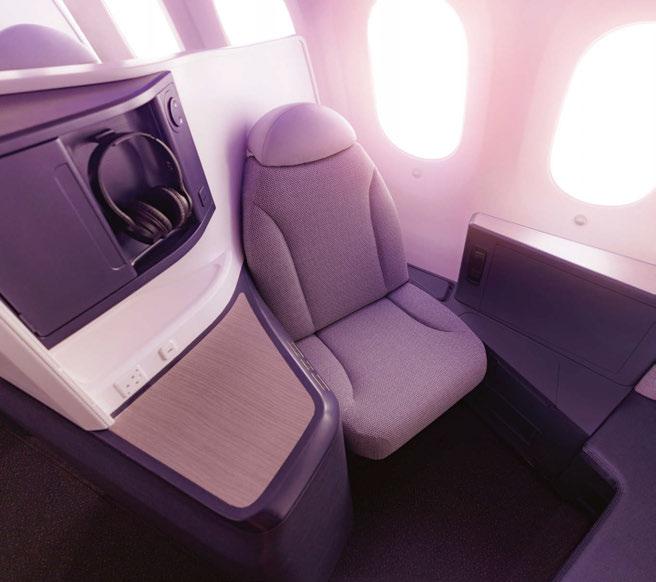

Privacy defines the new premium seating options for American Airlines too, with customers set to experience “tailored luxury in their private retreat in the sky”. Due to be introduced on the Airbus A321XLR and Boeing 787-9 aircraft in 2024, the new Flagship Suite is designed by Teague to elevate the in-flight customer experience on long-haul international routes. It features a privacy door, chaise lounge seating and surfaces for working or dining, as well as expansive storage space. New Premium Economy seats will also offer more seclusion than the industry standard, thanks to the addition of winged headrests providing an element of privacy. Currently on order, the Airbus A321XLR will feature 20 Flagship Suite seats and 12 Premium Economy, while the Boeing 787-9 counts 51 Flagship Suite seats and 32 Premium Economy. Furthermore, the upgrades will be retrofitted to existing aircraft as part of a wider refurbishment programme; in all, Premium seating in AA’s long-haul fleet will grow more than 45% by 2026.
Marking the largest investment in premium products in the company’s history, Lufthansa has announced a new generation of seating options across all cabin classes, developed to make longhaul travel more comfortable. Collectively known as Allegris, the upgrades include Sleeper’s Row 2.0 – an economy-class reclining seat with foldout leg-rest and mattress – and the Business Class Suite featuring extended personal space and ample storage. The most superior is the First Class Suite with nearly-ceiling-high doors that can be closed for privacy. The concept is designed by PriestmanGoode and incorporates a large personal wardrobe as well as a 1m-wide seat that can be converted into a bed. “It’s an incredible product that represents a step-change in terms of privacy, comfort and the choices available to Lufthansa’s first-class passengers,” comments Daniel MacInnes, Director of PriestmanGoode. “The design team has successfully achieved the ambience of the most comfortable luxury space at home, but in the air.” In total, more than 100 Lufthansa aircraft will be kitted out with the new Allegris initiatives.
And finally, proving that privacy and space are indeed the holy grail when it comes to cabin design, Virgin Atlantic has unveiled The Retreat Suite, the airline’s most spacious offer yet. Debuted on the hotly anticipated Airbus A330-900neo, which took to the skies for the first time in October, the concept is based on the idea of socialising in private. Developed by Virgin’s in-house design team in collaboration with Factorydesign, the enclosed suite features an ottoman that doubles as an extra seat, meaning that up to four people can comfortably dine, chat or play games in their own space. It also marks the entry-into-service of Thompson Aero Seating’s new Vantage XL model – a seat that converts to a fully-flat bed measuring a generous 77.9-inches – customised here to Virgin’s style specifications. The Retreat Suite joins other Virgin innovations such as The Loft – a social hub for eight passengers – and the new upper-class suites, which have a fully-closing privacy door and a do-notdisturb feature.
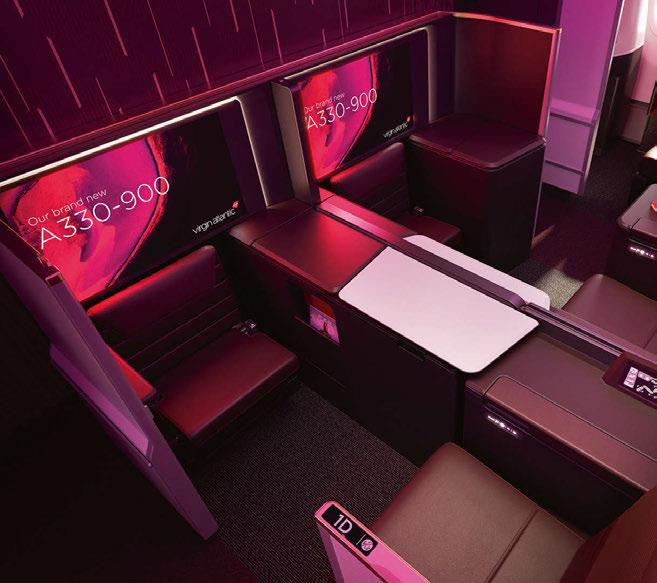
In recent years, the hospitality industry has seen traditional hotel brands expand their portfolios to include various modes of transport, enabling them to offer a door-to-door service for loyal guests. Aman is the latest in a line of operators – as documented in these pages – to do just that; the ultra-luxury Asian hotel group has partnered with Remote Lands to offer carefully curated private jet expeditions, led by the tour operator’s CEO and co-founder Catherine Heald, with multi-night stays in a selection of the brand’s hotels. There’s a range of itineraries to choose from, all taking in the destinations that Aman calls home and travelling between them in the comfort of a private jet. Adventures in the Americas for example, begins with a stay at the recently-opened Aman New York, an urban retreat designed by JeanMichel Gathy. From here, guests will board a spacious Bombardier Global 6000 and jet to the Caribbean then on to the mesas of Utah, spending nights at Amanera and Amangiri along the way.
The Grandest Tour meanwhile is a 21-night expedition travelling from Japan to Greece aboard an Airbus ACJ318, specially outfitted with four lounges, two restrooms and a shower – there’s even a chef on hand to cook up gourmet meals. The trip includes stays at eight Aman properties, from Amankora in Bhutan to Amanzoe in the Peloponnese. And in a change of pace, the Japan Culinary Journey is a nine-night adventure travelling via helicopter and bullet train; it offers special access to markets, vineyards and distilleries, as well as ample opportunities to sample the nation’s culinary delights.
The addition of private jet expeditions to its portfolio is a savvy move for Aman; with a growing collection of hotels, yachts, villas and residences, the group is a step closer to offering its followers complete immersion in the Aman lifestyle.

In-flight entertainment has been a staple of long-haul flights after it was first introduced over a century ago, and since those early days of a black-and-white movie showing on a single screen, the service has evolved to vast libraries of films, sitcoms and podcasts.
With airlines constantly on the lookout for new ways to entertain, VistaJet has come up with a novel way to captivate its passengers. In response to a survey that revealed more than 80% of VistaJet members are passionate about art, the global aviation company has partnered with Frieze Art Fairs to develop the world’s highest ‘viewing room in the sky’. Accessible across VistaJet’s fleet of distinctive silver and red aircraft, the viewing room uses cutting-edge and immersive technology enabling passengers to preview, select and acquire artworks from world’s leading galleries, many of which have been on display at Frieze Art Fairs in London, Los Angeles, New York and Seoul. For the ultimate cabin experience, a Frieze curator will also be on hand to virtually chaperone passengers on their exclusive art journey, pointing out highlights and must-see pieces.

























Priding itself on a passenger promise of ‘Fly Better’, Emirates is enhancing its on-board experience with a new hospitality strategy that spans design to dining. The US$2 billion initiative will include memorable moments such as a cinema in the sky, as well as a comprehensive upgrade to cabin interiors across all classes. A renewed focus on F&B meanwhile will see new menus rolled out on select routes, with an award-winning team of chefs curating dishes such as pan-fried salmon trout with moqueca sauce and creole rice, and roasted duck breast with orange thyme jus. The launch of a vegan menu caters to the growing numbers of customers opting for a plant-based diet, and in a bid to boost its sustainability credentials, the airline will serve fresh greens harvested from Bustanica, the world’s largest vertical farm and newly-opened US$40 million joint venture investment through Emirates Flight Catering. Rounding out the dining offer, the signature champagne and caviar experience for first-class passengers has also been bettered, with unlimited portions of Persian caviar now served on demand alongside Dom Perignon vintage champagne. Such an offering requires an equally elevated service, so the airline has partnered with renowned hospitality school Ecole Hôtelière de Lausanne to train cabin crew in the service pillars of excellence, attentiveness, innovation and passion. Flying better, after all, is an art.
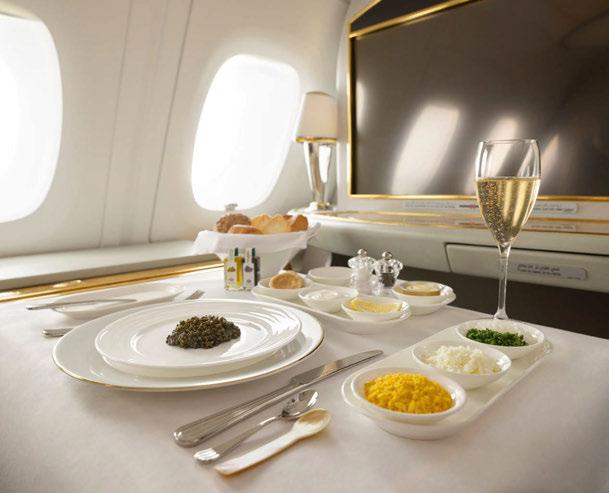
Sustainability and in-flight dining might not be seen as natural bedfellows, but Air France is challenging the perception with a revamped culinary offering that places emphasis on responsibly sourced seasonal produce. This summer, the carrier teamed up with the multi-Michelin-starred French chefs Michel Roth and Anne-Sophie Pic to introduce new menus for passengers travelling on long-haul flights from Paris. Diners in the La Première cabin were treated to Roth’s resolutely gourmet vision, which included a starter of lobster medallion served with raspberry vinaigrette, followed by options such as tender beef dished up with pan-seared foie gras and truffle sauce, or quinoa with candied lemon and summer vegetables. Those seated in business class meanwhile tasted the delights of Anne-Sophie Pic, with a menu comprising eight dishes in her signature culinary style; highlights included roast chicken served with spelt risotto and courgettes, and an artichoke barigoule accompanied by creamy polenta, smoked vanilla burrata and a tangy tomato coulis. Thanks to a new initiative enabling passengers to pre-select their hot meal before departure, the offer was also light on food waste.
If progress seems swift, it’s because Air France is on a deadline: the company has committed to offering 100% French meat and dairy products and sustainably caught fish on all flights from Paris and across all cabins by the end of 2022. It has also pledged that meals will be prepared entirely in France, while dishes for children and infants will be made exclusively from organically-grown produce.
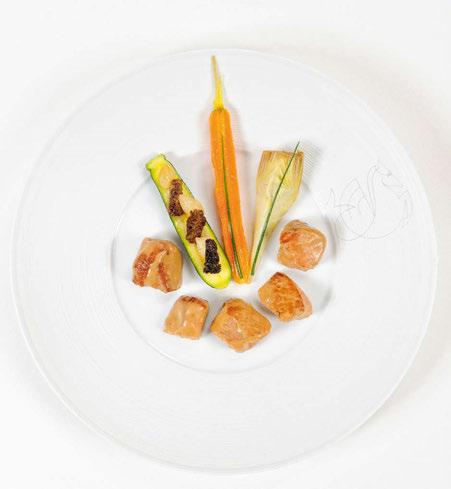
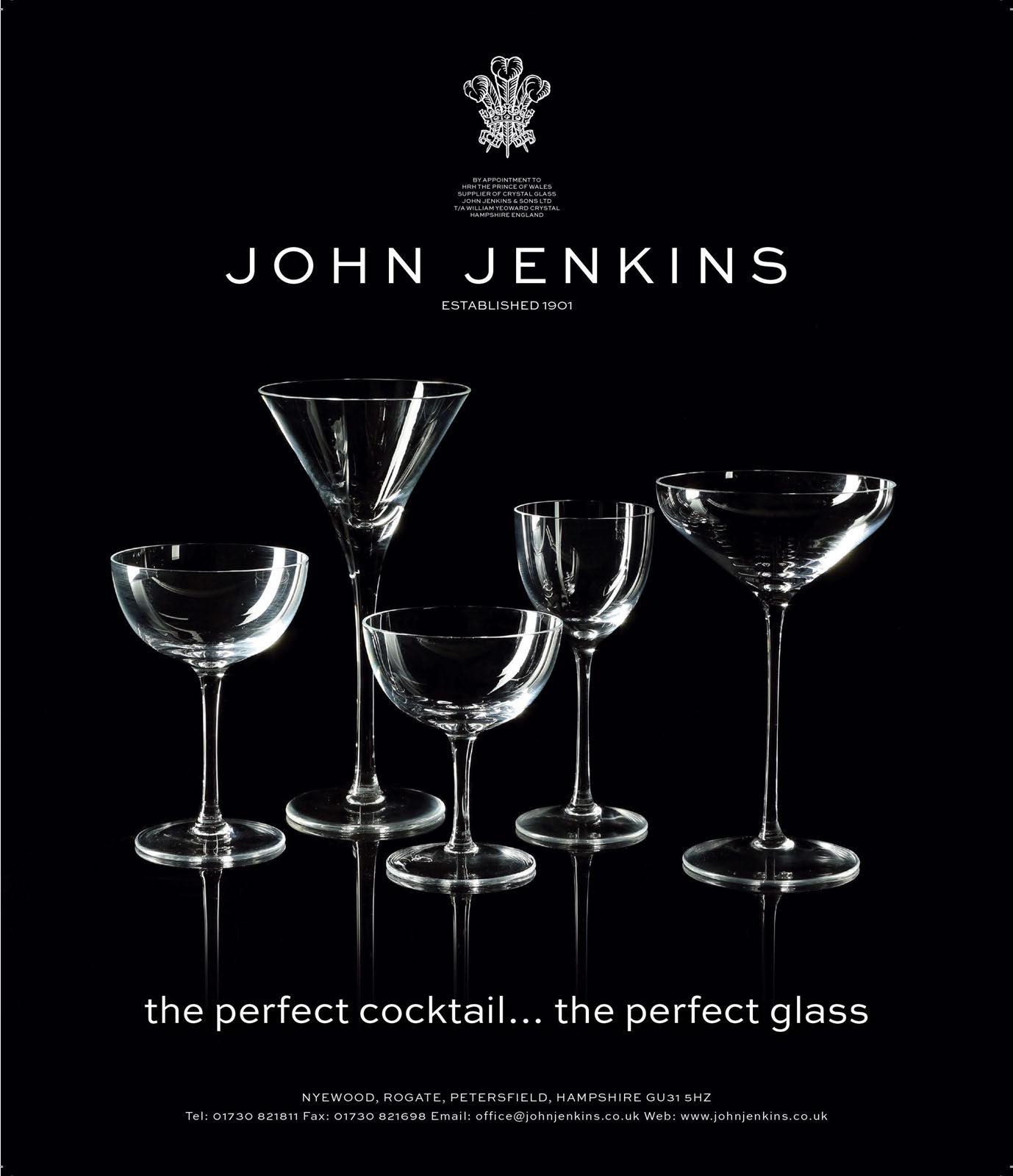
Hilton ventures into a new territory, partnering with Voyager Space to elevate the guest experience aboard Starlab Space Station.
With 7,000 hotels in 122 countries and territories worldwide, Hilton can lay claim to offering travellers a comfortable stay wherever they are… even in outer space.
In a landmark development, the group has been named official hotel partner for Voyager Space and is set to design the crew lodgings and hospitality suites aboard its free-flying commercial space station. Planned to replace the International Space Station, the new spacecraft has the capacity to continuously host up to four astronauts and will also house a state-of-the-art laboratory and the first science park in space.

“Hilton has been innovating to improve the guest experience and pioneering new destinations for travel for more than a century,” comments Chris Nassetta, President and CEO of Hilton Worldwide. “For decades, discoveries in space have been positively impacting life on Earth, and now Hilton will have an opportunity to use this unique environment to improve the guest experience wherever people travel. This
landmark collaboration underscores our deep commitment to spreading the light and warmth of hospitality and providing a friendly, reliable stay – whether on the ground or in outer space.”
Bringing its hospitality expertise to the space station, the group has been tasked with supporting the design and development of the crew areas, helping to reimagine the human experience and making extended stays more comfortable. But this isn’t the first time Hilton has ventured into space. In 2019, it participated in research in which the famous DoubleTree by Hilton chocolate-chip cookie became the first ever food baked in space. And back in 1967, at the height of the space race, Barron Hilton dreamed of building a hotel on the moon, going so far as to develop concept drawings and mock-up reservation cards and room keys.
In this new partnership, Hilton and Voyager will collaborate in the fields of architecture and design, developing communal areas and sleeping suites on board as well as the ground-to-space astronaut experience. Larry Traxler, Senior Vice President of Global Design at Hilton comments: “This is an exciting new chapter for our design team. We truly believe in the power of design to elevate the stay and are thrilled to bring our expertise in creative and efficient design solutions to new heights.”
Longer-term, it is also hoped that the venture will pave the way for other tourism, educational and commercial efforts. “Starlab will be more than just a destination, it will be an experience made infinitely more unique and artful with the Hilton team’s infusion of innovation, expertise and global reach,” concludes Dylan Taylor, Chairman and CEO of Voyager Space. “Voyager and Hilton are acutely focused on creating innovative solutions for the future of humanity and this partnership opens new doors to what is possible for comfort-focused space exploration and habitation.”
Out of this World Orbital Assembly enhances the guest experience with a hybrid gravity approach on board its space hotel.

Aside from the edge-of-the-world views, one of the most-asked questions of any astronaut is ‘how do you pee in space?’ With hoses, funnels and suction hardly conducive to a luxury stay, Orbital Assembly has come up with a hybrid approach for its forthcoming Pioneer-class station, billed as the first free-flying, habitable, privately operated facility in orbit for work, rest and play.
In its ambition to create the ideal conditions for holidaying in space, the group has tapped into research carried out by former space station astronaut Mae Jemison and Associate Professor of Biomedical Engineering at the University of California, Ronke Olabisi. Exploring the effects of variable and partial gravity on human health, the research identified what people like and dislike about gravity. “They like the ability to float around but they dislike how microgravity makes their body feel,” explains Tim Alatorre, Vice President of Habitation and Chief Operating Officer of Orbital Assembly, pointing out that daily tasks such as eating, drinking, sleeping and
using the bathroom are far more challenging in space. “With our hybrid gravity approach visitors will live in an artificial gravity environment but visit a different area of the station for all types of microgravity activities. We are working to make our stations accessible and safe for people who will be living for long periods of time in orbit.”
The approach will be implemented on the Pioneer-class station from its debut in 2025, made possible thanks to a structure of customisable modules built around a rotating gravity ring. In a bid to offer all the amenities of a luxury hotel in space, OA has partnered with lifestyle brand Dream Big World to develop the first retail experience in space, which can be previewed at stores in Dubai and Cancun via VR and immersive 3D simulation. And a hotel experience wouldn’t be complete without an F&B offering, so the group is also collaborating with alternative protein producer Micro Meat to develop cultivated meat production systems on board the station, further facilitating long-term space habitation in the process.
Replicating the same standard of dining and imbibing experiences in space as travellers have come to expect on land, is one of the great challenges of suborbital hospitality. Gravity, atmospheric conditions and alterations to a person’s sense of smell are amongst the limiting factors, but a growing number of ventures seek to make freeze-dried food and powdered beverages a thing of the past.
With that in mind, Maison Mumm has revealed the first champagne bottle and tasting experience designed for human spaceflight. Developed in collaboration with Axiom Space, Mumm Cordon Rouge Stellar is faithful to the production techniques that the French champagne house has perfected over generations, and has now achieved full compliance with cargo specifications, meaning it can fly on future space missions.
To create the special blend, Cellar Master Laurent Fresnet participated in a parabolic flight in order to understand the impact of zero-gravity conditions. He found that the conditions of tasting champagne in space differ on a physiological level, and that the behaviour of the champagne itself is affected too, with bubbles no longer rising to the surface to release their aromas. Taking this into account, Fresnet
selected a blend of grapes from the 2016 harvest – a majority of Pinot Noir, the house’s signature variety – and extended the ageing process to five years to develop notes of vine peach, hazelnut and praline. The end result reinforces the Mumm characteristics of freshness, intensity and complexity – ideal for tasting conditions where the senses are altered.
The packaging for Mumm Cordon Rouge Stellar has also been carefully considered: the wine is contained in a half glass bottle with a stainlesssteel opening-closing device – two materials that ensure its preservation and meet the champagne classification. To respond to the constraints dictated by space, the glass is protected within an aeronautical-grade aluminium shell, topped with an orbiting ring that contains the cork.
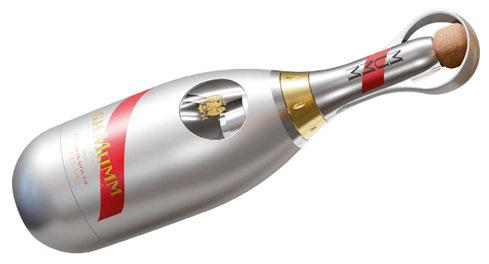
“The Mumm Cordon Rouge Stellar recognises that, to bring humanity to space we can’t just bring humans, we need to bring human traditions,” explains Michael Suffredini, Axiom Space’s President and CEO. “This philosophy of celebrating humankind empowers our goal for Axiom Station, a next generation destination that will serve as a thriving home in space to enable a diverse space economy, further exploration and enable more of humanity to access space.”

Maison Mumm partners with Axiom Space to develop a new champagne for celebrations amongst the stars.





As private jet usage takes off, Flexjet bolsters its fleet with a new addition designed in collaboration with Bentley.
Words: Lauren Ho • Photography: Courtesy of FlexjetIt’s no secret that private jet travel is big business. For some, it’s the perfect way to avoid such nuisances as airport security, other travellers and scheduled flight times. And while commercial airlines grounded services during the height of the pandemic, an exclusive few were still able to travel, resulting in a surge in private plane usage. In fact, according to aviation research firm Wingx, business jets flew 3.3 million flights worldwide in 2021 – the most on record for a single year - with the US and Europe leading the growth. It is for this reason that Flexjet, one of the largest and most innovative fractional jet providers, has announced it will almost double its European fleet, thanks to a 180% increase in bookings in the first four months of 2022. “This huge uplift in demand is extremely encouraging and shows the continuing and growing appeal of private jet travel,” notes Marine Eugène, European Managing Director for Flexjet.
The most noteworthy addition to the fleet is the arrival of the Gulfstream G650. Following its success in the US, the European edition takes things to the next level in a collaboration - a first for the brand - with Bentley. Inspired by the Bentley Mulliner Bacalar, a rare two-door open-air sportscar of which only 12 in the world have been manufactured to the specifications of each of the buyers, the design is an experience that starts with the Flexjet signature chameleon stripe on the body of the aircraft. Here,
the one-time colour change transforms the stripe from gold to Julep green - depending on the angle and the lightwhich is the colour of one of the Bacalars. Inside, the plush interiors include details such as buttery-white leather seats embellished with the distinctive Bentley double-stitched basketweave pattern.
The Gulfstream G650 itself is a beauty, its characteristic 16 large oval-shaped windows flooding the spacious cabin with light and frame bird’s-eye views throughout the journey. A long-range jet, it can fly high and fast, reaching a maximum range of nearly 11,500km and a top cruise speed of Mach 0.925. The result - thanks also to an impressive 99ft wingspan - is swift, smooth and pleasantly quiet, making transatlantic journeys a breeze. “Our ultra-long-range programme is well-established in the US and we are delighted to welcome our first Gulfstream G650 into our European fleet,” says Eugène. “This is a significant investment that is a key milestone in our ambitious expansion plans.”
And if that wasn’t enough, the brand has also launched its European point-to-point helicopter service. And in pairing with the new Bentley Bacalar-dressed Gulfstream G650, the Sikorsky S-76 - also known for its smooth, calm and quiet ride - seamlessly provides last-mile transport from the airport to the final destination amid the same luxury Bentley Bacalar-styled interiors.
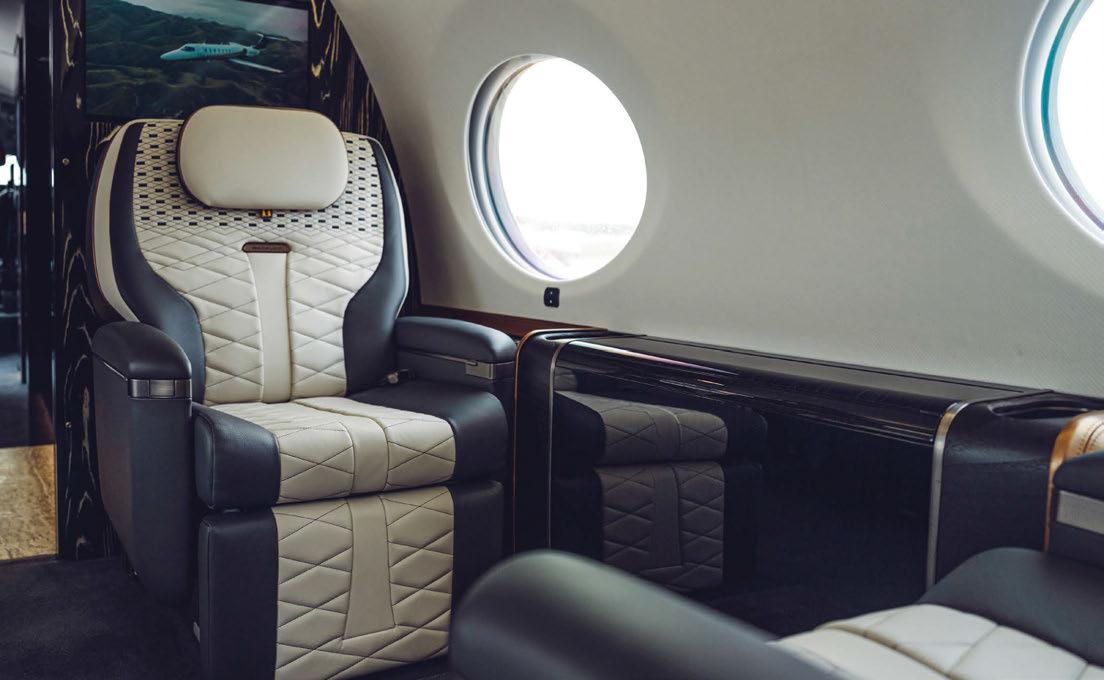

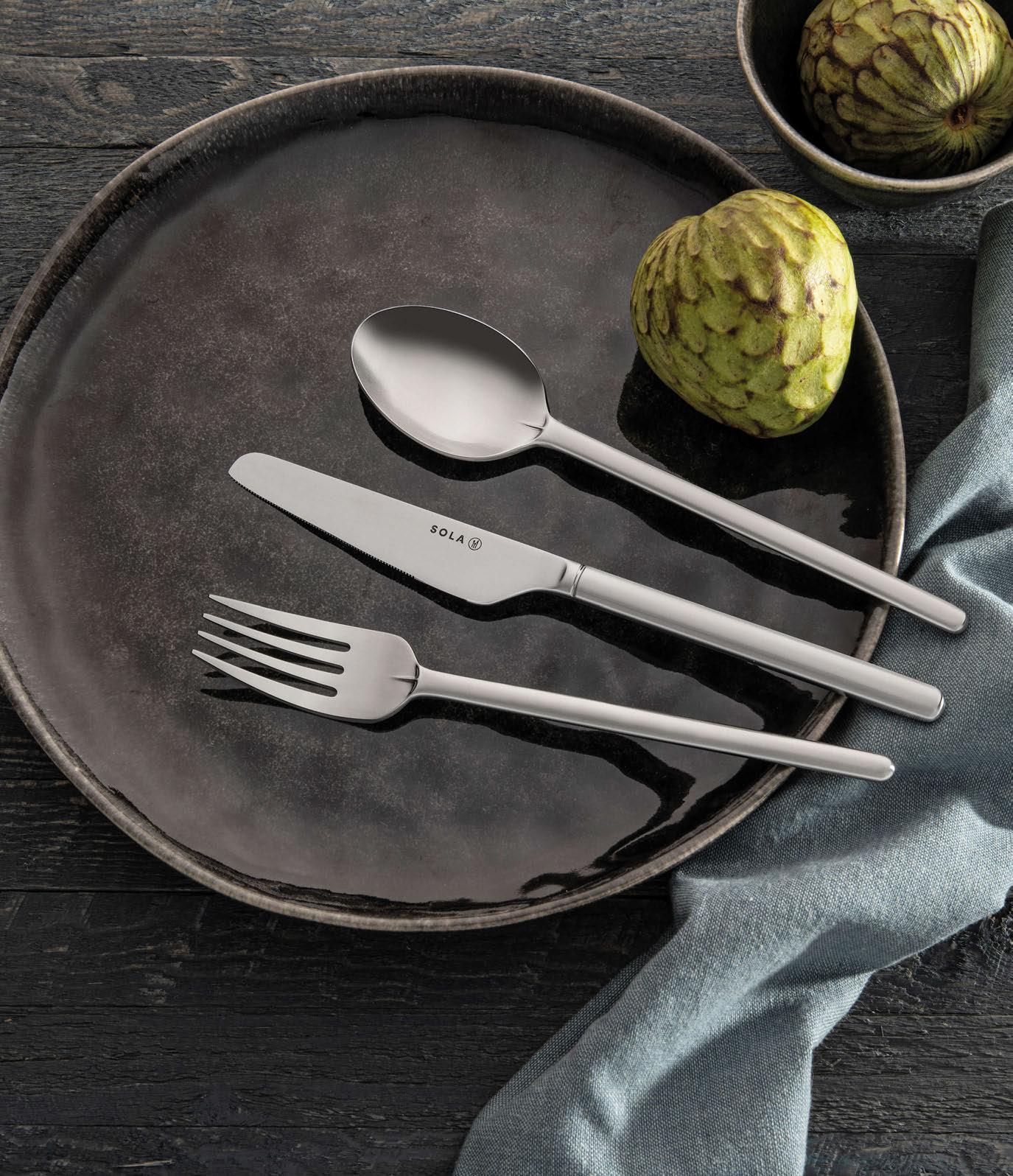

Kuulto brings a new character to the world of ceiling fixtures, where wood is not a commonly used material. Designed as both a standalone piece or as part of a modular group, the light can be used on the ceiling or to enliven walls. It is not only a source of light but an architectonic solution that creates an interesting interplay of surfaces. Kuulto comes in two sizes and four finishes, and also has a dimming function. www.sectodesign.fi
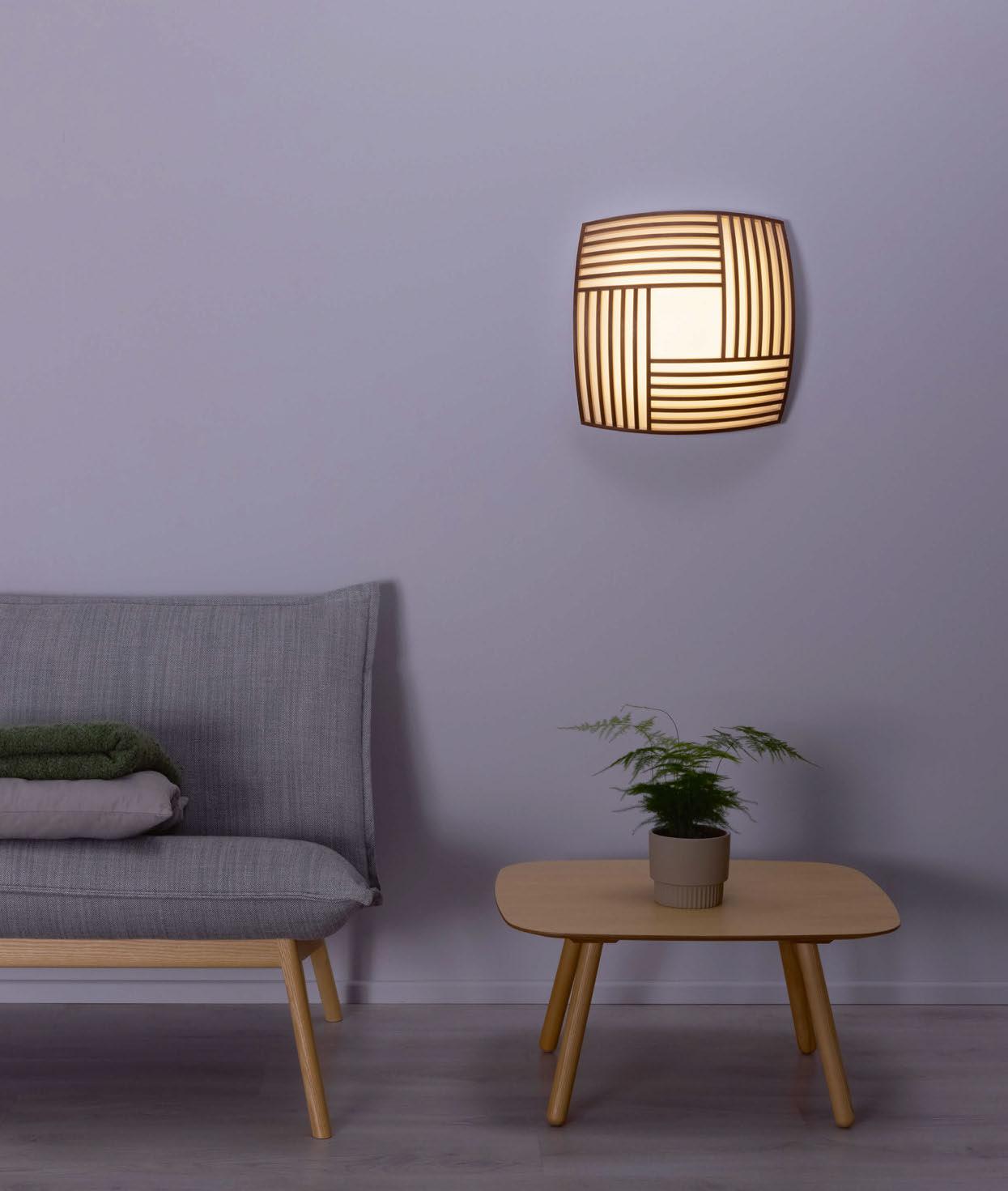
Italian wellness equipment manufacturer Lemi Group has developed Amalfi, a multi-functional spa bed catering for all treatments, from face and body massage to manicures and pedicures. Designed with versatility in mind, the piece consists of a traditional massage bed equipped with a built-in pedicure station, while the mattress features a removable section for quick and practical access to a pedicure tub with a pipeless hydromassage system. Ideal for small spas thanks to its compact, flexible nature, the bed comprises a bi-material base with both a central wooden finish – which can be customised in a variety of colours – as well as an outer metal base that can finished in gold or rose gold. www.lemispa.com
Poltrona Frau La Selle
Poltrona Frau has collaborated with Winch Design on the La Selle Collection, launching a lounge chair and dining chair as the first in the series. Realised in saddle hide leather on a slatted walnut frame with cushions in upholstery leather, the pieces can be customised in different colours and woods for a bespoke look. The integrated seat pad takes reference from a saddle construction, whilst the strap detailing, contrast stitching, stud details and saddle bag pocket further enhance the equestrian aesthetic. Attention has been paid to every element of the design and construction, down to the dowels on the frame, which are reminiscent of those found on stable doors. www.poltronafrau.com


Designed as a multipurpose upholstered seating option, the Geneva Armchair is a Mid-Century Modern armchair finished with an elegant sloped arm seat design, a sleek bentwood frame and tapered wooden legs. The seat can be customised with upholstery from any of the company’s standard range, whilst the frame can be finished in a range of stains. The contemporary piece has been designed to add a classy touch to the interiors of hotels and restaurants, and will complement a variety of different design schemes. Every Table Place Chairs item is contract-tested for commercial use in high-traffic areas, making them ideal furniture solutions for cruise ships. www.tableplacechairs.com
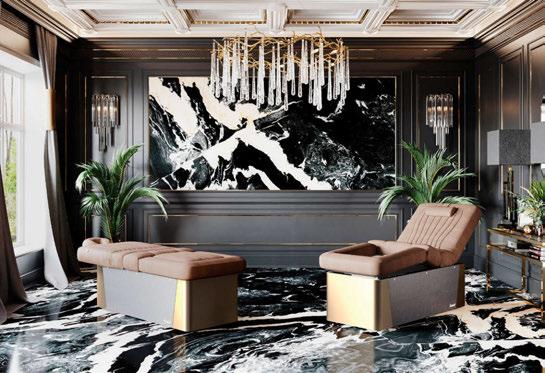
Roman has added two new colours – brushed brass and brushed nickel – to its Select Wetroom panel collection. The shades are an addition to the existing chrome and matte black finishes, all priced identically, and feature in the new Roman Showroom Guide brochure. The Select range includes Roman’s Wetroom Panel options, which can be fitted to its lowlevel shower trays or straight-to-floor to create a true wetroom space. The company also presents a number of panel sizes and configurations to help create bathroom sanctuaries, with all wetroom panel size options available in 8mm and 10mm glass thickness. The deflector panels are offered in three sizes, while there is also one fixed version within the collection. All Roman products are manufactured in Britain and come with a lifetime guarantee. www.roman-shower.com

The Skopos Essential Voiles collection pulls together easy-to-use, wide-width plain white and cream options from the Zephyr and Astraeus ranges, and includes three new designs in both white and cream: Muslin, a fine weave with an irregular crinkle slub; County, an open weave with a linen cross-hatch effect; and Tranquility Eco, comprising 50% recycled polyester (post-consumer) to help marine designers achieve a more sustainable interior. The Essential Voiles all meet IMO standards, are flame-retardant (achieving BS5867) and washable, meeting the demands of marine interiors. Skopos also offer bespoke options for voiles and other soft furnishings, creating statement finishing touches that can champion a brand or define a key look for cruise vessels.
www.skoposfabrics.com
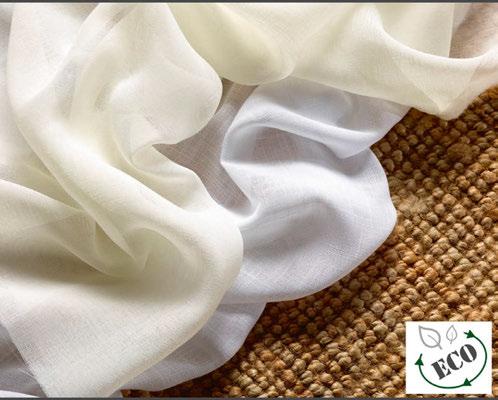
In addition to a standard thermoelectric refrigeration offering, cooling and refrigeration system supplier Indel B can also customise products and provide the same refined design solutions found in luxury hotel suites. Silent and smart, the KD50 Ocean is fitted with a drawer system for easier access to products and their organisation. With a 50-litre capacity, an innovative design and customisable door panel, the minibar can be used to create a wide choice of aesthetic solutions that adapt to all project design requirements. It is also equipped with the Smart system that regulates the compressor, switching on or off based on the presence or absence of the guest in the cabin.
www.indelb.com

Ethimo and Christophe Pillet have collaborated on a new line of outdoor furniture for living on the sea. The yacht collection is an exercise in tailoring that harmoniously combines aesthetics and function: fabrics, generous proportions and high-quality technical materials come together in comfortable shapes. Costiera and Baia, whose names evoke seascapes and describe the world of sailing in an ideal union of contemporary design and performance, come in two seating versions. The former features voluminous cushions and seats constructed with technical padding that defines the structure. Baia meanwhile boasts soft cushions resting on a base bordered by a system of fabricupholstered panels. The leitmotiv for the entire collection is a single mood enhanced by the selection of materials and finishes from the world of yachting, as well as a range of fabrics that hark back to the true heritage of all things nautical, reworked in a contemporary key. The modularity of the lounge and sundeck elements also enables the creation
of customised settings. Together, Costiera and Baia comprise more than 20 pieces that, when mixed-and-matched, can be used to furnish spaces of different types, sizes and shapes. All the upholstery has properties and characteristics that ensure their performance in any outdoor context over time. The padding for example is water-repellent and sealed with a special technique, which means water runs off and is prevented from penetrating them, while the cushions and armrests have easy-to-remove loose covers and the leather is eco-friendly and specific for outdoor use. The base and structure for the Costiera and Baia seats and coffee tables come in shades of silver or carbon powder-coated aluminium, which can be paired with both accoya or natural teak, thus creating four different combinations. For a minimal look, the structure can be produced entirely in silver or carbon aluminium. www.ethimo.com


WallPepper Group produces custom-made wallpapers from ecosustainable and certified materials, and has both IMO and MED certification necessary for use on cruise ships and yachts. The Milan-based firm’s IMO/MED certified materials for naval application include WallPepper/Smooth, a naturally ecological TNT, composed only of cellulose and Agave textile fibres meaning it is completely free from PVC and harmful substances. The non-woven fabric is washable, breathable, textured and easy to lay with invisible joints for an engaging result. Meanwhile, WallPepper/Suede is an innovative and sustainable alternative to PVC that is suitable for all spaces with high foot-traffic. Composed of PET with over 30% recycled bottles, Suede is endowed with mechanical resistance and a naturally stain-resistant surface without the need for a final protective product.
www.wallpeppergroup.com
Global lighting manufacturer Preciosa has launched a maritime version of its signature design, Inspiral. Conceived specially for yachts, Inspiral features crystal-cut prisms that capture light and reflect it in the colours of the rainbow. To make a maritime version that meets all safety requirements, Preciosa designers adapted the design by using metal tubes for stability. The statement piece will bring light to any yacht space, be it the main cabin, dining area, entryway or stairway. “Handcrafted, bespoke crystal lighting shouldn’t be restricted to land,” says Michael Vasku, Creative Director at Preciosa. “Design-forward, statement lighting for yachts is totally achievable, and that’s what we’re hoping to show with Inspiral. The flexibility from this design is broad; go bold or choose a more minimalistic design. We’re here to support, advise and bring your custom maritime lighting to life.”
www.preciosalighting.com/maritime
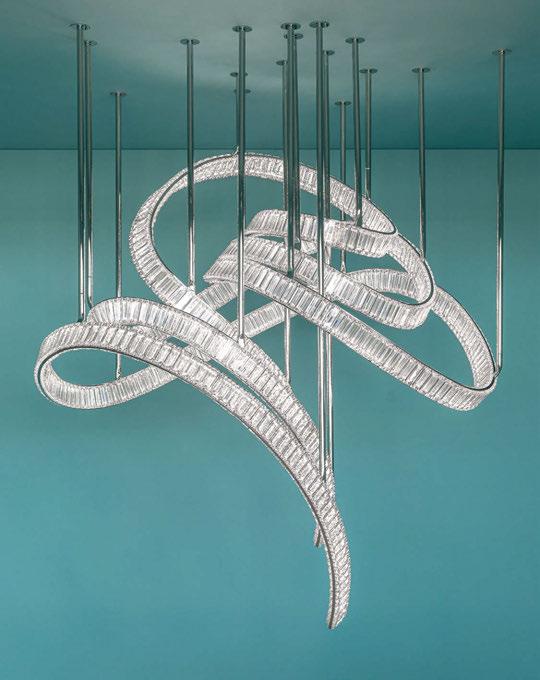
When Winch Design was tasked with creating bespoke interiors for the first hull of the new Amels 60 range named Come Together, the design studio enlisted lighting manufacturer Dernier & Hamlyn to create artisan-crafted bespoke lighting for the interiors that would complement the exterior spaces with geometric references.

Winch’s team brought these angles inside and softened the shapes by combining them with organically inspired forms, resulting in an interior that feels beachy and relaxed with a warm colour palette and subtle masculine edge.
Dernier & Hamlyn interpreted this theme in different ways across the various interior spaces, harmonising with the unique details that run through Winch’s work. The dining room for instance features lighting with incorporated controls to create the perfect ambience for any occasion. The four fittings in various sizes –from 1000mm to 500mm across – are softened pentagons and hexagons. Produced in Dernier & Hamlyn’s factory to Winch’s exacting specification, the frames were made using
laser-cut brass with wooden structures crafted from marine plywood, steamed to shape and stained to a custom shade created by Winch. They were then fitted by hand with stretched goat skin vellum dyed to another of Winch’s custom colours.
In the saloon meanwhile, four circular silk shades inspired by anemone shells are fitted with bronze trims and fixed to frames handmade by Dernier & Hamlyn. And in the master suite, the wall lights have been crafted from solid brass fitted with handmade silk shades.
“Having worked with Dernier & Hamlyn previously, we knew we could call on them to design and manufacture bespoke lighting that would play a positive role in creating the interiors our client wanted,” says Jim Dixon, Winch Design’s Managing Partner and Creative Director for Yachts & Aviation. “In common with all aspects of the interiors, the lighting has, for the most part, been crafted from pure and natural materials to emphasise a relaxed ‘home at the beach’ spirit.”
www.dernier-hamlyn.com
Glow by Zieher is a flexible system that creates unmatched buffet arrangements. The filigree construction not only allows food and beverages to be presented on the displays, but the inner side also creates enough space to effectively present food in the right light. Zieher buffet systems has been experimenting with innovative lighting concepts for several years, and in Glow, the approach is firmly integrated for the first time. All elements can be used lying horizontally or upright, and can be flexibly combined with two connecting boards made from bent sheet metal. The brand prioritises innovative deisgn on the tabletop and the buffet. www.zieher.com
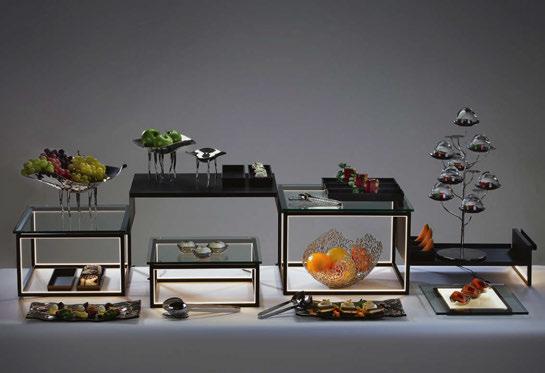

Building a Martian House is a public art project led by by Ella Good and Nicki Kent in collaboration with Hugh Broughton Architects and Pearce+, which aims to create a genuine prototype of a Martian house. Having already developed a toilet that functions on the moon – which won an award from NASA – Duravit’s Head of Research & Development, Franziska Wülker, was tasked with tackling a Martian toilet. A symbiosis of toilet and bidet, Duravit’s SensoWash model offered the ideal solution, reducing the consumption of toilet paper by using pure water for cleaning. Significantly gentler and more sustainable than toilet paper, water removes bacteria, boosts circulation and is softer on the skin. www.duravit.com
Evohide
Evohide Mistral FRee is the latest addition to Morbern’s MorGreen collection of eco-friendly coated fabrics, which are produced without any chemical FR additives yet still achieve the European fire norm EN1021 (Part 1&2). As well as being 100% vegan, phthalate-free and REACH-compliant, Evohide is formulated with bio-attributed PVC resins and bio-based plasticisers derived from non-feedstock bio-waste such as vegetable oil. The 100% recycled polyester backing fabric is also made from used plastic water bottles. The appearance and properties of Evohide can be tailored to meet designers’ expectations, from plain leather-look surfaces to textile-inspired grains, always achieving superior haptic levels as well as IMO MED certification. EvoHide Mistral FRee is expected to achieve OekoTex Standard 100 certification in early 2023. www.morberneurope.com


Dutch shipyard Heesen builds refined and luxurious superyachts known for their exceptional performance, cutting-edge technology and timeless design. The company recently decided that a corporate scent was the best sensorial means to communicate its sporty yet glamourous, highly innovative brand personality. Zephyr, the signature Heesen fragrance, has been designed by Italian brand Integra Fragrances to reflect the firm’s identity. As well as helping Heseen to create memorable experiences in its showrooms, offices and exhibition areas, Zephyr has become a fragrance to gift to the brand’s VIP clients and was transformed into scented cards to be distributed at fairs and major yachting events. Bold and unexpected, the scent features salty notes combined with a delicate floral heart. While the woody base is reminiscent of Heesen’s elegant yacht interiors, the top is like a gentle breeze that evokes time spent on the water under the gaze of the sun. www.integra-fragrances.com
Corby Hall, a family-owned business based in New Jersey, USA, has supplied the international hospitality industry with highquality flatware, holloware and bright white porcelain dinnerware for the past 40 years. With designs ranging from traditional to contemporary at extremely compteitive price points, Corby Hall has the ability to supply all F&B outlets associated with a fullservice foodservice operation. The company’s Bolero collection includes 13 pieces revolving around knives, steak knives, forks and spoons, each crafted from 18/10 forged premium stainless steel. The elegant series comes with either a mirror finish or a silver plate finish for added design flexibility. www.corbyhall.com

Travellers put smart technology to good use in their homes and expect the same automation and enjoyment while staying on a cruise ship. Forest Group, manufacturer of worldwide distributed drapery hardware systems, offers various solutions for the easy integration of their motorised window coverings, like roman blinds (BCS), roller blinds (Atlantis) and curtain motors (Shuttle) on cruise vessels. Using Forest Group’s products, operators can design smarter staterooms without having to connect data cables, making them an ideal solution for dry dock renovation and newbuild ships. The company’s solutions allow for the easy integration of intelligent windowcoverings systems with smart devices or most common building management systems; passengers can therefore control them with their mobile device, tablet or even by voice command. www.forestgroup.com

Continental presented sustainable and functional surface solutions for the diverse requirements in the driver’s cab at the IAA Transportation trade fair in Hannover earlier this year. Acella synthetic leather is a durable product with recycled materials and bio-based raw materials combined with a rPET textile. The yarns to produce the textile for the rear coverings are made from recycled plastic bottles. As a robust and easy-to-clean product with a range of highly variable designs, Acella meets the customer’s interest in sustainable products and does not compromise on product properties. “We can already offer our customers premium surface solutions that are 100% carbon-neutral,” emphasises Dr Gabriele Wittmann, Head of Global Surface Research at Continental. The key is substituting classic petroleum-based raw materials with biobased, CO2-based or recycled raw materials. www.continental.com
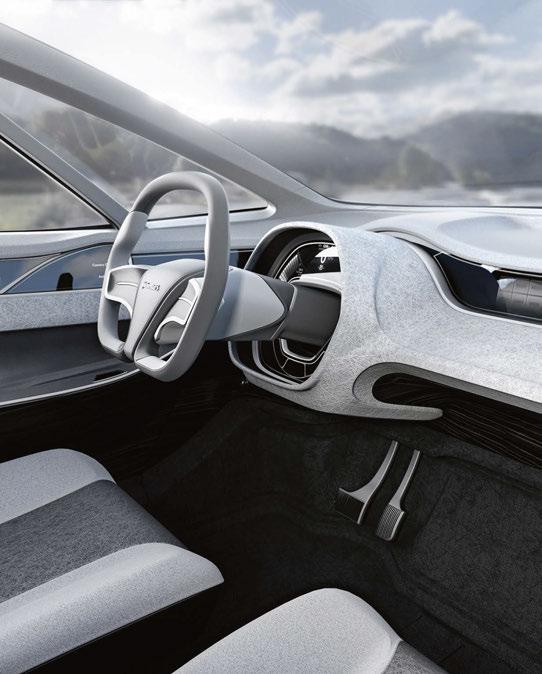
MSC Cruises takes thrillseeking guests to new heights with an adrenalineinducing amusement ride aboard its upcoming ship.

This page of Starboard is often reserved for the zaniest entertainment facilities on board a cruise ship, with past projects including the first-ever at racetrack sea, a futuristic space-themed bar fronted by a humanoid bartender, and an allelectric rollercoaster that whizzes around the top deck at speeds of up to 40mph. Now, MSC Cruises has thrown its hat in the ring with Robotron, an adrenaline-inducing amusement ride that will take pride of place on the top deck of its upcoming vessel MSC Seascape, due to set sail from Miami this December. Designed for thrillseeking passengers of all ages – with multiple levels of intensity according to how daring they are – the attraction features a state-of-the-art robotic arm with an attached gondola that seats three riders. Once in motion, Robotron will twist and turn in different directions, flipping the
rider upside down and leaving them suspended over the edge of the ship some 53 metres above the sea. And to make the experience even more memorable, passengers are also invited to curate their own personal DJ playlist, with the rhythm and bass of their selections visualised as colourful patterns and pulses of light on an enormous video screen opposite – all while the robotic arm is bouncing and twisting to the beat. If that isn’t enough to whet the appetite of passengers, then two brand-new exhilarating entertainment experiences will certainly satisfy a need for speed, whether that be taking command of the cockpit in a flight simulator or hitting the open road on a virtual reality motorbike. As the cruise sector continues on its path of innovation, it’s clear that with every new vessel, guests will be taken to new heights.

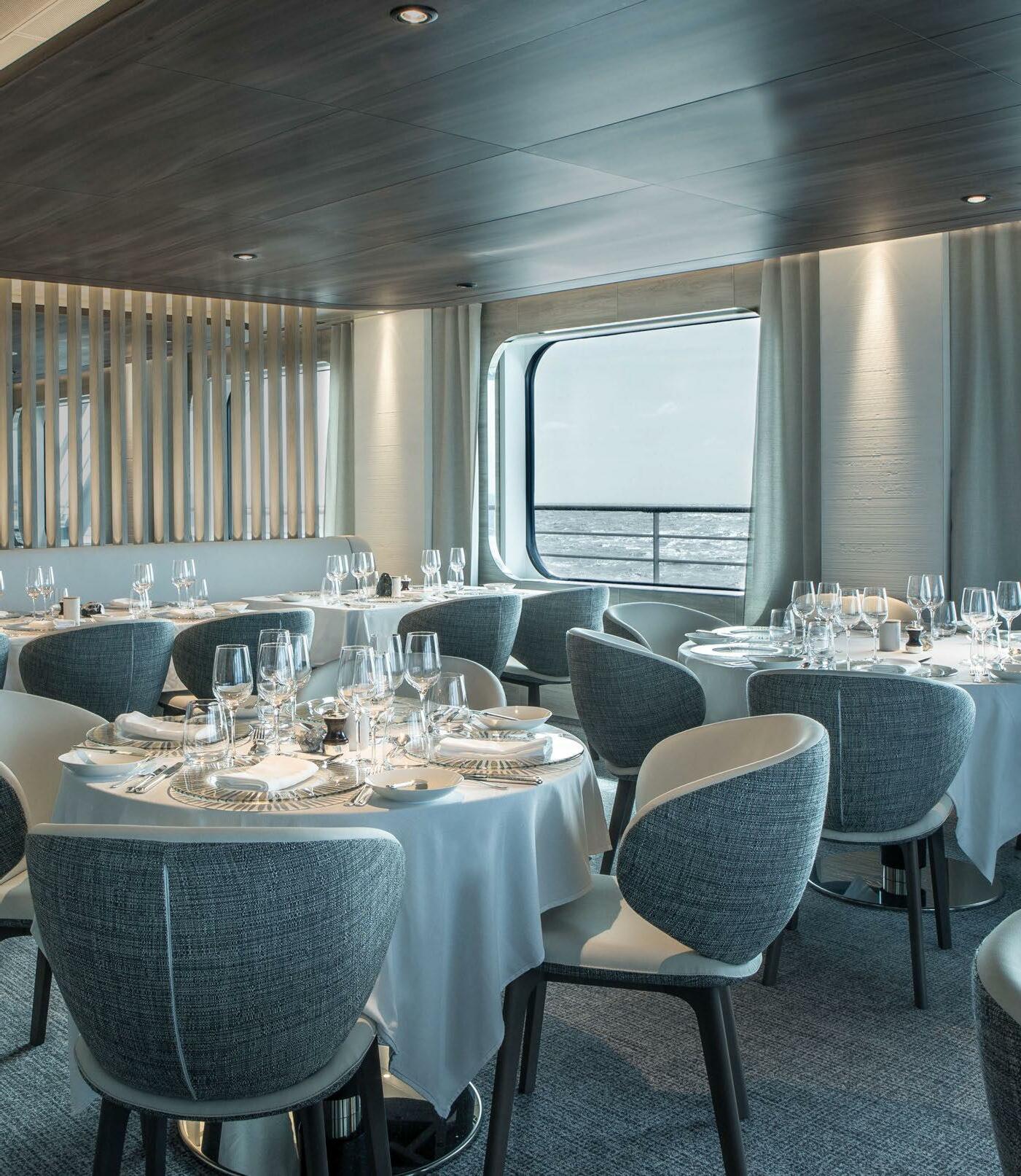 Fauteuil Soufflot –Studio Jean-Philippe Nuel / ©Gilles Trillard
Fauteuil Soufflot –Studio Jean-Philippe Nuel / ©Gilles Trillard